Noel-Jean Lerebours, 1761 - 1840
Noel-Marie Paymal Lerebours, 1807 - 1873
Marc (Marie François Louis) Secrétan, 1804 - 1867
Auguste-François Secrétan, 1833 - 1874
Georges-Emmanuel Secrétan, 1837 - 1906
Lerebours (1789 - 1845)
Lerebours and Secrétan (1845 - 1854)
Secrétan (1854 - ca. 1867)
Maison Lerebours et Secrétan / Maison Secrétan (ca. 1867 – well into the twentieth century)
by Brian Stevenson
last updated January, 2024
The Lerebours and Secrétan businesses of Paris were significant producers of optical apparatus throughout the nineteenth century. Lerebours introduced an “Achromatique Simplifié” (simplified achromatic) microscope in the late 1830s. Based on Benjamin Martin’s drum design, these high-quality instruments remained in production for several decades, and are the most frequently encountered Lerebours / Lerebours and Secrétan microscopes nowadays (Figures 1-2). Several other models of microscope were produced by the firms, probably in lower quantities (Figures 3-9).
Following his apprenticeship as an optician, Noel-Jean Lerebours worked for several years as a contractor, supplying lenses to various Parisian optical businesses. As his fame grew, Lerebours opened his own shop at 69 Quai de l'Horloge in 1789. A few years later, he moved down the street to Pont Neuf. N.-J. Lerebours earned numerous prizes for his work. He was appointed Optician to the Emperor and, later, Optician to the King, knighted Chevalier of the Légion d’Honneur, and as supplier to both the French Observatory and the Navy.
N.-J. Lerebours married in 1786. There are no records of children. However, he took Noel Paymal, the son of an unmarried woman, under his wing. The connection between N.-J. Lerebours and N. Paymal became more than simply employer-employee: in 1836, Lerebours formally adopted Paymal, Noel Paymal added the surname “Lerebours”, and N.-J. Lerebours designated N. Paymal Lerebours as his sole heir. When N.-J. Lerebours died in 1840, his adopted son continued the business.
N.P. Lerebours published an instructive book on the firm’s new “Achromatique Simplifié” microscope in 1839, followed by expanded editions in 1841 and 1846. He became an early expert in photography, and also wrote popular books on that subject. He the Lerebours business produced camera lenses of very high quality.
In 1845, N.P. Lerebours formed a partnership with Marc Secrétan, a Swiss mathematician and optical scientist. Secrétan had recently moved to Paris to study astronomy. The partnership of Lerebours and Secrétan ended with Lerebours’ retirement at the end of 1854.
By 1861, Secrétan hired his son, Auguste, to manage the business. Upon Marc Secrétan’s death in 1867, Auguste Secrétan inherited the business, now known as Maison de Secrétan (House of Secrétan). But Auguste did not live long, dying in 1874. A nephew of Marc Secrétan’s, Georges-Emmanuel Secrétan, was called upon by the family to continue the business.
Soon after the death of Georges Secrétan, in 1906, the business passed out of the family. Variously called “Maison Lerebours et Secrétan” and “Secrétan”, it continued well into the twentieth century under different owners.
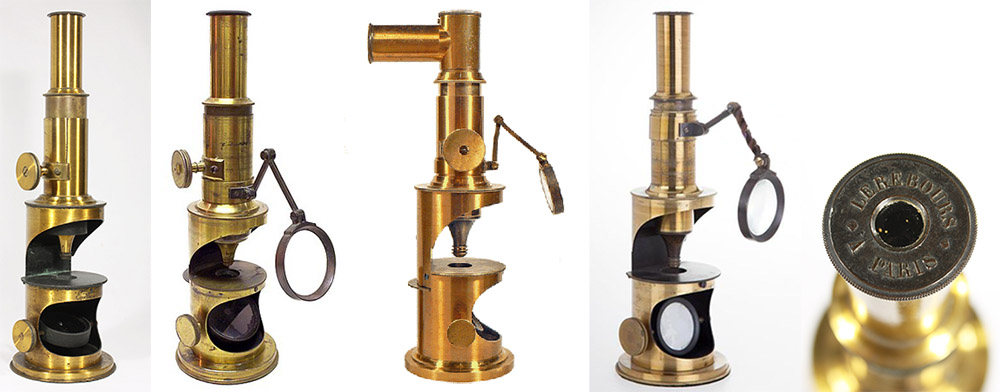
Figure 1A.
Examples of Lerebours’ “Achromatique Simplifié” microscopes. This design was available with or without a rack-and-pinion focus, and with or without an attached bull’s-eye condenser. A horizontal attachment was also available. All have a revolving ring of stops under the stage, adjustable from the rear of the instrument. Adapted by permission and/or for nonprofit, educational purposes from
http://www.antique-microscopes.com/photos/lerebours.htm,
http://www.lecompendium.com/dossier_optique_105_microscope_lerebours_et_secretan/microscope_lerebours_et_secretan.htm,
http://www.lecompendium.com/dossier_optique_29_microscope_simplifie_lerebours/microscope_lerebours_simplifie.htm,
and
http://www.museumsinisrael.gov.il/en/items/Pages/ItemCard.aspx?IdItem=ICMS-MTC-2754.
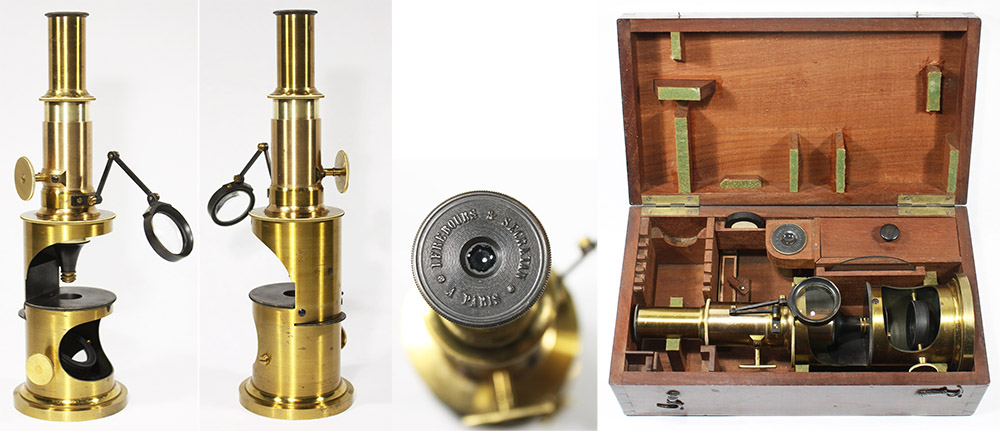
Figure 1B.
An “Achromatique Simplifié” microscope, with ocular lenses marked “Lerebours & Secrétan”, dating it to between 1845 and 1854.
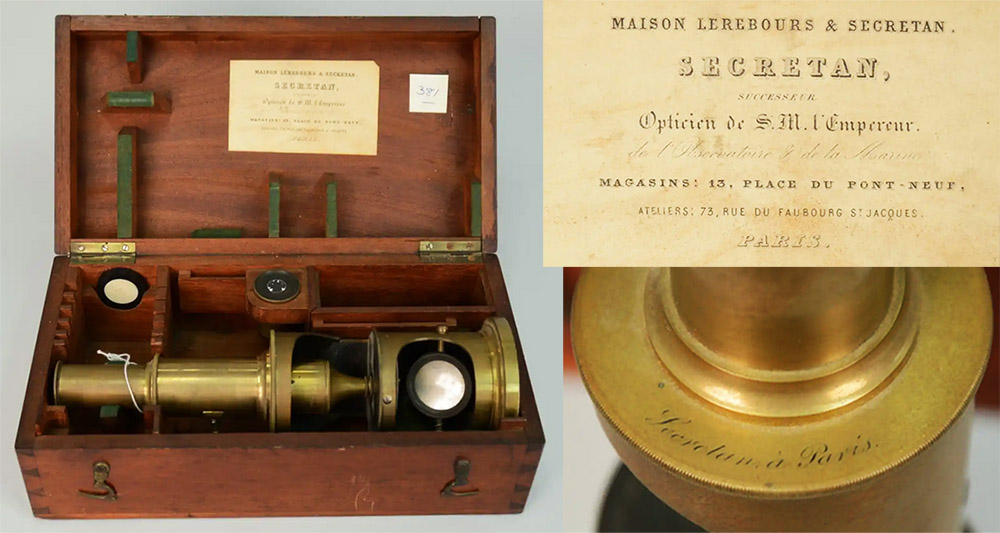
Figure 1C.
Another “Achromatique Simplifié” microscope, signed “Secrétan”, thereby dating its production to after 1855. The trade card, listing “Maison Lerebours and Secrétan”, implies sale after Marc Secrétan’s death (1867). Adapted for nonprofit, educational purposes from an internet auction site.
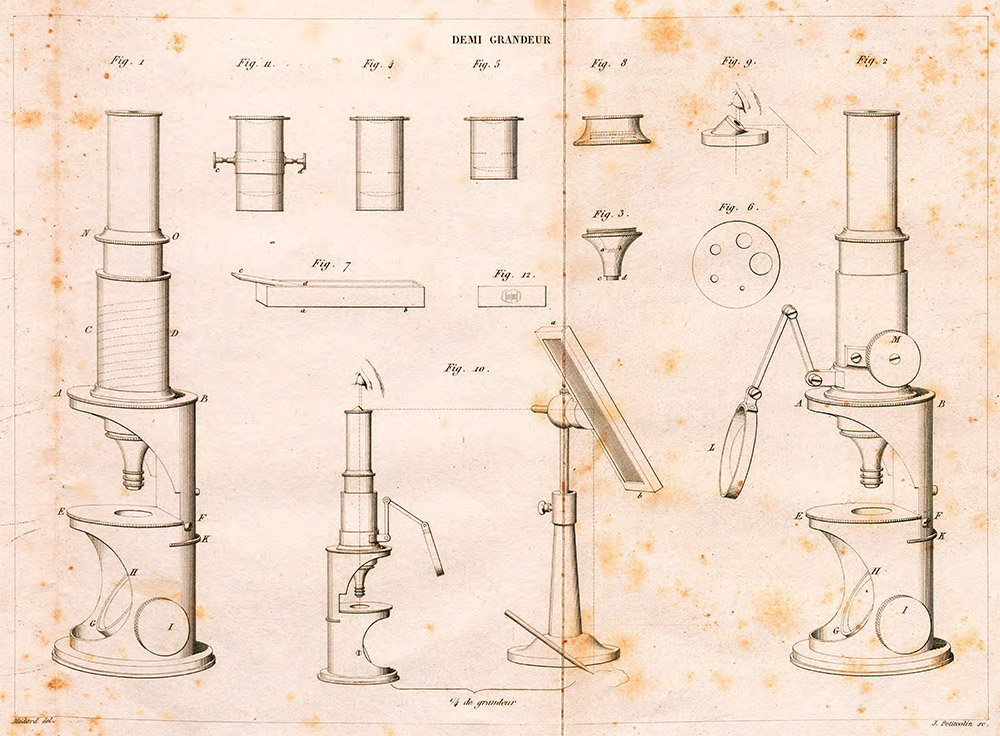
Figure 2.
Diagrams of Lerebours’ “Achromatique Simplifié” microscopes and components, from N.P. Lerebours’ “Description des Microscopes Achromatiques Simplifies”, Second Edition, ca. 1841.
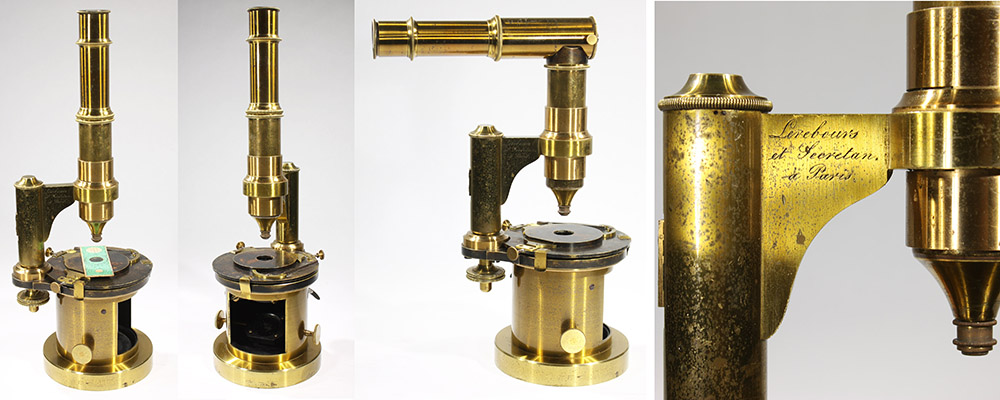
Figure 3.
Ca. 1846 "Microscope d’une Grande Dimension", by Lerebours and Secrétan. Their 1846 catalogue described this instrument: "the stage is equipped with a rotating movement which allows the specimen to be examined in all directions; double back-and-forth movement to center the specimen; three eyepieces, including one with a micrometer; prism to make the instrument horizontal; 3 sets of lenses, including one very strong; lighting by M. Dujardin, camera lucida, micrometer on glass, etc." (See Figure 20).
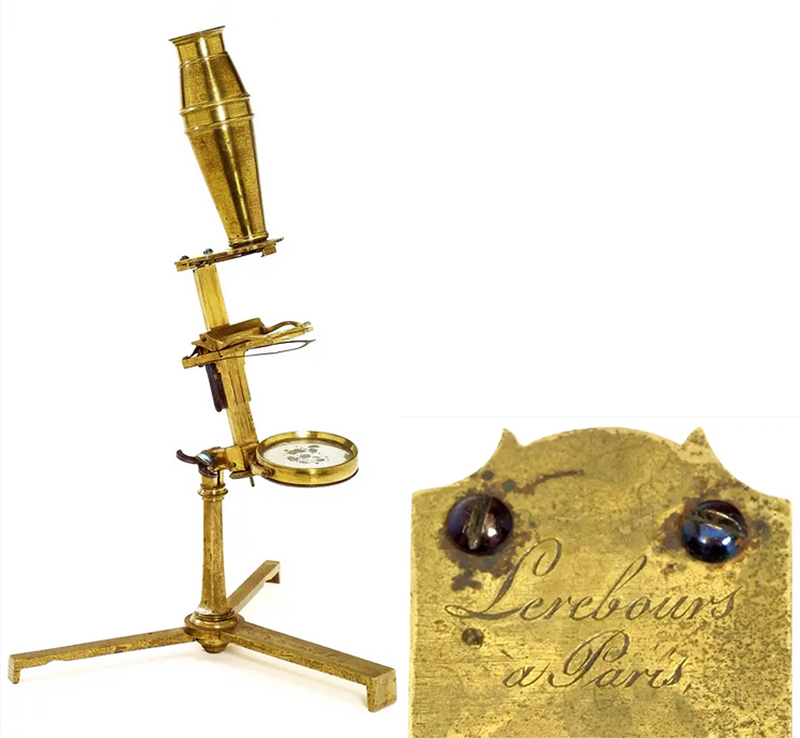
Figure 4A.
An early microscope, signed “Lerebours”. The design resembles the microscopes of Francis Watkins (1723 - 1791), and was probably made ca. 1790. Adapted for nonprofit, educational purposes from an internet auction site.
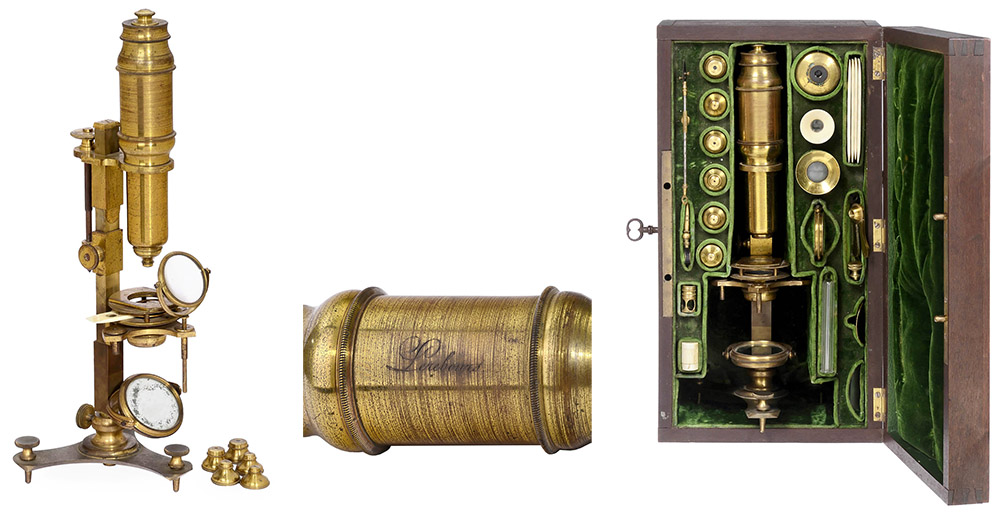
Figure 4B.
An early microscope by Lerebours, ca. 1800. Adapted for nonprofit, educational purposes from an internet auction site.
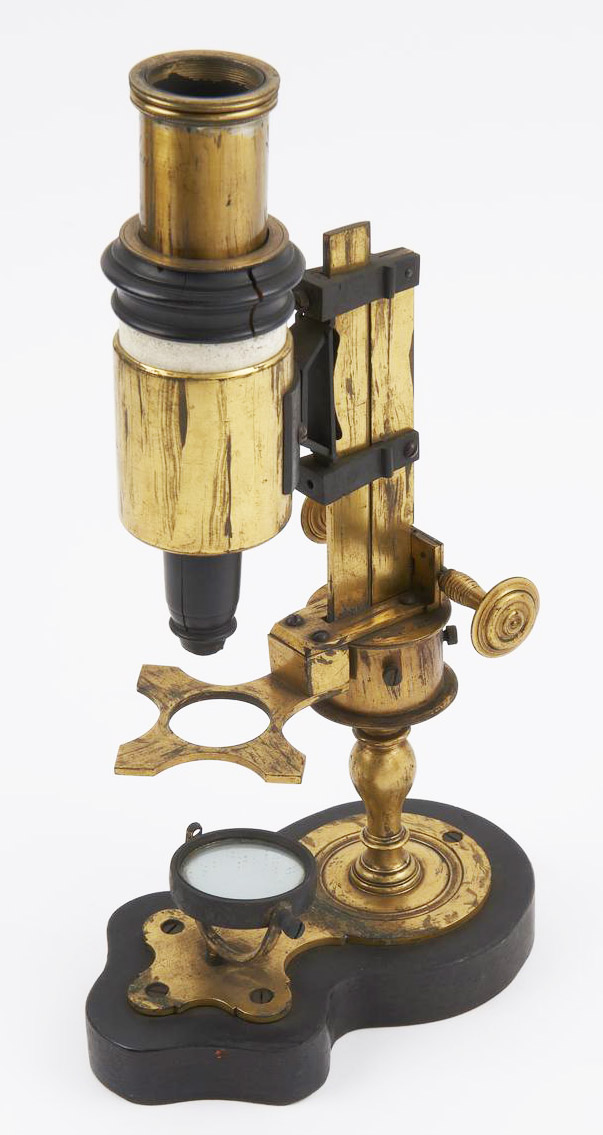
Figure 4C.
Another ca. 1800 microscope by Lerebours. Adapted for nonprofit, educational purposes from https://collection.sciencemuseumgroup.org.uk/objects/co8318/lerebours-compound-microscope-compound-microscope.
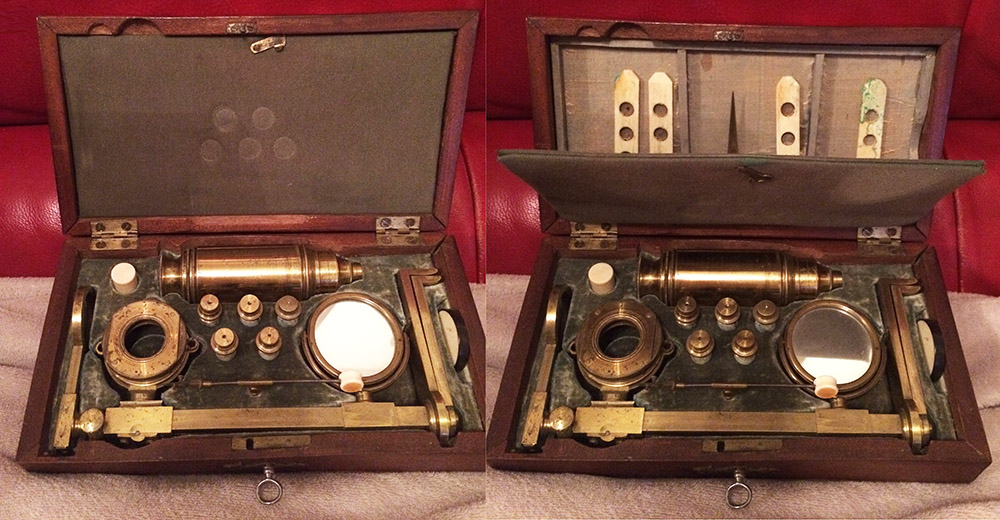
Figure 4D.
Lerebours microscope engraved with his address of 44 Quai de l’Horloge, indicating manufacture between ca. 1799 and 1803. Images adapted for nonprofit educational purposes.
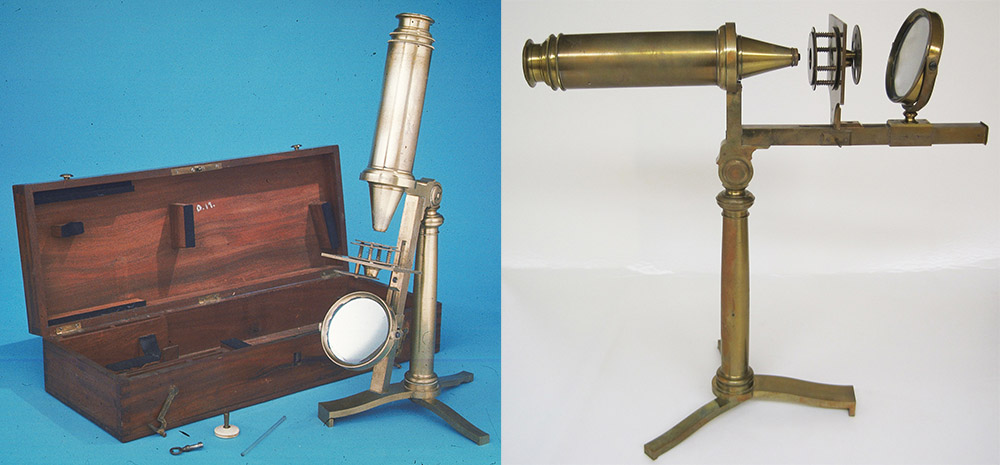
Figure 5A.
Circa 1829 compound microscope by N.-J. Lerebours. It was purchased in that year by the U.S. Military Academy. Adapted for nonprofit, educational purposes from https://americanhistory.si.edu/collections/search/object/nmah_728052.
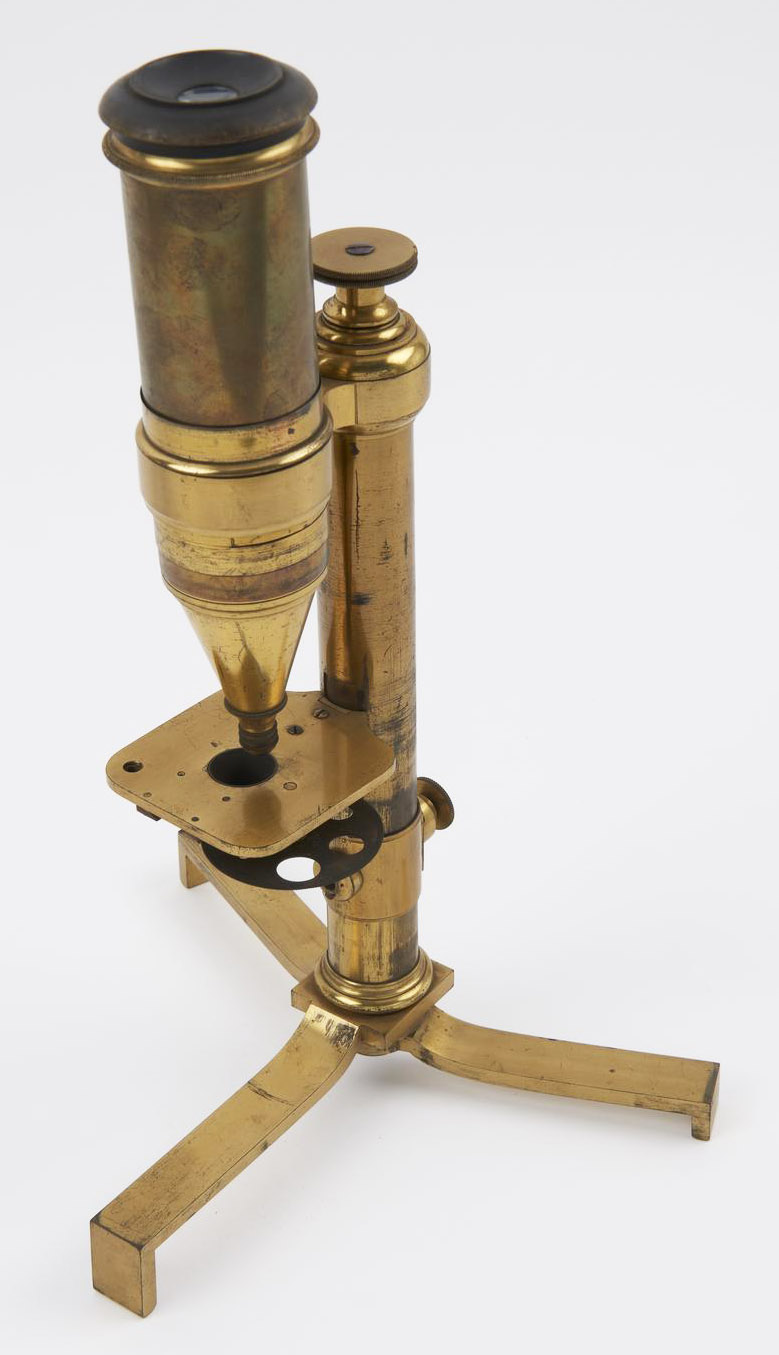
Figure 5B.
Achromatic microscope attributed to N.-J. Lerebours. Adapted for nonprofit, educational purposes from https://collection.sciencemuseum.org.uk/objects/co8157/early-french-microscope-probably-by-lerebours-tr.
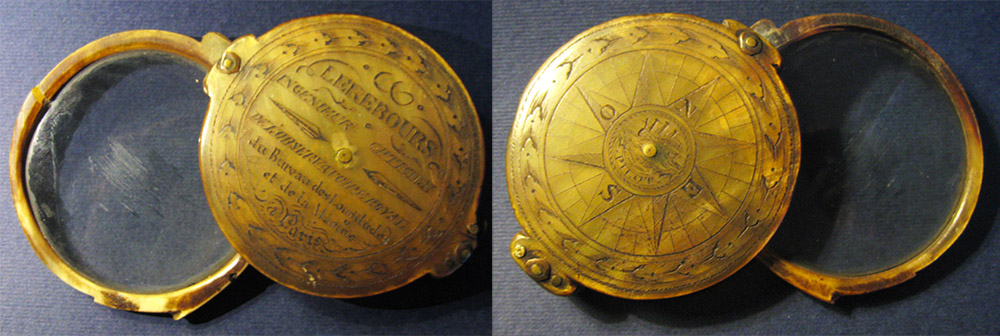
Figure 6.
A hand-held magnifier made of horn, by N.-J. Lerebours. He began advertising that he was Optician to the Emperor in 1804, a title that is lacking from this instrument, implying production prior to that date. Adapted for nonprofit, educational purposes from an internet sale site.
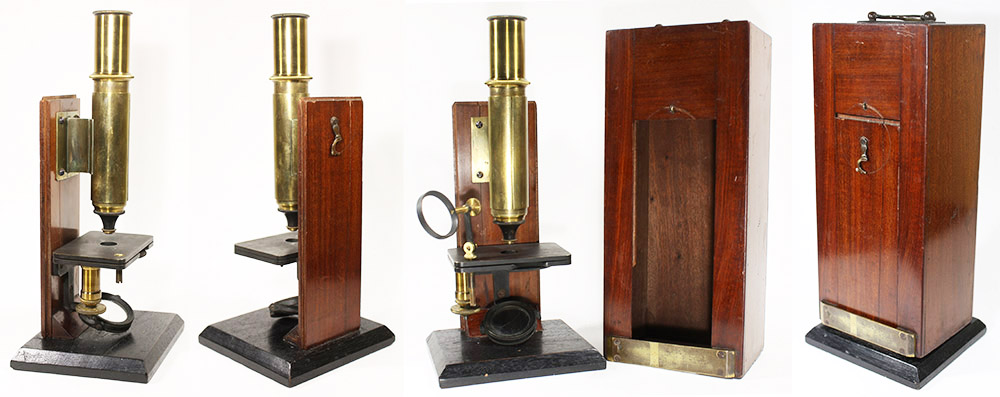
Figure 7.
“Nouveau Microscope d’Amphithéâtre”, circa 1853. The body and stage are mounted on a vertical slab of wood. The cabinet slides into position on dovetails with the vertical slab. Coarse focus by manually drawing the body tube up and down, fine focus by a micrometer thumbscrew that adjusts the height of the stage.
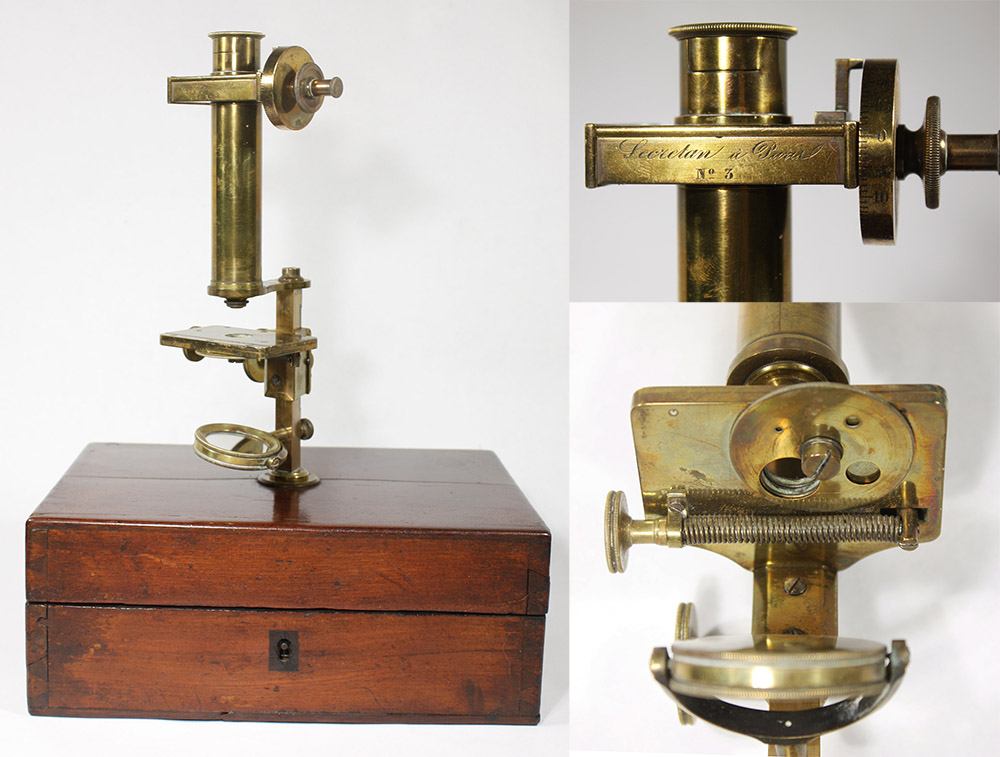
Figure 8.
A microscope by Secrétan, inscribed on the limb and the micrometer with “No. 3”. It was evidently produced for precise measurements, with an adjustable micrometer in the body tube and a fine mechanism that adjusts the stage position along one axis.
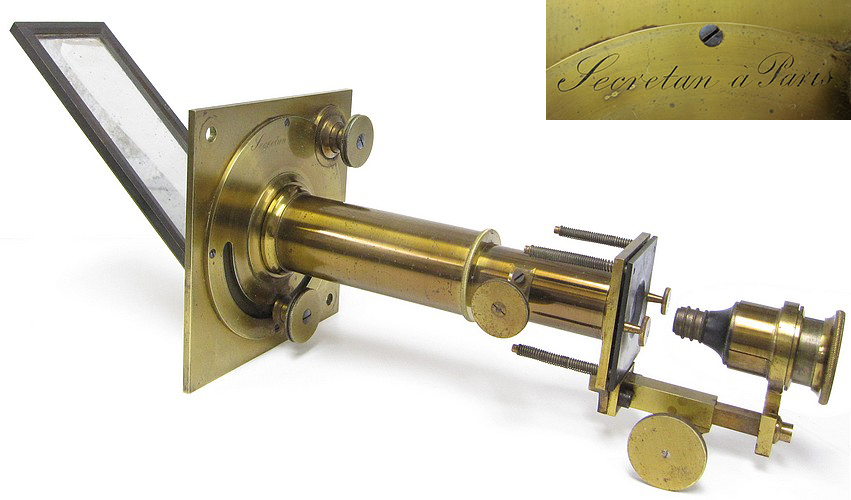
Figure 9A.
A Secrétan solar microscope. The signature dates its production to between 1855 and 1867. Adapted by permission from http://www.antique-microscopes.com/photos/Secretan_solar_microscope.htm.
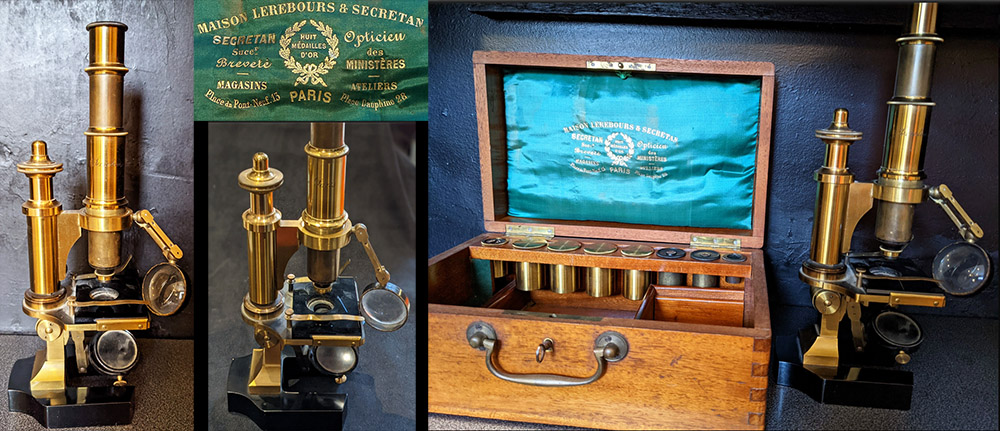
Figure 9B.
A compound microscope from "Maison Lerebours et Secrétan", dating to after Marc Secretan's 1867 death - judging from the style, it was probably produced in the 1880s or later. The printing states that the maker had earned 8 Gold Medals at the time. Adapted for nonprofit, educational purposes from an internet auction site.
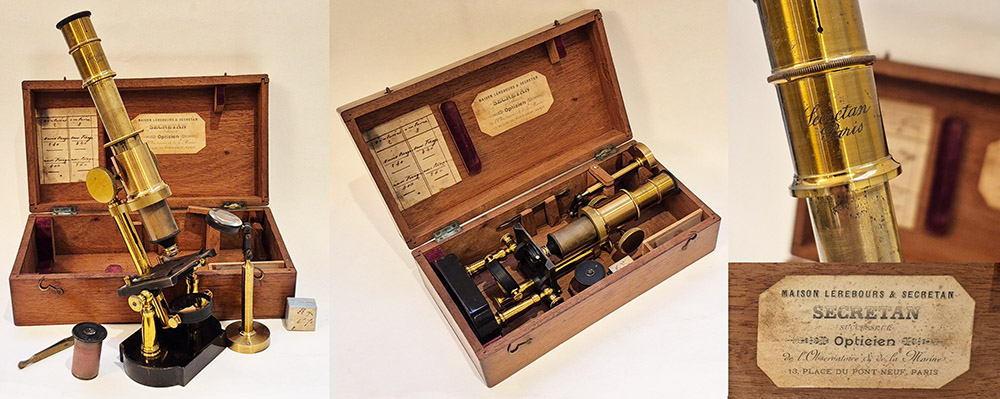
Figure 9C.
This compound microscope is engraved "Secretan", and the case has a label from "Maison Lerebours & Secrétan, Secrétan Successeur". It probably dates from the late 1800s. Numerous "dual-column" microscopes identical to this one are known, many are unsigned and many bear the names of other retailers - see this page for a discussion. It is possible that of this form was produced by Maison Lerebours & Secrétan, although I consider it just as likely that another manufacturer built these for the wholesale trade, and that Maison Lerebours & Secrétan was just the retailer. Adapted for nonprofit, educational purposes from an internet auction site.
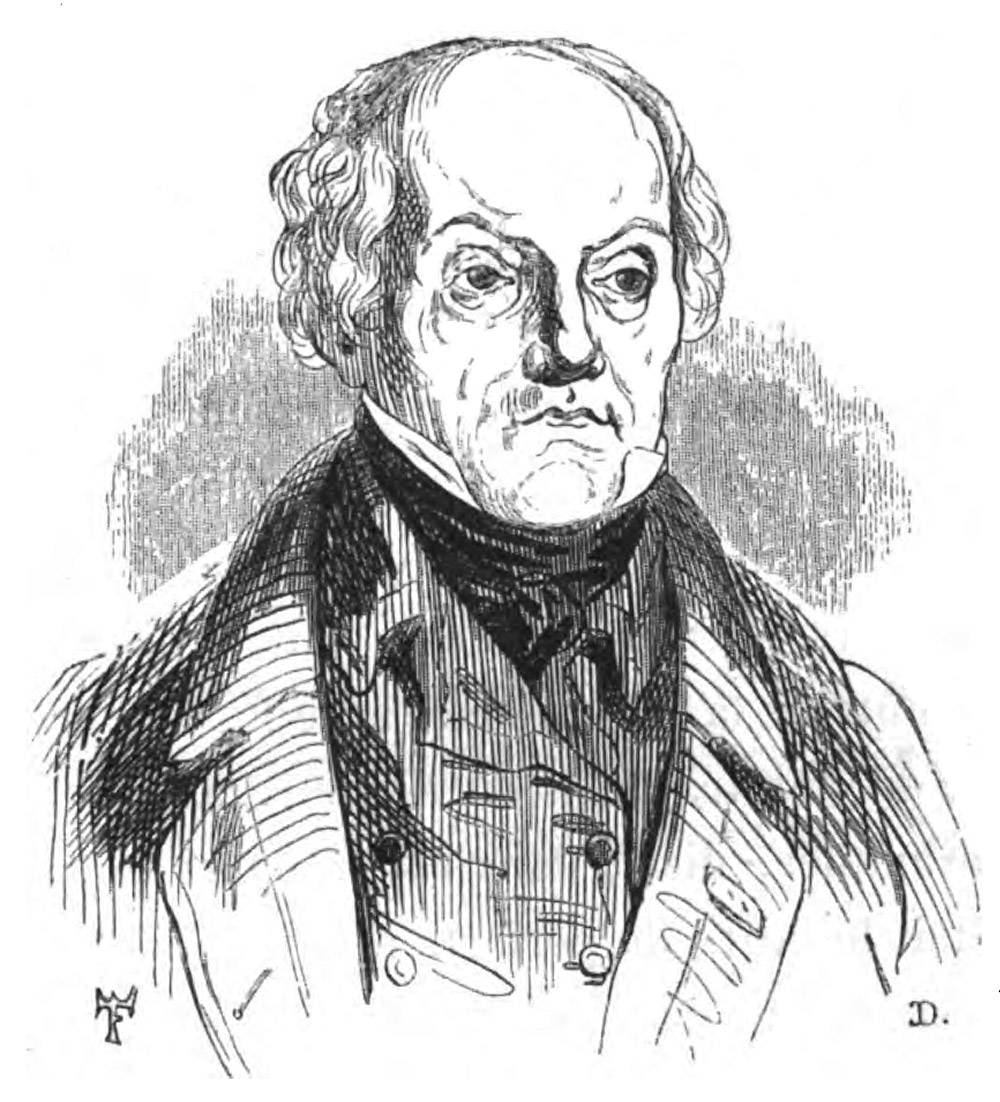
Figure 10.
Noel-Jean Lerebours. From “Les Artisans Illustres” by Eduard Foucaud, 1841.
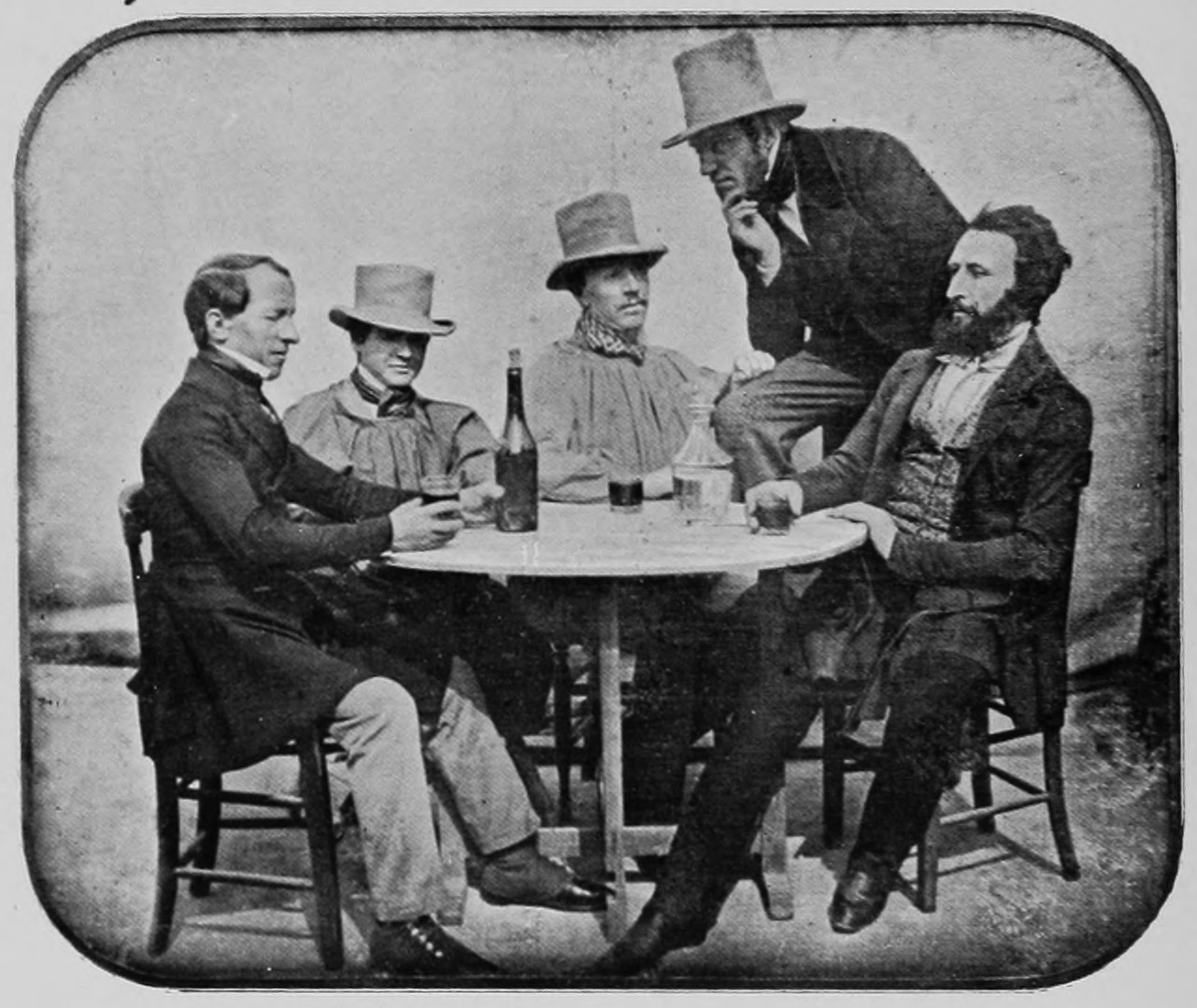
Figure 11.
An 1844 daguerreotype photograph of Noel Paymal Lerebours (far left). Left to right, the photograph also includes two unidentified men (their smocks suggest that they are workmen), Frederic Martens (1806-1885, inventor of the panoramic camera), and Marc-Antoine Gaudin (1804-1880, a very early daguerreotypist, and Lerebours’ photography partner).
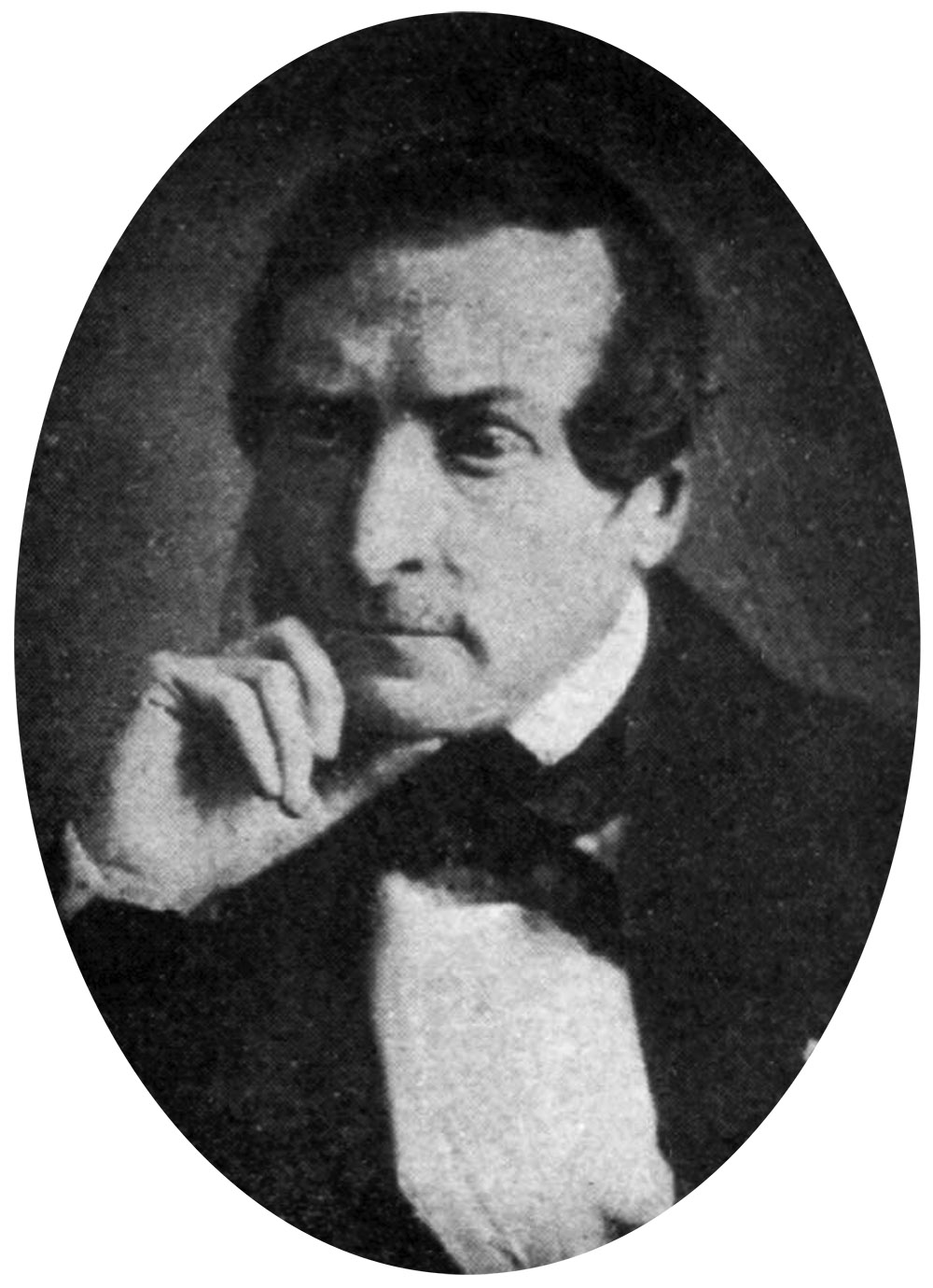
Figure 12.
An undated photograph of Marc Secrétan.
Noel-Jean Lerebours was born on December 25, 1761, in Mortain, a town in the Manche department of Normandy. He was a son of Julien and Françoise Sulfré Lerebours.
Noel-Jean was sent to Paris when twelve years old, as an apprentice to a glassmaker. After a while, he decided that glassmaking was not his future, and instead found work with an optical worker named Louvel. At eighteen (about 1779), Lerebours left Louvel, puchased his own tools, and began freelance work for opticians about town. The Biographie Universelle writes that this period was one of extensive work hours, very little sleep, and bouts of illness from the stress. Nonetheless, he persevered and produced work that was highly regarded. Circa 1887, an 81mm objective lens was declared by the astronomers J.D. Cassini and Pierre Méchain to be superior to anything previously made in France.
Buoyed by his successes, Noel-Jean married Marie-Marthe Legay in August, 1786. He opened a shop at 69 Quai de l'Horloge in 1789. Coincidentally, that site was later occupied by microscope-makers Victor and Charles Chevalier.
Lerebours left his first space in 1793. He had two shops by 1799, at 44 Quai de l’Horloge and Galerie de Pierre in the Palais Egalité. He maintained two spaces for some time, the Quai de l’Horloge site probably being a combined manufacturing and retail facility, while the other was likely just a saleroom. Between 1803 and 1804, Lerebours moved to the western end of Quai de l’Horloge, and established a single shop on the corner at 13 Pont Neuf. This site fronts onto the Pont Neuf Bridge, a busy thoroughfare that connects both banks of the Seine River and the île de la Cité, and would have been an excellent location for exposure to customers. The business remained there until after the turn of the twentieth century.
In 1804, Lerebours was appointed “Opticien de l’Empereur”.
A booklet on the care of eyeglasses was published by Lerebours in 1805 (Figure 13). This helpful information would have been widely appreciated, while also serving as advertisement that Lerebours prepared eyeglasses.
N.-J. Lerebours won a succession of top awards at French industrial expositions: he earned Gold Medals in 1819, 1823, 1827, 1834, 1839, and 1844. The 1823 jury report stated “Rien de plus parfait n'est certainement sorti des ateliers d'aucun opticien” (“Nothing more perfect has come out of the workshops of any optician”). An Amici-type microscope by Lerebours was lauded, “microscope composé suivant le système du docteur Amici, dont l'instrument a été examiné en France et en Angleterre par les savants les plus distingués, et reconnu infiniment supérieur à tout ce qui avait été fait jusqu'à ce jours il peut supporter un grossissement de deux mille trois cents fois” (“a compound microscope according to the system of Dr. Amici, this instrument was examined by the most distinguished scholars in France and England, and was recognized as being infinitely superior to all that had been done up to the day, it manages a magnification of two thousand and three hundred times”).
N.-J. Lerebours’ wife died on June 19, 1829. As noted above, the couple did not have any children, or, if they did, none were were involved with the optical and scientific business. But a young employee of Lerebours’ had become a valued colleague, and would later inherit the business.
Noel-Marie Paymal was born in Paris on February 16, 1807. His mother, Marie Jeanne Françoise Paymal, was unmarried, and the identity of her son’s father has never been revealed. Some modern writers allege that N.-J. Lerebours later married Mlle. Paymal, but I have not found any contemporary records to support that notion. Since Lerebour’s wife did not die until 1829, if such a marriage did occur, it could not have happened until Noel Paymal was over 22 years old.
On March 5, 1836, N.-J. Lerebours named Noel Paymal as his sole heir, “Testament authentique de Jean Noël Lerebours dicté en l'étude de Me Henri Agasse. À signaler: le testataire institue comme légataire universel Noël Marie dit Lerebours, né de Jeanne Françoise Paymal, le 17 (sic) février 1807 à Paris 1er anc. arrondissement”.
On June 11, 1836, Noel-Jean Lerebours formally adopted Noël Paymal as his legal son. Shortly afterward, in July, 1836, Paymal legally changed his surname to Lerebours: “Par requête adressée à M. le garde des sceaux, M. Noël-Marie Paymal, majeur, opticien, demeur ne place du Pont-Neuf, n. 13, à Paris, est authorisé à joindre à son nom celai de Lerebours”.
The first edition of Description des Microscopes Achromatiques Simplifies, describing the Lerebours’ achromatic drum-style microscope (Figures 1 and 2), was published in January, 1839. Noel Paymal Lerebours was credited as the sole author.
Noel-Jean Lerebours died on February 12, 1840. His entry in the 1854 Biographie Universelle noted that he had not produced any written works during his life.
The adoption of Noel Paymal Lerebours was finalized on April 24, 1840: “Dépôt des pièces constatant l'accomplissement des formalités de l'adoption de Noël Marie Paymal Lerebours, opticien, demeurant 13, place du Pont-Neuf, par Jean Noël Lerebours, en son vivant opticien. Notoriété après décès de Jean Noël Lerebours survenu en son domicile 13, place du Pont-Neuf, le 12 février 1840. À signaler: le défunt a institué pour son légataire universel et seul et unique héritier son fils adoptif Noël Marie Paymal” (Filing of documents verifying the completion of the formalities of the adoption of Noel Marie Paymal Lerebours, optician, residing at 13 Place du Pont-Neuf, by Jean Noël Lerebours, in his lifetime optician. Jean Noel Lerebours is known to have died at his home, 13 place du Pont-Neuf, on February 12, 1840. Note: the deceased instituted his adopted son Noël Marie Paymal as his sole legatee and sole heir”).
N.-J. Lerebours will also included bequests to four unknown individuals, possibly servants or other employees, “Sophie Tamboureur, épouse de Pierre Darney, Marguerite Guillot, Claude Marie Thézard et Gabriel Henry Barthélemy”.
A second edition of Description des Microscopes Achromatiques Simplifies was published ca. 1841. The printing date was not stated, but the book includes a footnote reference to an 1841 microscope book by Andrew Pritchard, and an 1840 Lerebours catalogue (Figure 14).
N.P. Lerebours was an early practitioner of photography, and recognized its commercial potential. In the late 1830s – early 1840s, he sent out photographers to take daguerreotypes around France and various parts of the world. These photographs served as templates to produce prints, which were bound into volumes entitled Excursions Daguerriennes (Figure 15). These books presented images of the world that were more accurate than could be achieved by freehand drawings and paintings, and became very popular.
A large number of Lerebours’ business records are freely available through www.siv.archives-nationales.culture.gouv.fr, which reveal that both N.-J. and N.P. Lerebours made substantial investments in real estate. N.P. leveraged his father’s properties to purchase additional land and buildings. Through those means, they gained wealth far beyond what could have be acquired simply from making and selling scientific instruments. A typical example from March 10, 1842, “Obligation par Noël Marie Paymal Lerebours, opticien, demeurant 13, place du Pont-Neuf, au profit du baron Jean Charles François de La Doucette, demeurant 7, rue Saint-Lazare, pour prêt d'une somme de 9 000 francs remboursable le 10 mars 1846, accompagné d'un taux de 5% l'an, payable par semestre. Le contractant hypothèque, pour sûreté de garantie, trois maisons qui proviennent de la succession de son père”. (“Obligation by Noël Marie Paymal Lerebours, optician, residing at 13, place du Pont-Neuf, for the benefit of Baron Jean Charles François de La Doucette, residing at 7, rue Saint-Lazare, for loan of 9,000 francs repayable on 10 March 1846, accompanied by a rate of 5% per annum, payable per semester. The contractor shall mortgage, for security interest, three houses which come from his father's estate”).
In 1843, Lerebours published a book of instructions on photographic methods, Traite de Photographie, and a book on electroplating, Traité de Galvanoplastie. Mini-catalogues of Lerebours’ microscopes were bound into the rear of both books (Figure 16). An English translation, A Treatise on Photography, was published in London that same year.
Also in 1843, he published a French translation of Andrew Pritchard’s 1832 Microscopic Cabinet (Figure 17)
On February 15, 1845, N.P. Lerebours formed a partnership with Marc Secrétan, a Swiss mathematician and astronomer, who had come to Paris to further his studies.
Marie Louis Francois (Marc) Secrétan, was born in Lausanne, Switzerland in 1804. He initially trained as a lawyer, and practiced for some time. But he also had an interest in mathematics, which he developed ot the point of becoming “Capitaine du génie pour le Canton de Vaud” in 1834 (“Captain of engineering for the Canton of Vaud”). He was appointed Professor of Mathematics at the Académie de Lausanne in 1838. He moved to Paris in 1844, as noted above.
The new firm, Lerebours and Secrétan, published a third edition of Lerebours’ book on microscopy in 1846, Instruction Pratique Sur Les Microscopes, Contenant La Description Des Microscopes Achromatiques Simplifies. This edition was expanded to include descriptions of several forms of their microscopes, plus a substantial amount of general information on micrsocopy (Figure 18).
Noel Paymal Lerebours was married on July 11, 1850, to Renée Madeleine Colas. She was a widow, with several children. Lerebours had not previously married, and was then 43 years old. An archive of his marriage arrangements includes information on the Lerebours and Secrétan business: “Contrat de mariage sous le régime de la communauté de biens entre Noël Marie Paymal Lerebours, opticien, demeurant 13, place du Pont-Neuf, et Renée Madeleine Colas, veuve de Louis Étienne Remiot, demeurant 47, rue Vivienne. À signaler : le futur apporte en mariage la moitié de ses droits dans une société créée par acte sous seing privé le 15 février 1845 entre lui-même et Marie François Louis dit Marc Secrétan pour la fabrication et le commerce d'instruments d'optique située 13, place du Pont-Neuf. Cette société est estimée, à la date du mariage, à 220 000 francs”. (“Marriage contract under the community of property between Noël Marie Paymal Lerebours, optician, residing at 13 Place du Pont-Neuf, and Renée Madeleine Colas, widow of Louis Étienne Remiot, residing at 47, rue Vivienne. Note: the future brings in marriage half of its rights in a company created by private deed on February 15, 1845 between himself and Marie François Louis,known as Marc, Secrétan for the manufacture and trade of optical instruments located 13, Place du Pont-Neuf. This company is estimated at the date of the marriage at 220,000 Francs”.).
Lerebours continued to acquire and sell property throughout Paris. On January 22, 1853, he aquired a plot on “rue Newton, quartier des Champs-Élysées”, which was adjacent to a plot on which he built two small hotels. Lerebours and his family then moved into the Rue Newton house. He sold one of the hotels in 1856 for 65,000 Francs.
It was probably those investments that allowed Noel Paymal Lerebours to retire from the optical business when only 47 years old, in 1854, “21 Décembre 1854. Procuration par Noël Marie Paymal Lerebours, opticien, demeurant 13, place du Pont-Neuf, à Marie François Louis dit Marc Secrétan, opticien, demeurant même adresse, pour recevoir toutes sommes, notamment de la ville de Paris ou de l'Observatoire de Paris, dans la société de commerce aujourd'hui dissoute, Lerebours & Secrétan, pour fourniture d'instruments d'optique ou de précision. Régler et arrêter les comptes, retirer tous mandats, effectuer des remises et autres délais, donner quittances, tenir registres, acquitter toutes factures, signer tous autres effets”. (“December 21, 1854 Procuration by Noël Marie Paymal Lerebours, optician, residing at 13 Place du Pont-Neuf, to Marie François Louis said Marc Secrétan, optician, residing at the same address, to receive all sums, notably from the city of Paris or from the Paris Observatory, in today's dissolved trading company, Lerebours & Secrétan, for the supply of optical or precision instruments. To settle and stop the accounts, to withdraw all orders, to carry out discounts and other delays, to give receipts, to keep registers, to pay all bills, to sign all other effects”).
Thus, the firm of Lerebours and Secrétan lasted from February, 1845, until December, 1854. Thereafter, it was simply “Secrétan”.
The new firm won a Medal First Class and a Medal of Honor at the 1855 Paris Universal Exhibition.
Marc Secrétan married twice. His first wife, Suzanne Louise Mercier, was also from Lausanne, Switzerland. They had six children. The dates of the first marriage, and of Suzanne’s death, are not known. He married Lazarette Moncharmont on December 29, 1858.
Beginning in at least June, 1861, Secrétan employed his son, Auguste, to be manager of the Pont-Neuf optical works and shop.
Marc Secrétan may have moved to Switzerland in conjunction with Auguste’s taking over the business management. An 1867 record of the settlement of his will implies that he was in Switzerland at the time of his death, and that his wife was a resident of Lausanne, “29 juillet, 1867. Inventaire après décès de Marie François Louis dit Marc Secrétan, dressé entre le 29 juillet 1867 et le 21 février 1868, dans la maison située 13, place du Pont-Neuf et à Lausanne (Suisse), où le défunt est mort, le 28 juin 1867, lui-même domicilié en cette même ville, à la requête de sa veuve, Lazarette Moncharmont, demeurant à Lauzanne, et de leurs enfants, Emilie, épouse Bauvard, Fanny, épouse de Ferdinand Cérésole, Emma, épouse de Paul Cérésole, Sophie, épouse de Charles Mercier, Théodore Secrétan, interdit, représenté par son tuteur Charles Carrard, et Auguste François Secrétan, opticien, 13, place du Pont-Neuf, demeurant 10, rue Jacob”. (“Inventory after the death of Marie François Louis, known as Marc, Secrétan,compiled between July 29, 1867 and February 21, 1868, in his house located at 13, Place du Pont-Neuf and Lausanne (Switzerland), where the deceased died, June 28 1867, himself a resident of the same city, at the request of his widow, Lazarette Moncharmont, living in Lauzanne, and their children, Emilie, wife of Bauvard, Fanny, wife of Ferdinand Cérésole, Emma, wife of Paul Cérésole, Sophie, wife of Charles Mercier, Théodore Secrétan, minor, represented by his tutor Charles Carrard, and Auguste François Secrétan, optician, 13, place du Pont-Neuf, residing at 10, rue Jacob”). Auguste Secrétan assumed control of the Paris optical business, and it became known as Maison Lerebours et Secrétan.
Noel Paymal Lerebours died on July 23, 1874, at his home in Neuilly-sur-Siene (a suburb of Paris). He had acquired that land in 1859. Records of the resolution of his estate noted, “le défunt ne laisse aucun héritier ni ascendants ni descendants” (“the deceased leaves no heirs nor ascendants nor descendants”).
Auguste Secrétan also died in 1874. His cousin, Georges Secrétan, then a teacher in Lausanne, was convinced by the family to take control of Maison Lerebours et Secrétan. By all accounts, he was a splendid manager and scientist. Among other things, Georges was a founding member of the Société Astronomique de France, in 1887. Georges Secrétan died on October 10, 1906.
His son, Paul-Victor Secrétan inherited the optical business, but it soon passed out of the family to Charles Epry. The name Secrétan continued to be used for that and other businesses for several decades.
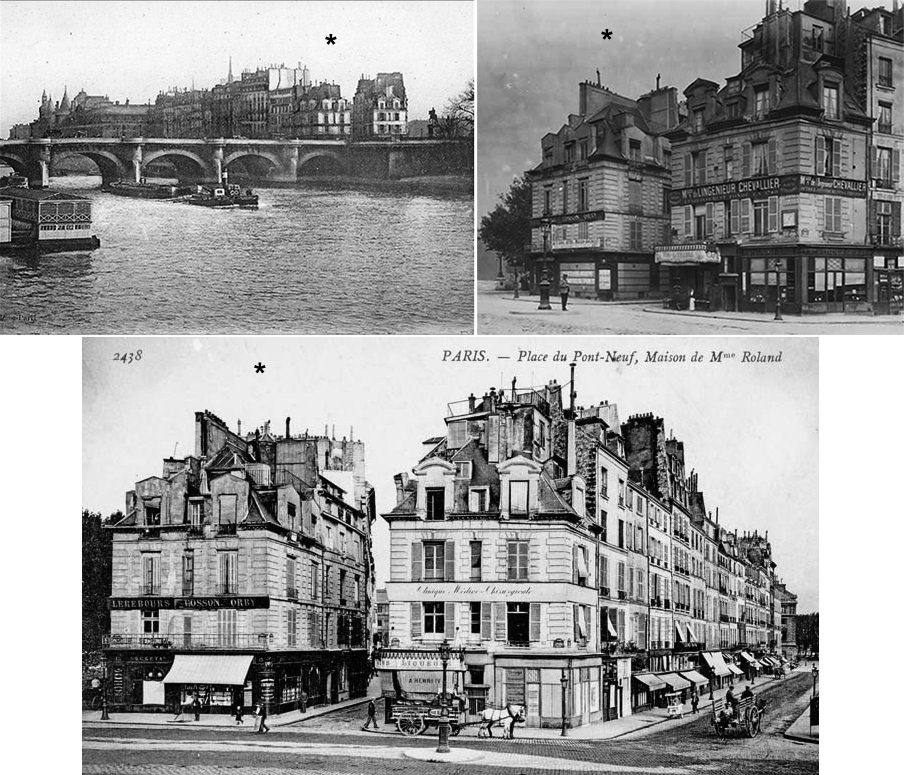
Figure 13.
Pictures of Pont-Neuf Bridge and the fronting businesses, circa 1900-1910. Number 13, the site of "Lerebours", "Lerebours & Secrétan", "Secrétan", and "Maison Lerebours & Secrétan"is located on the left, with an asterisk above the building. Quai de l’Horloge is located around the corner to the left of number 13. The other building on Pont-Neuf was occupied by the competing Chevallier optical businesses from 1845 until 1900.
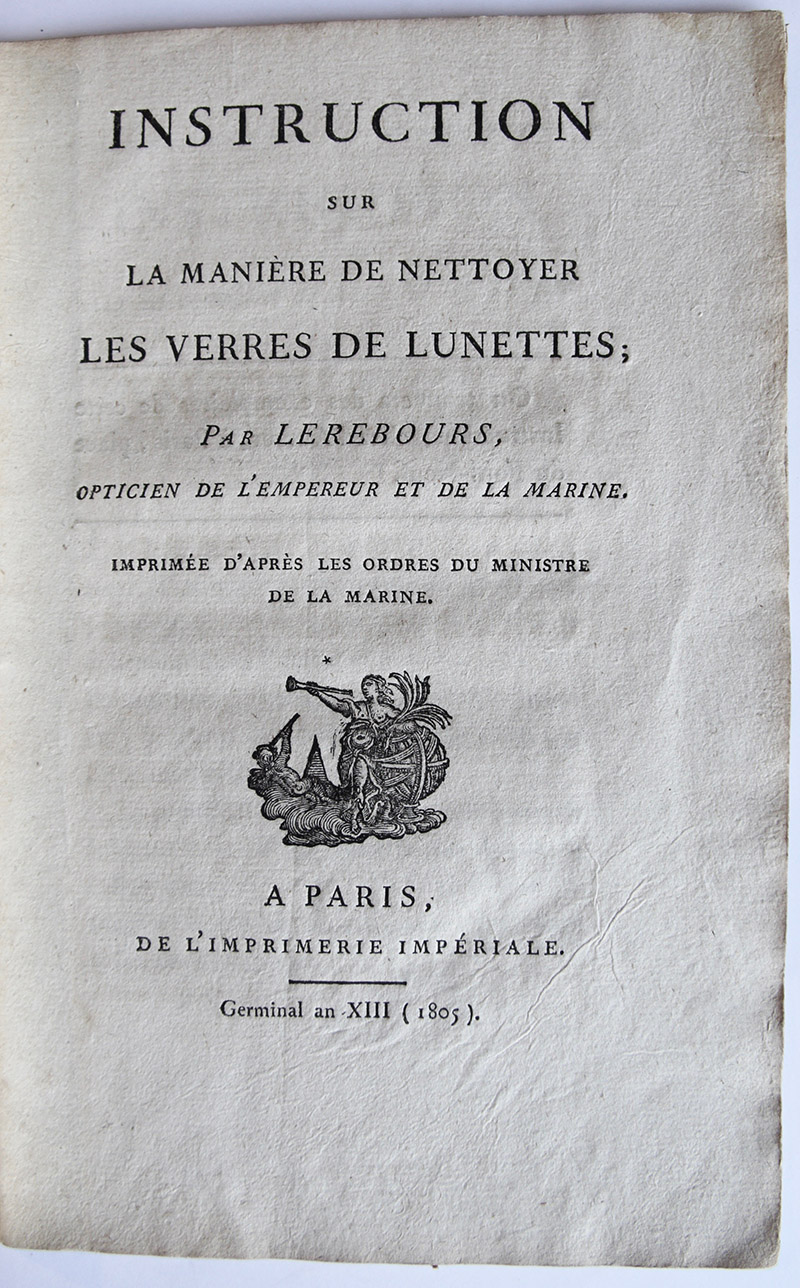
Figure 14.
Title page to N.-J. Lerebours’ 1805 “Instruction sur la manière de nettoyer les verres de lunettes” (Instructions on how to clean the glass of spectacles).
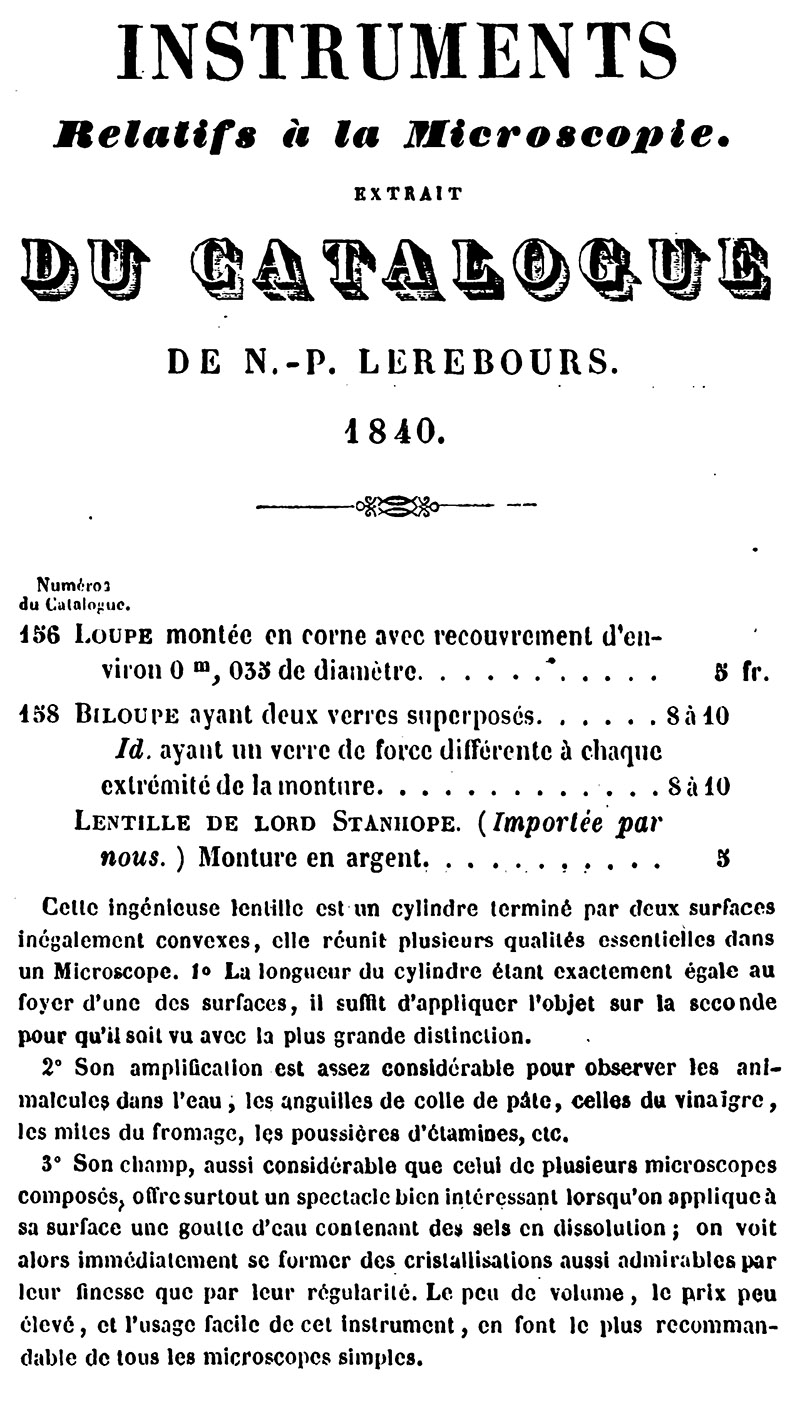

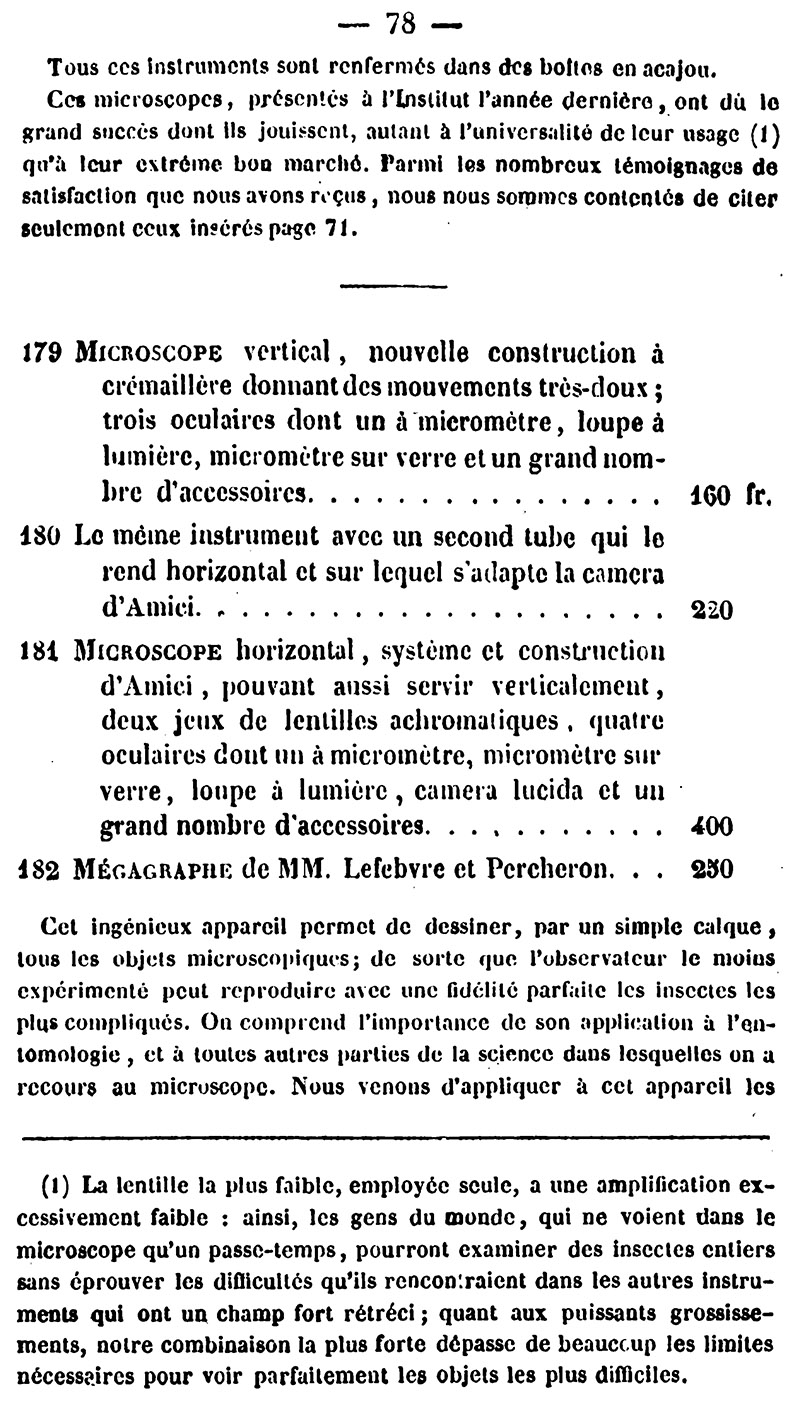
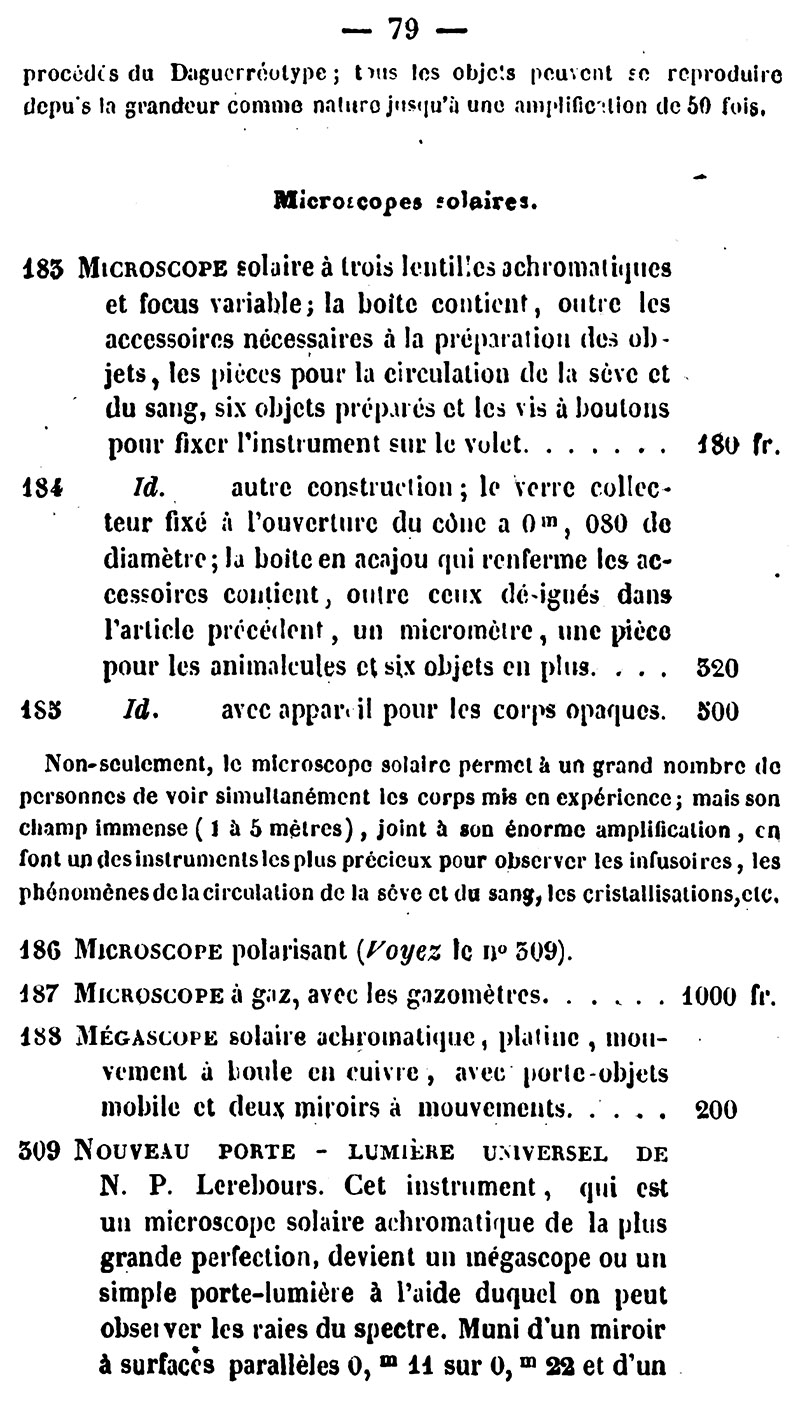
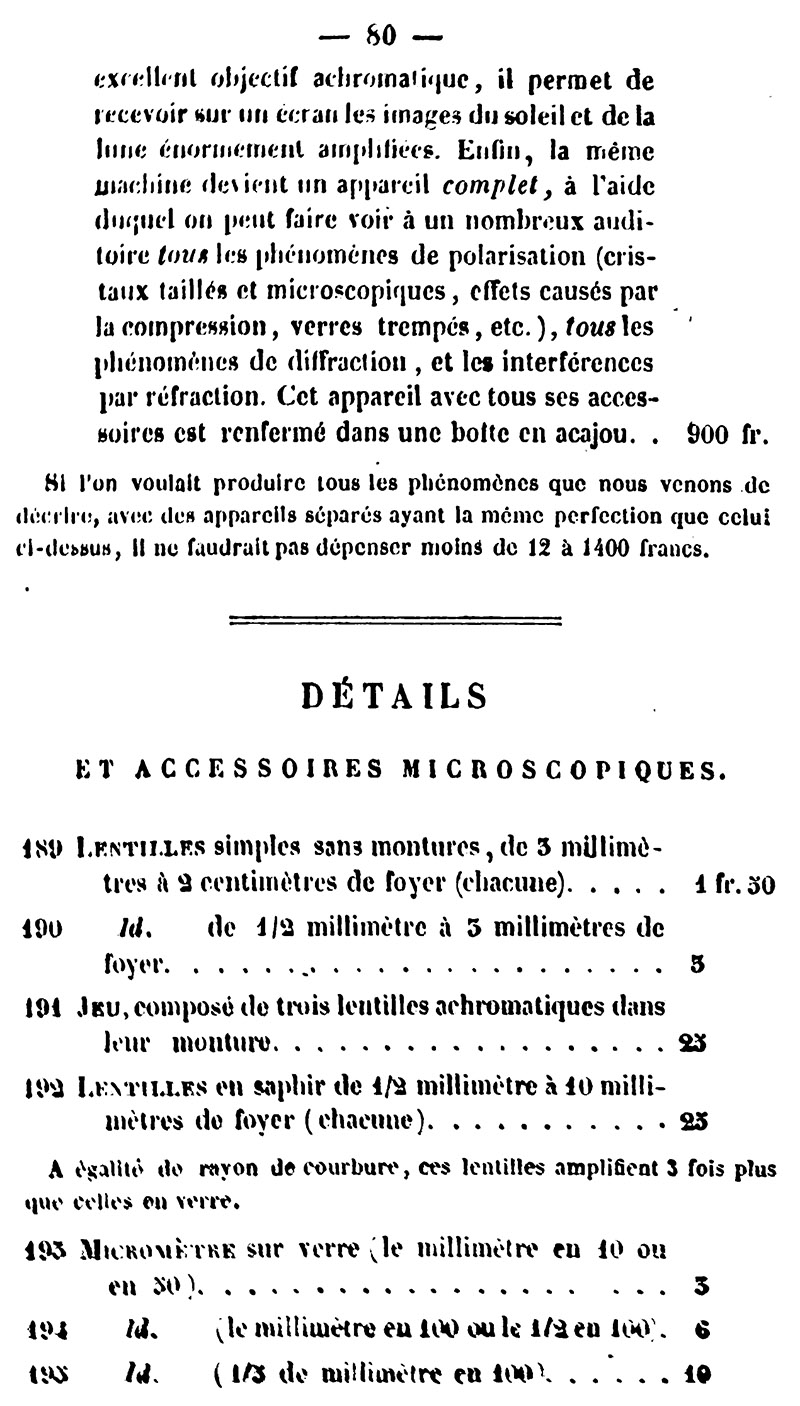
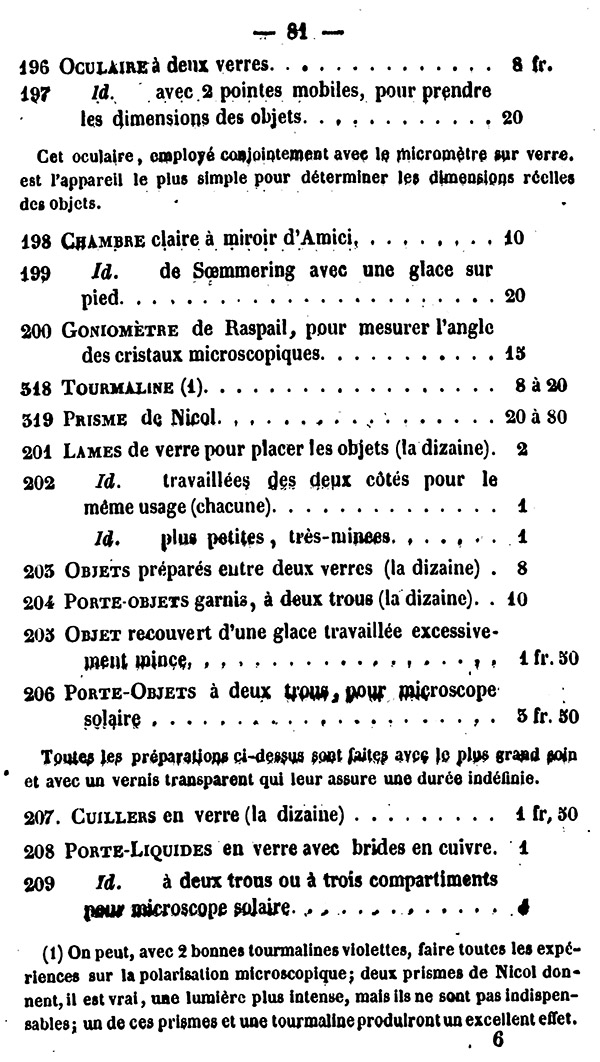
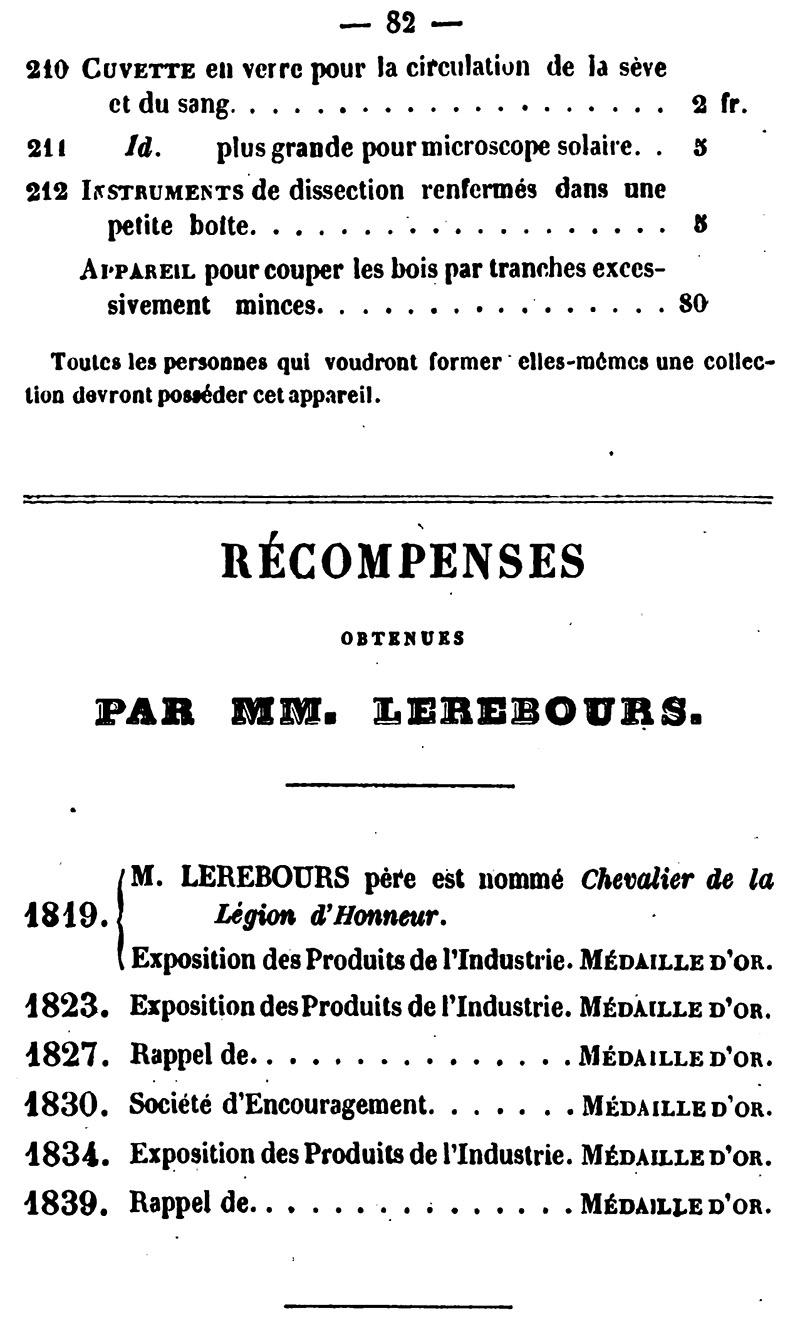
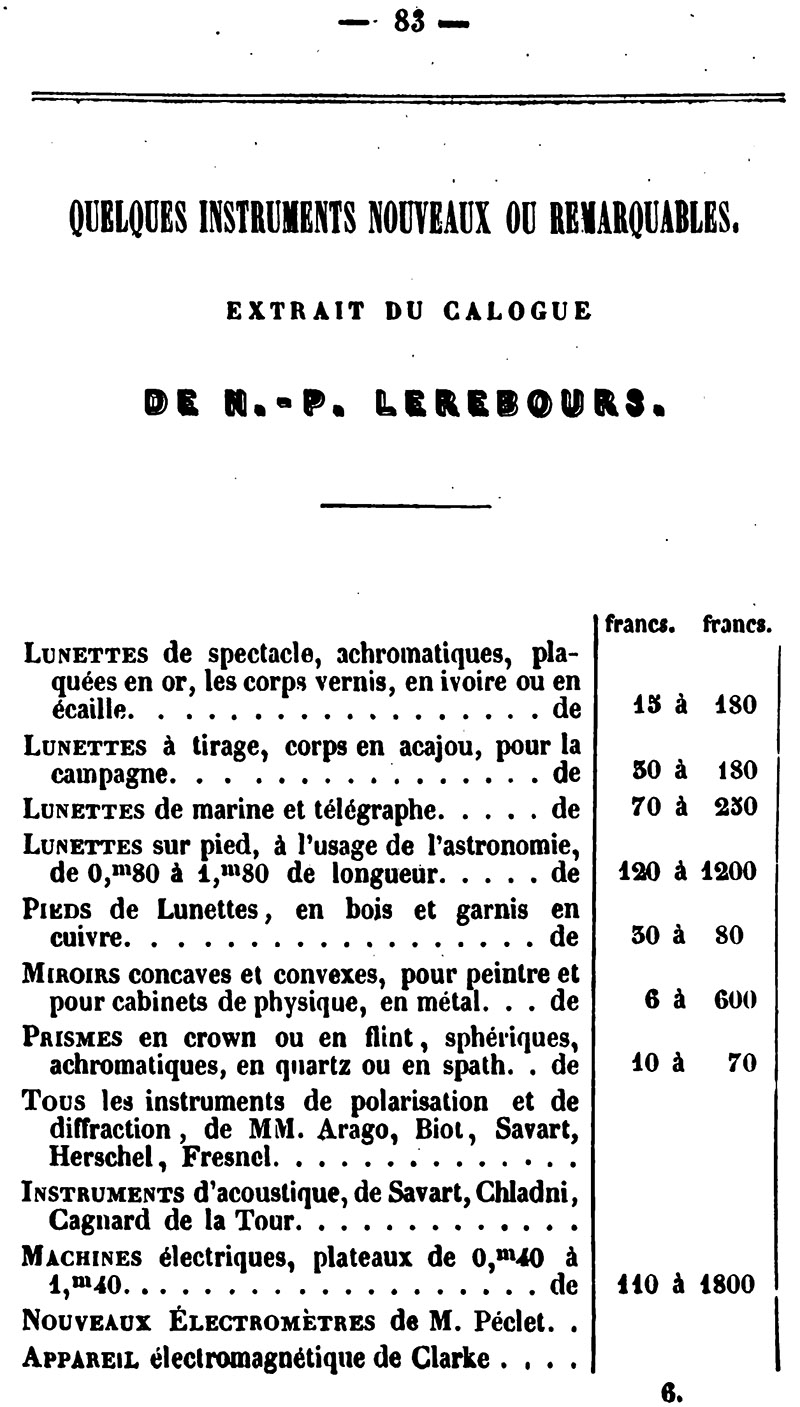
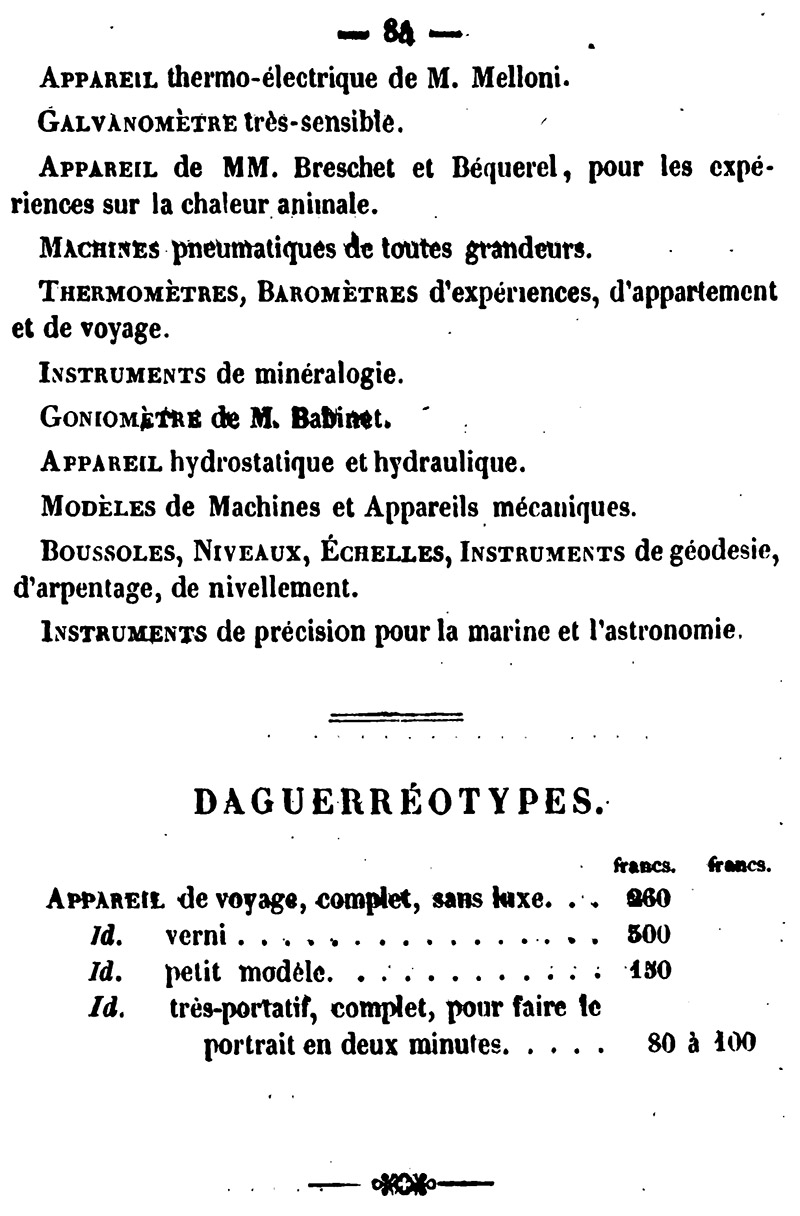
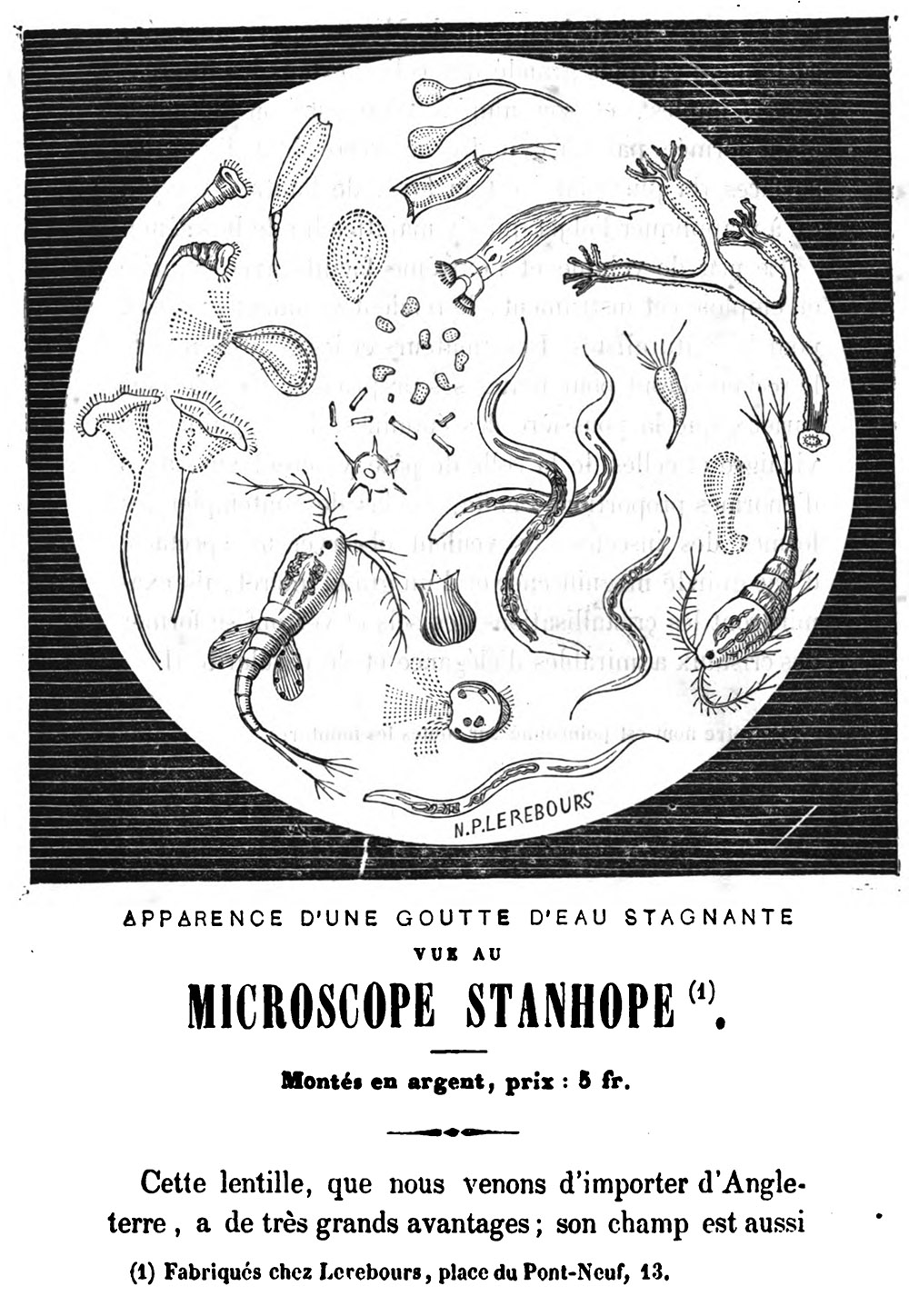
Figure 15.
Lerebours’ 1840 catalogue of microscopes and other apparatus, which was included in his ca. 1841 second edition of “Description des Microscopes Achromatiques Simplifies”.
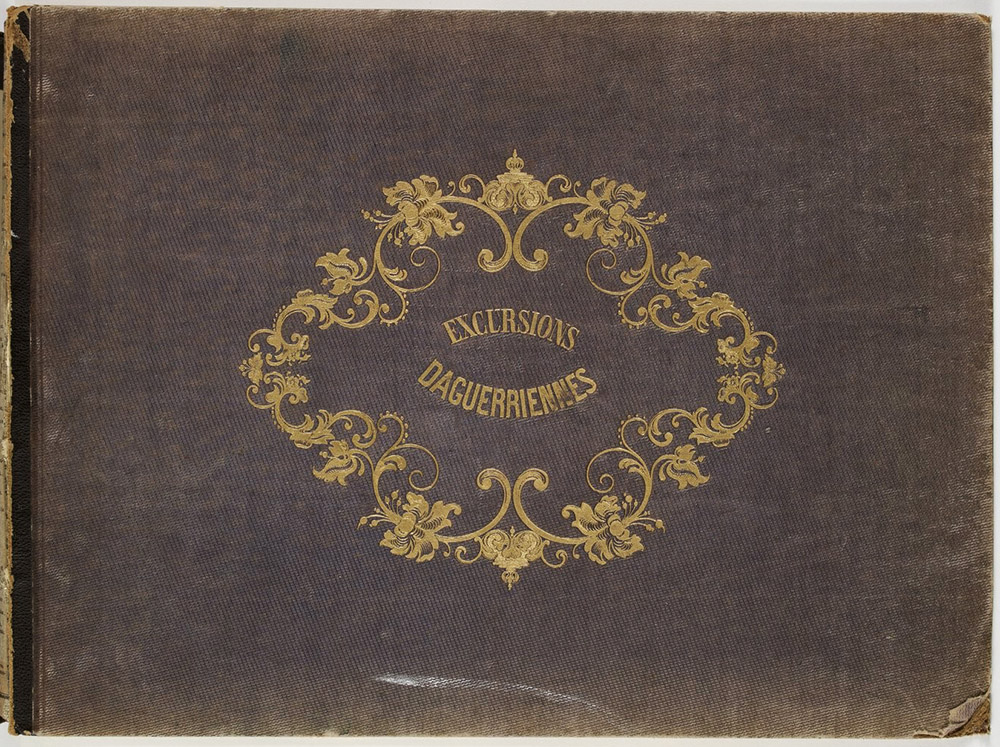
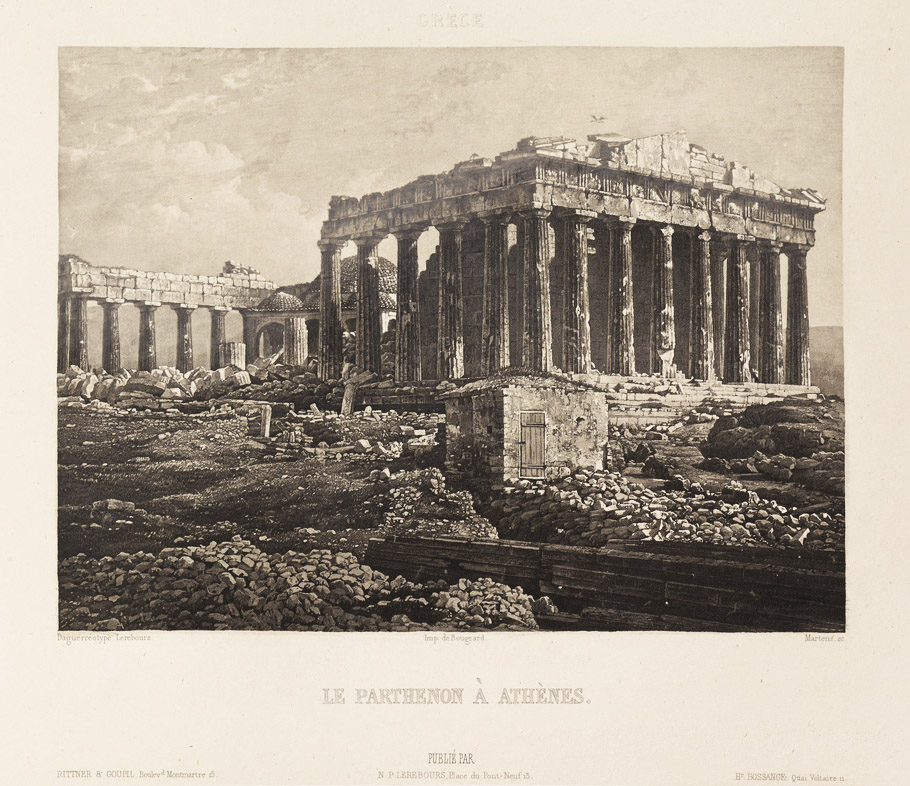
Figure 16.
Cover of the second volume of “Excursions Daguerriennes”, published by N.P. Lerebours, 1842, and an included lithograph of the Parthenon of Athens.
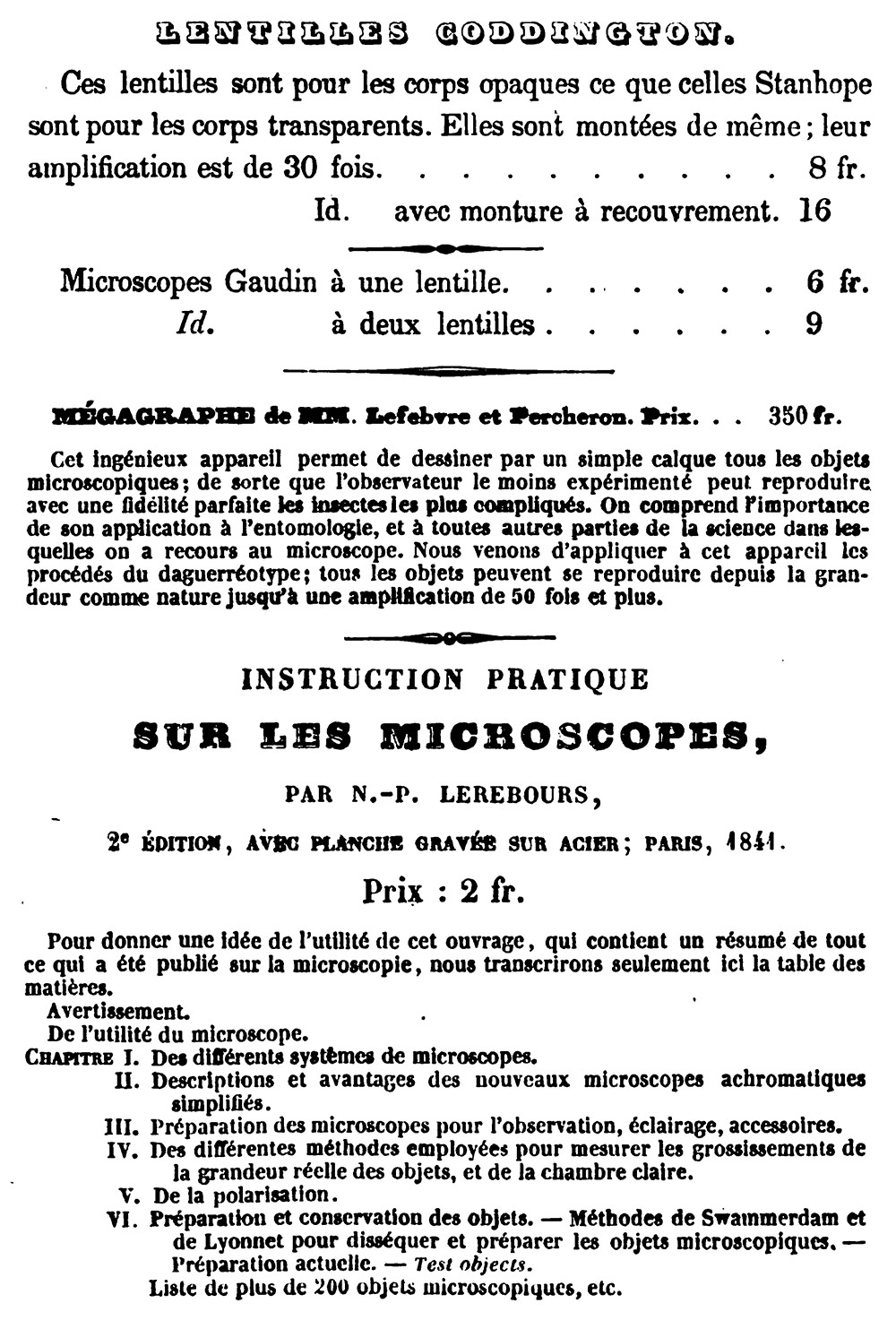
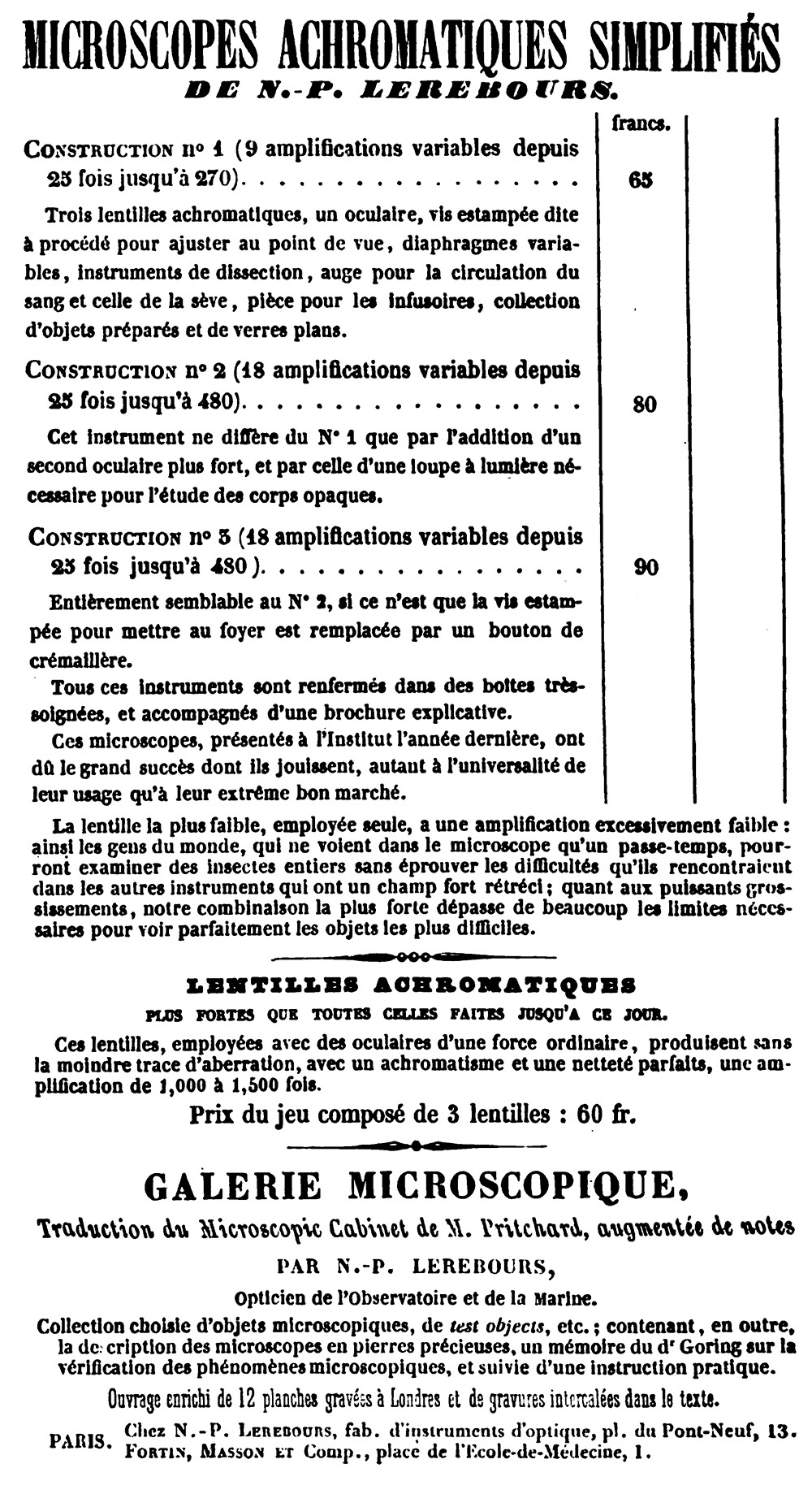
Figure 17.
A mini-catalogue of N.-J. Lerebours’ microscopes, from the rear of his 1843 “Traite de Photographie”. A similar catalogue was bound into Lerebours’ ”Traité de Galvanoplastie”, published in the same year.
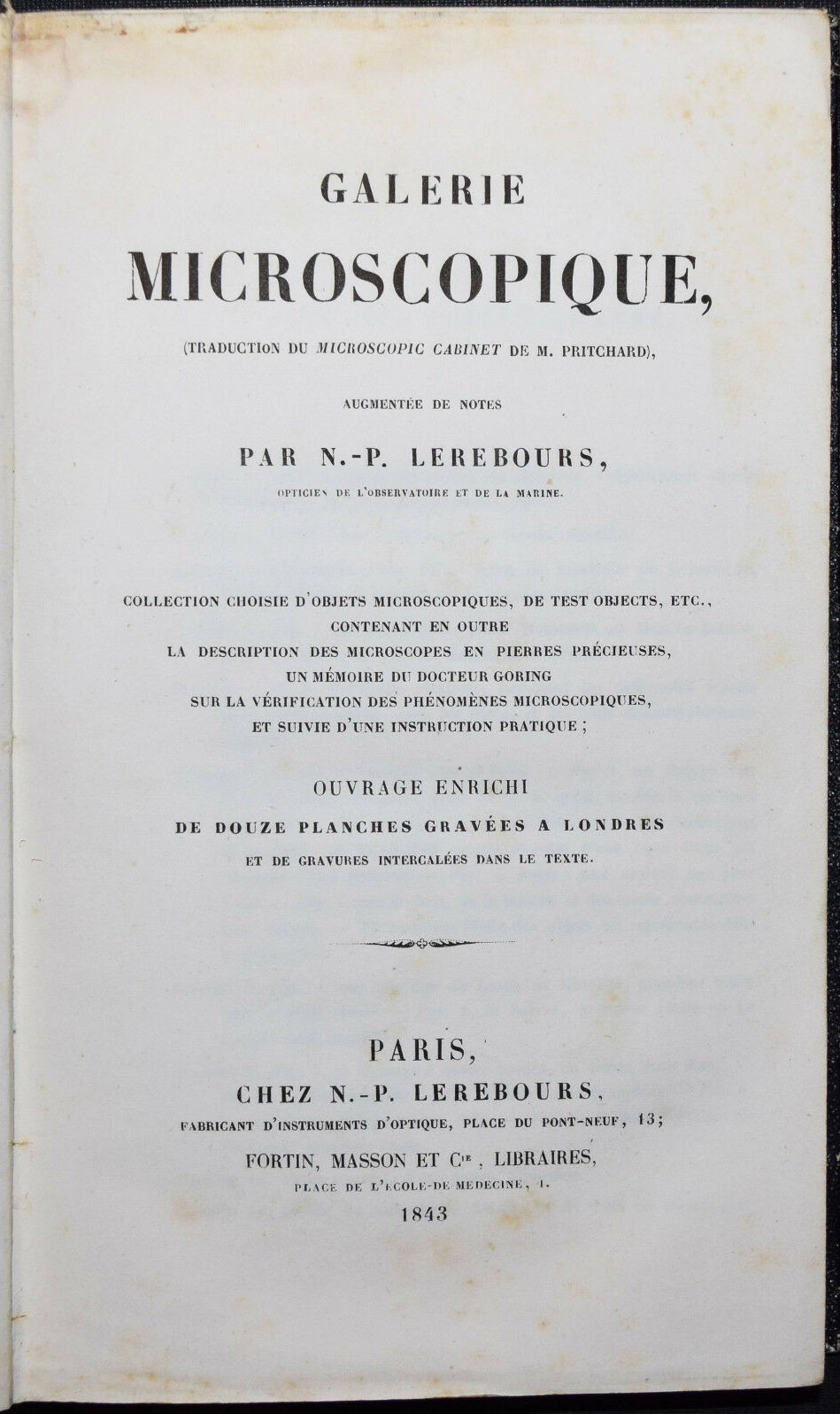
Figure 18.
Title page of N.P. Lerebours’ 1843 translation of Andrew Pritchard’s “Microscopic Cabinet” (1832).
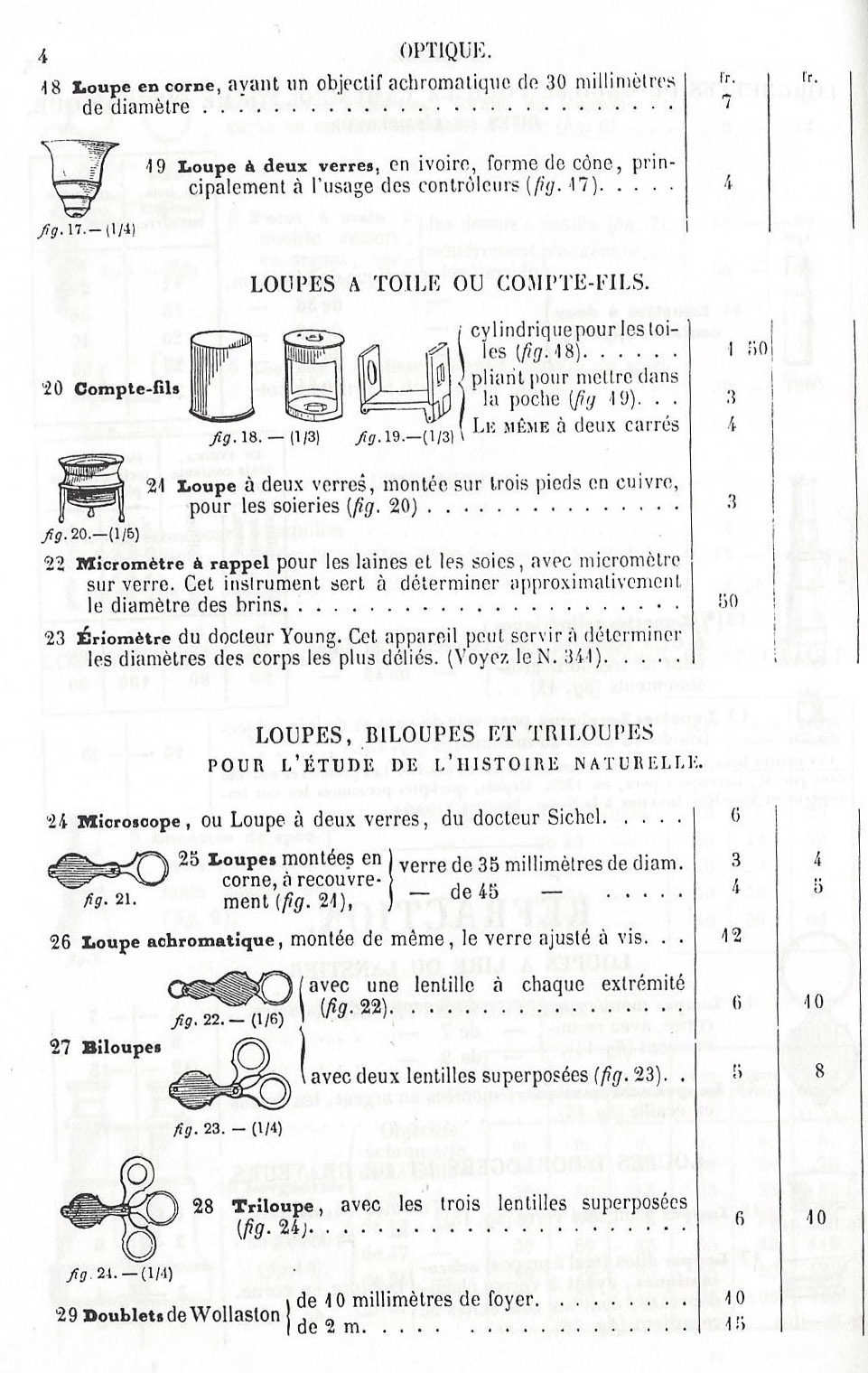
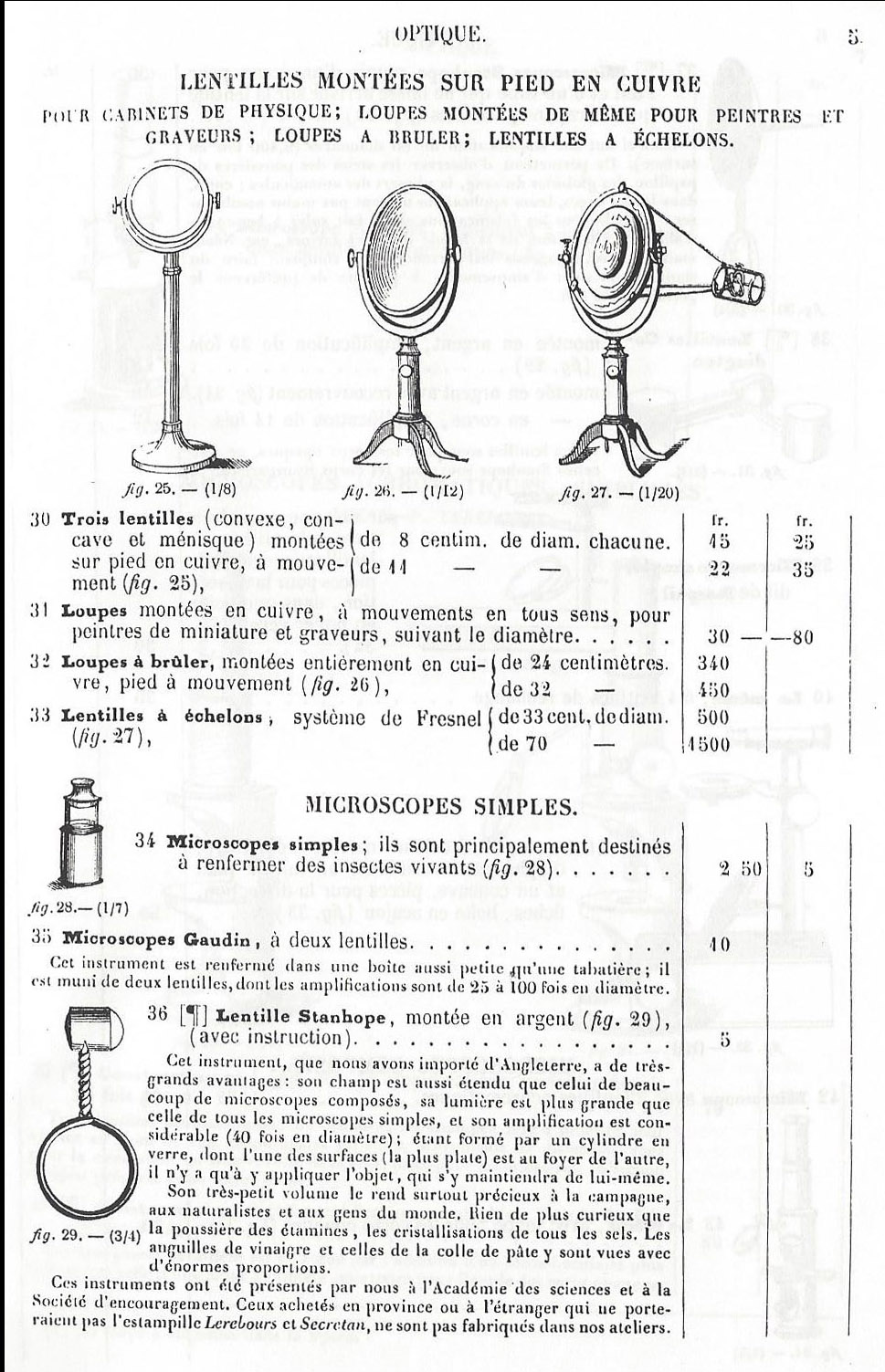

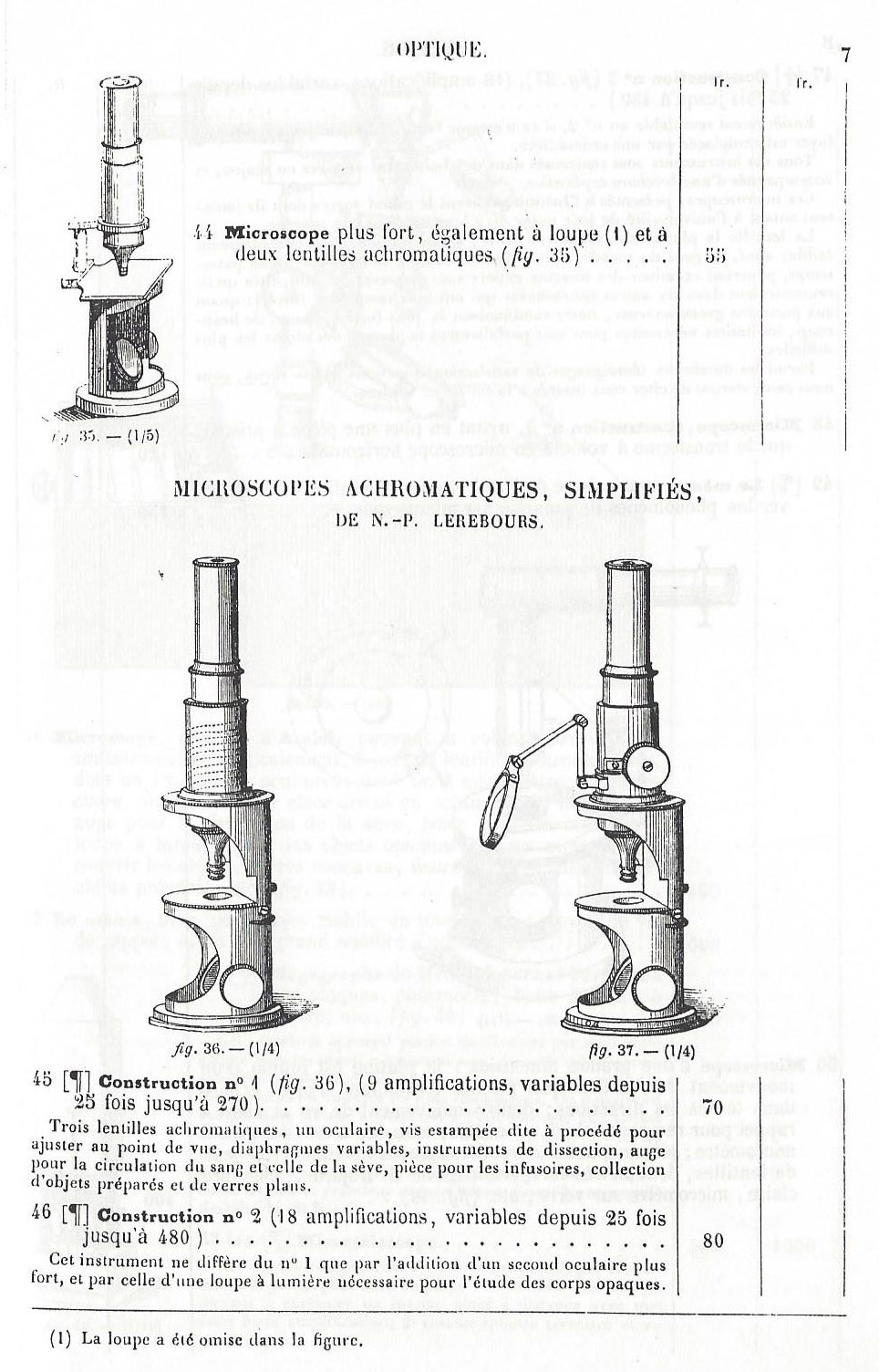
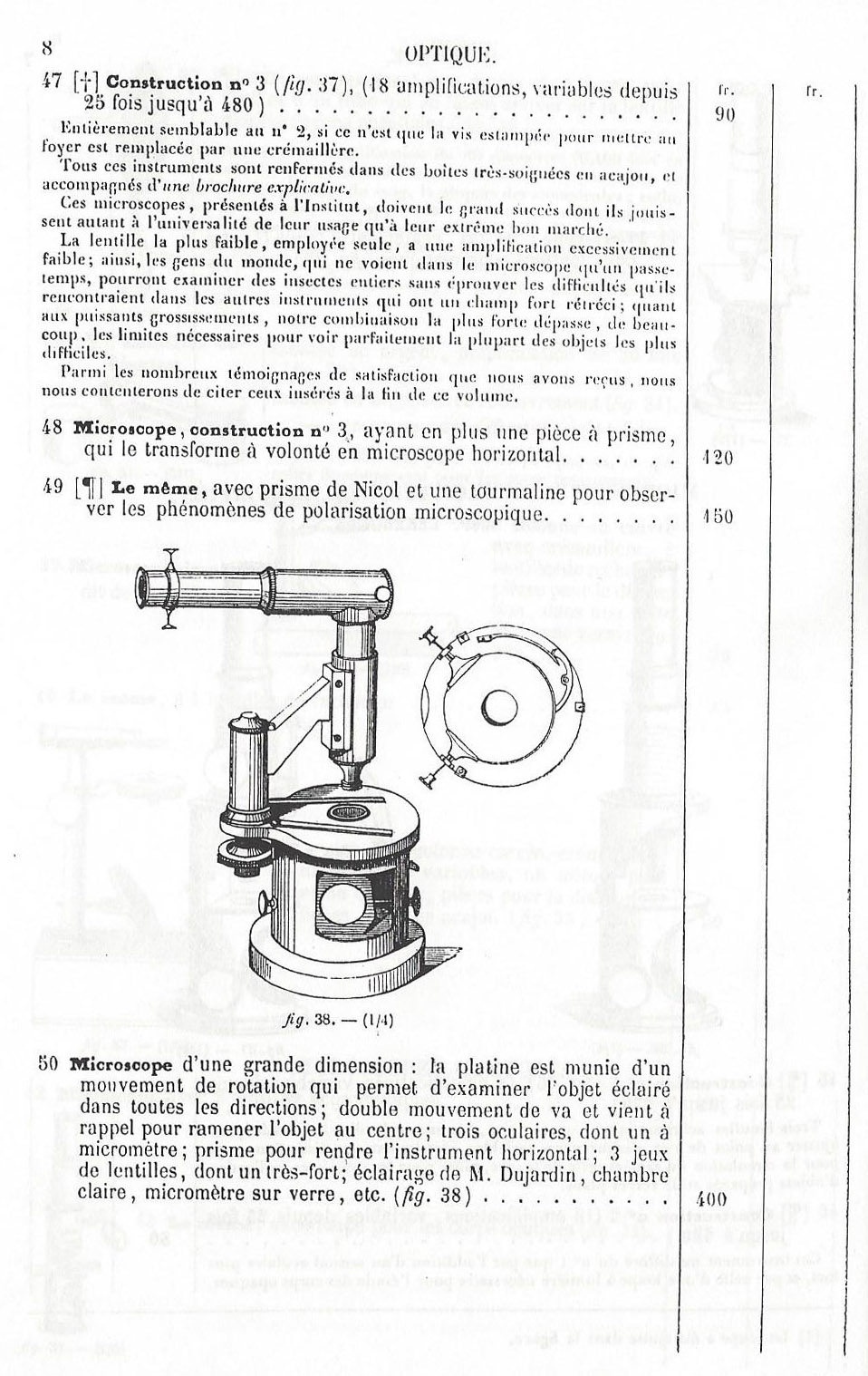
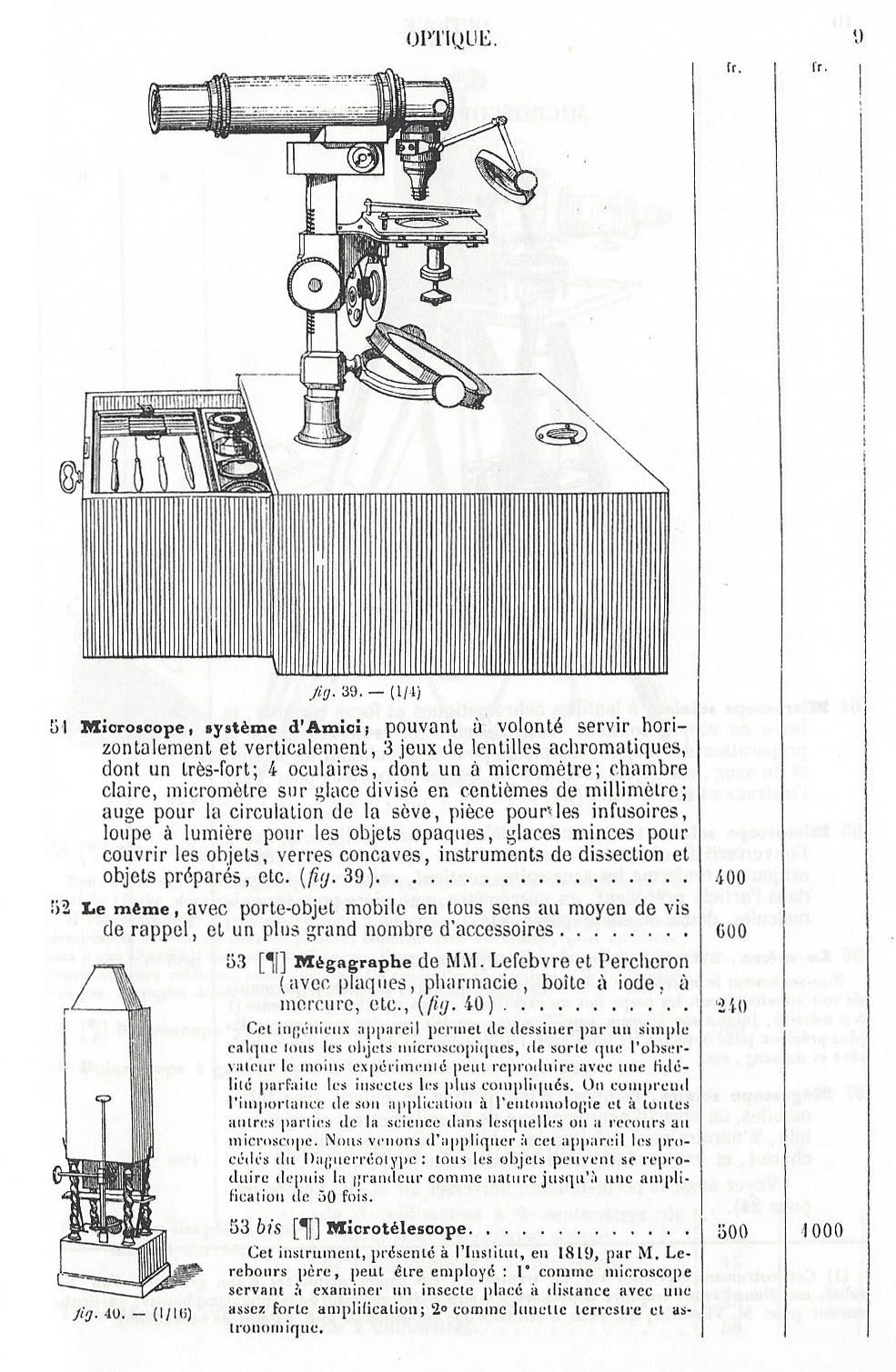
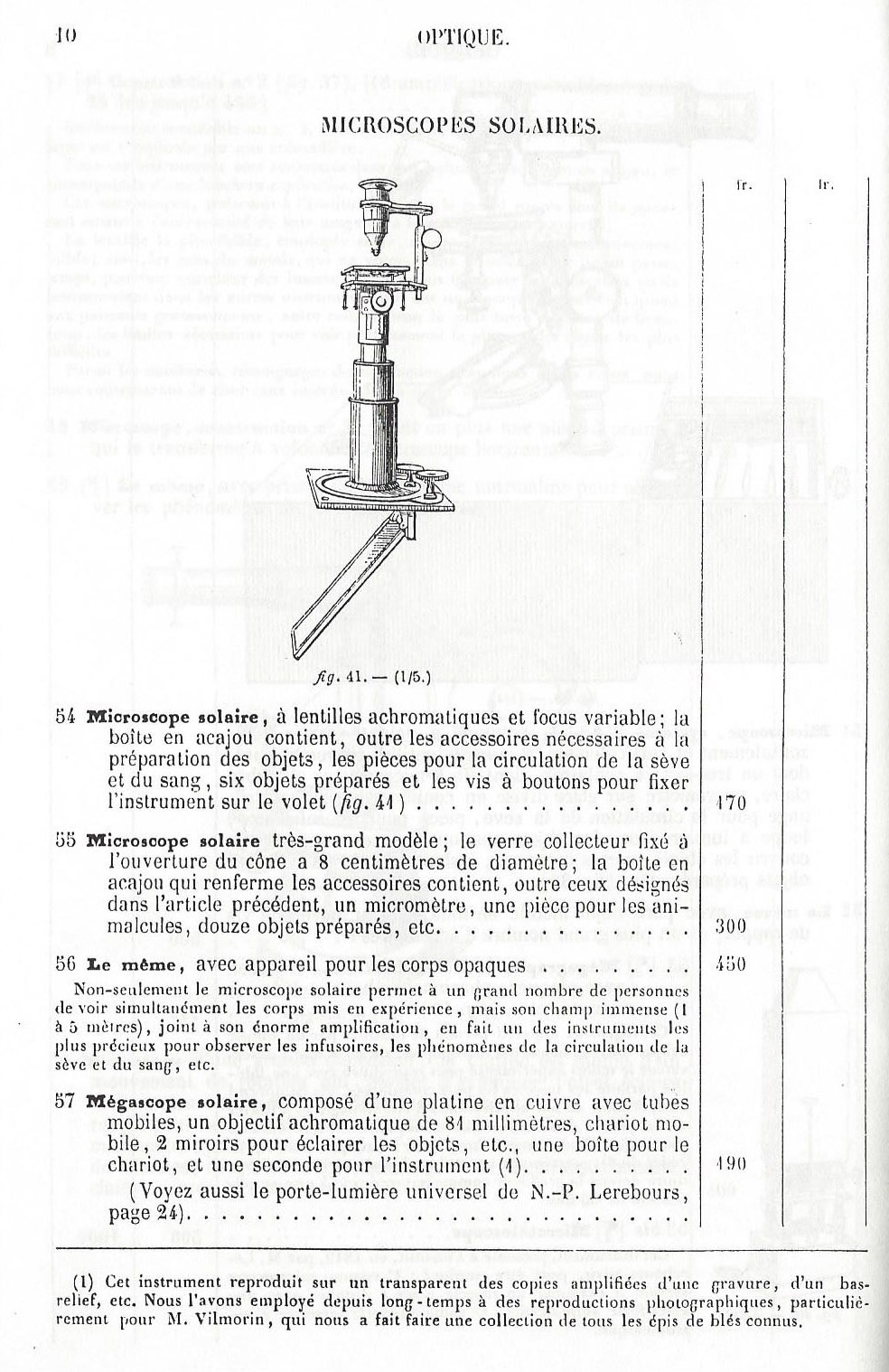
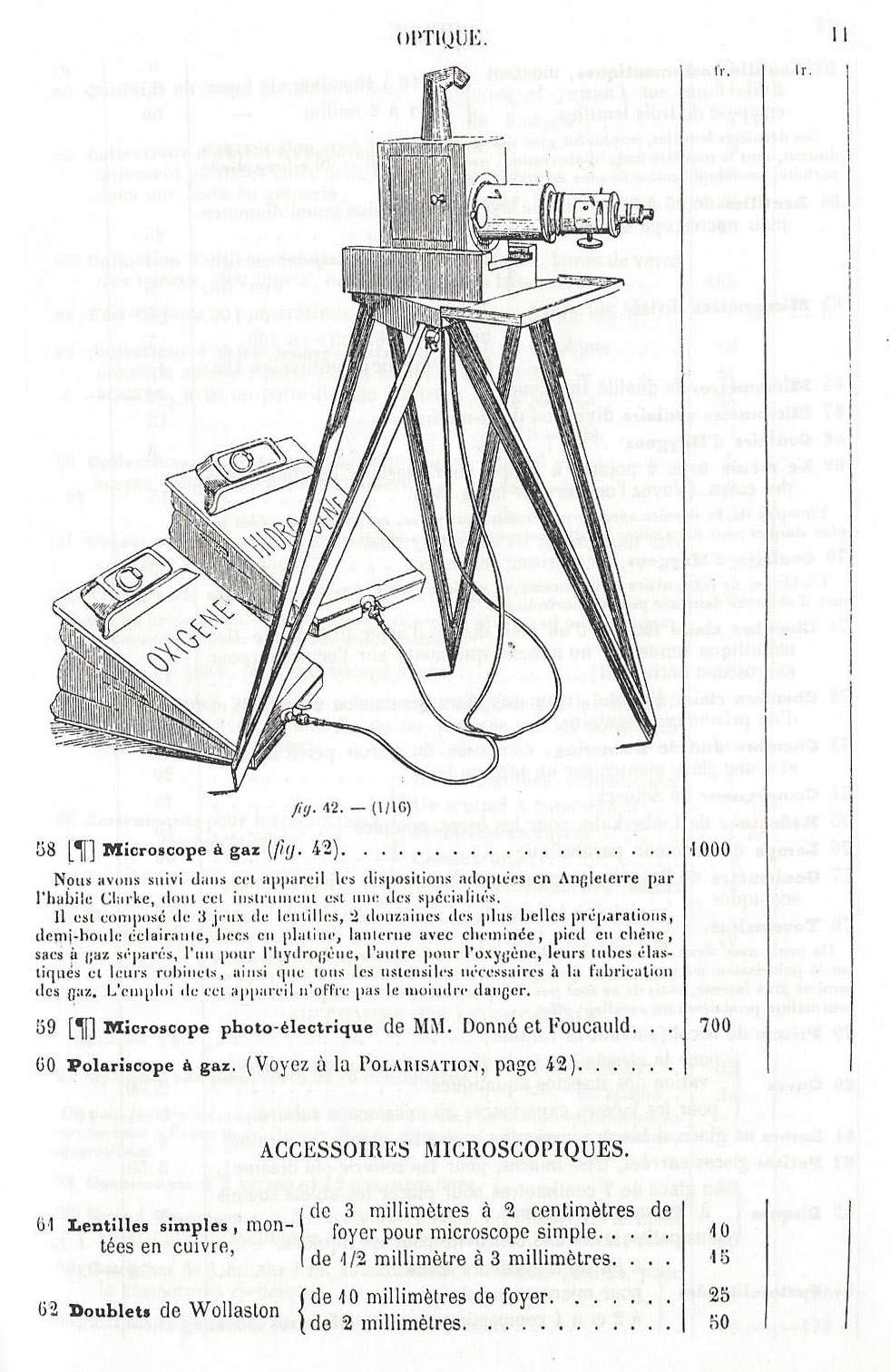
Figure 19
Microscope entries in a ca. 1845 Lerebours and Secrétan catalogue. The catalogue is not dated, but the last medal noted was awarded to Lerebours and Secrétan in 1844.
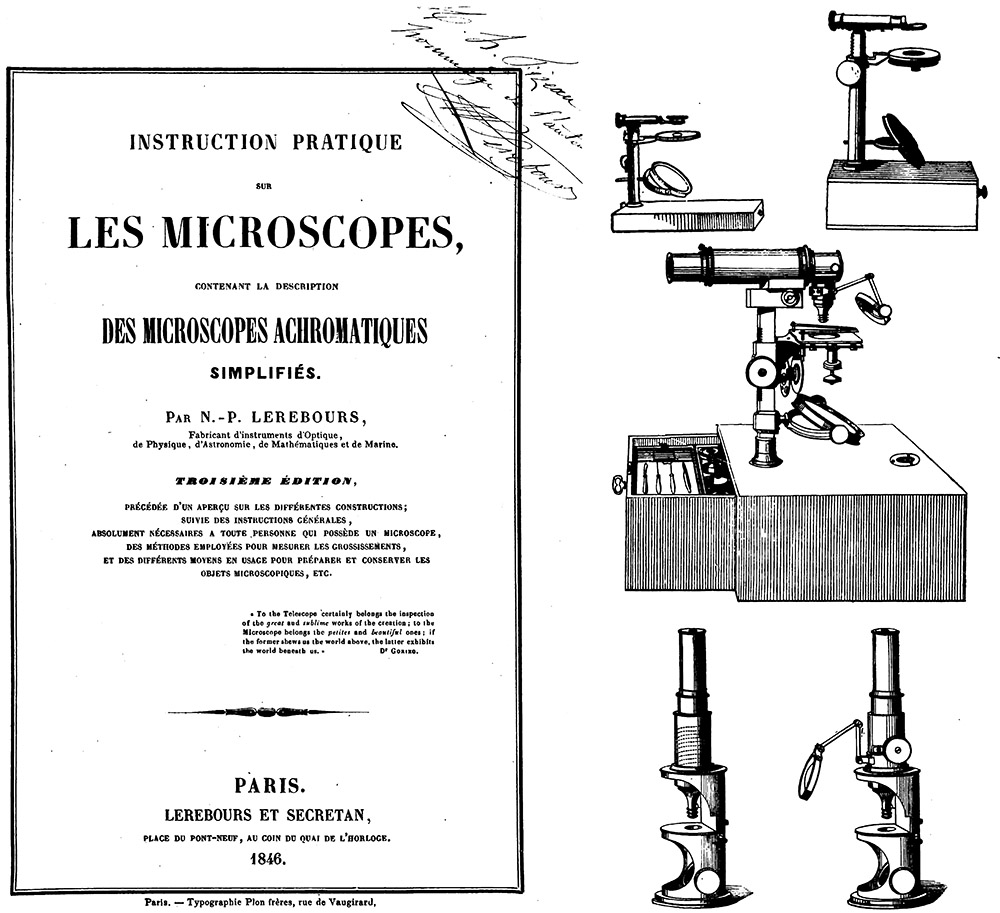
Figure 20A.
Title page of N.P. Lerebours’ 1846 “Instruction Pratique Sur Les Microscopes, Contenant La Description Des Microscopes Achromatiques Simplifies”, along with engravings of microscopes by Lerebours and Secrétan that were included in the book. The title page of this copy, adapted from Google Books, includes N.P. Lerebours’ signature. The firm produced two forms of Raspail-type microscope (top), a horizontal Amici-type microscope (middle), and their drum-style achromatic microscopes (bottom).
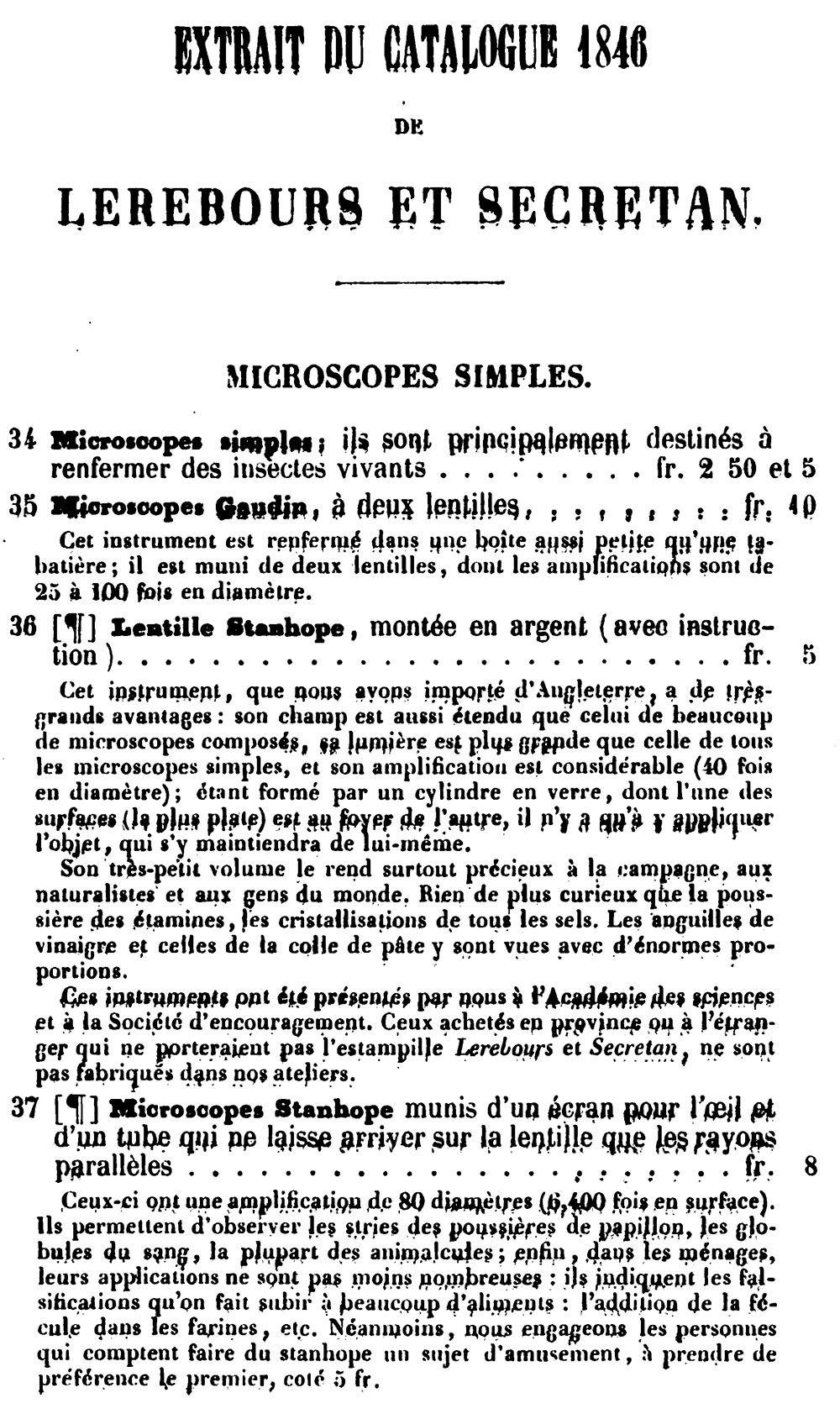

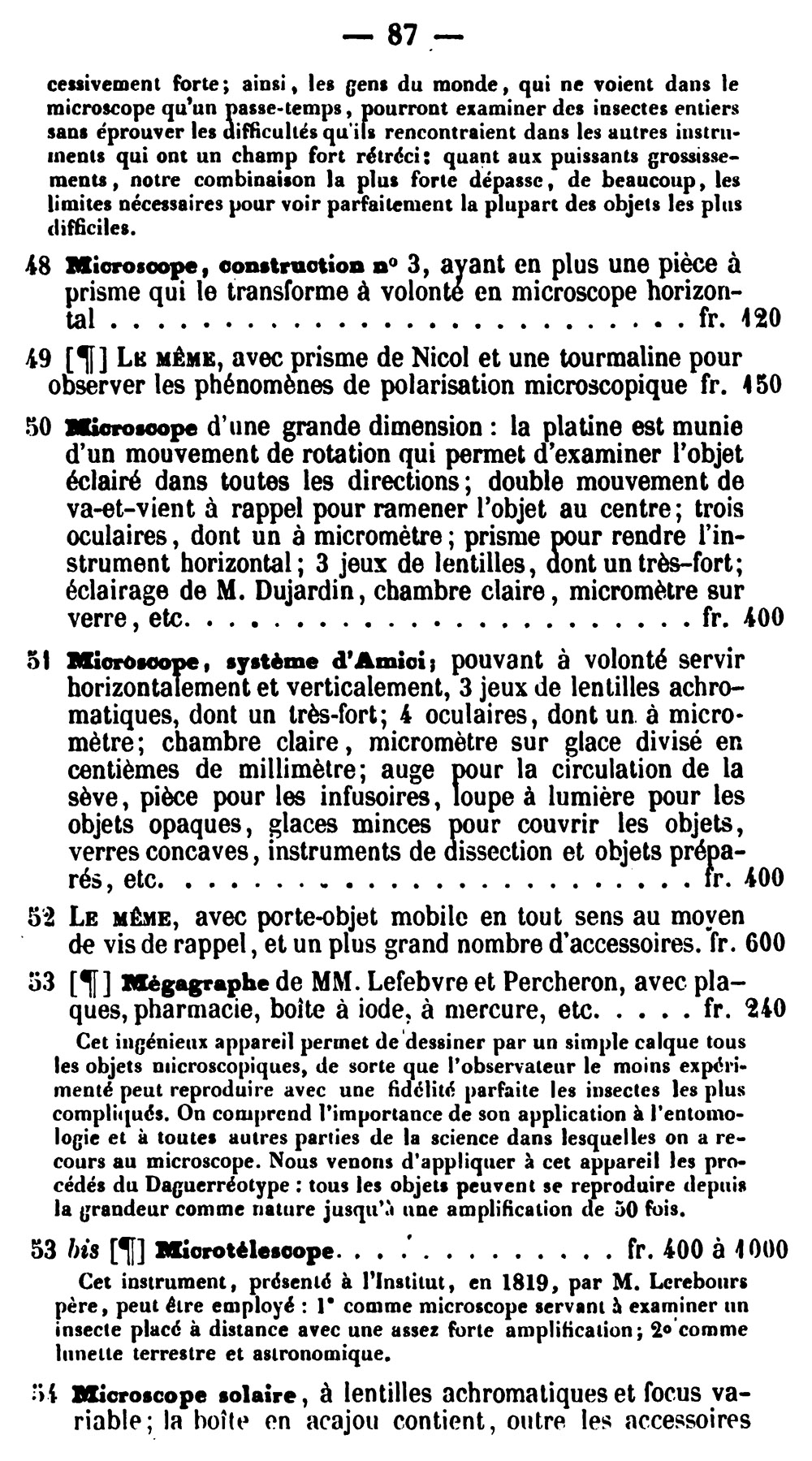
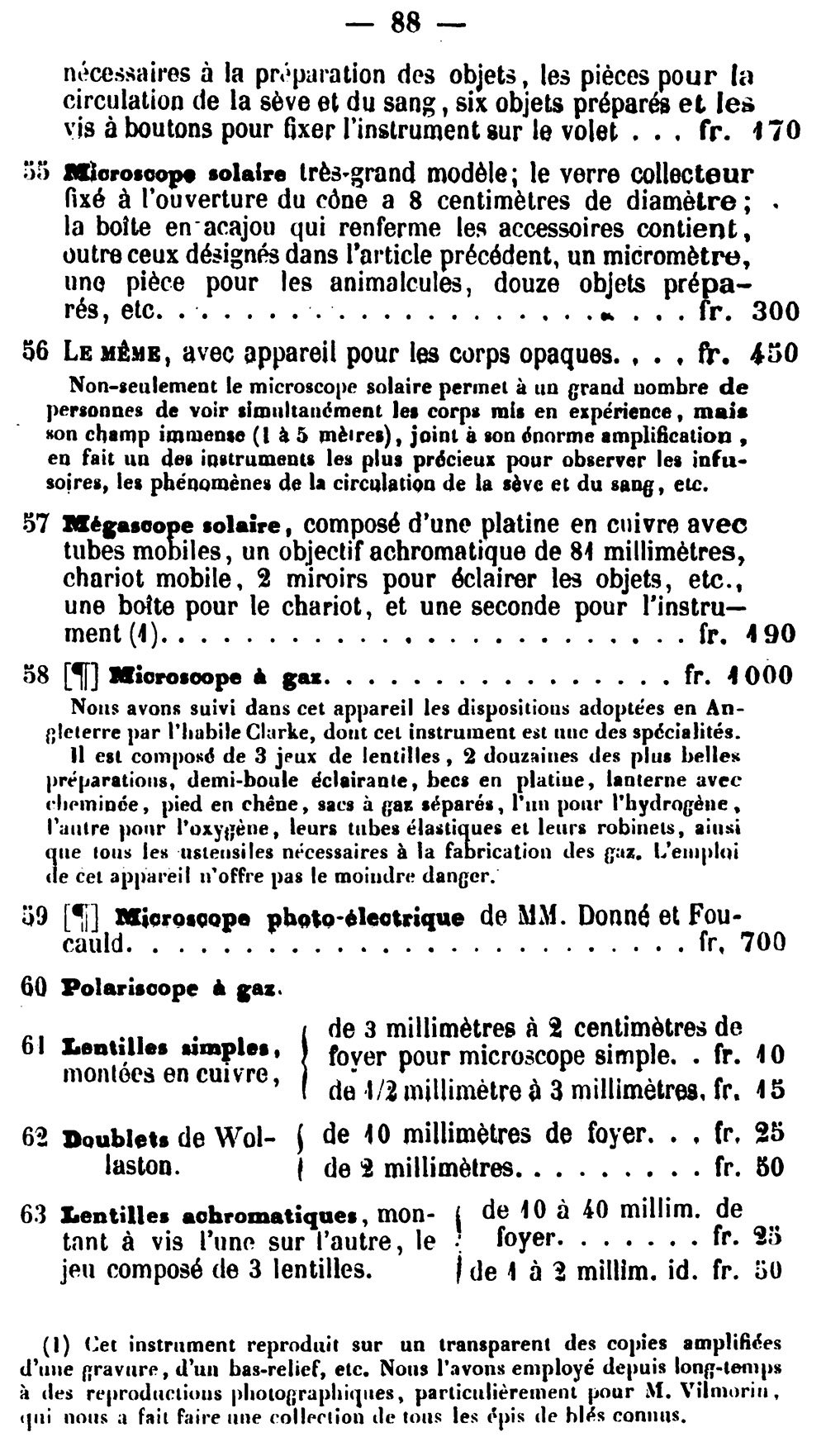
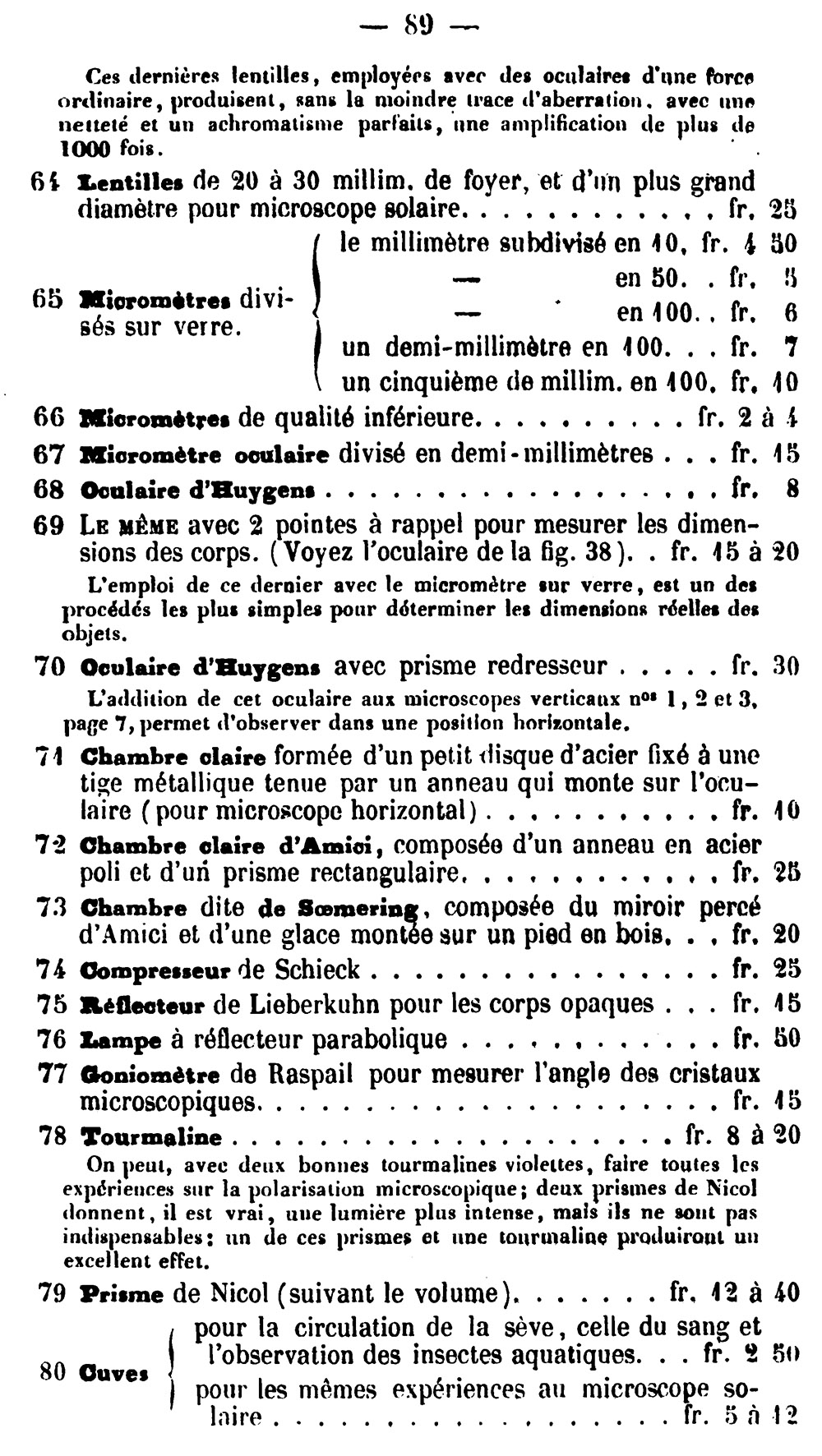
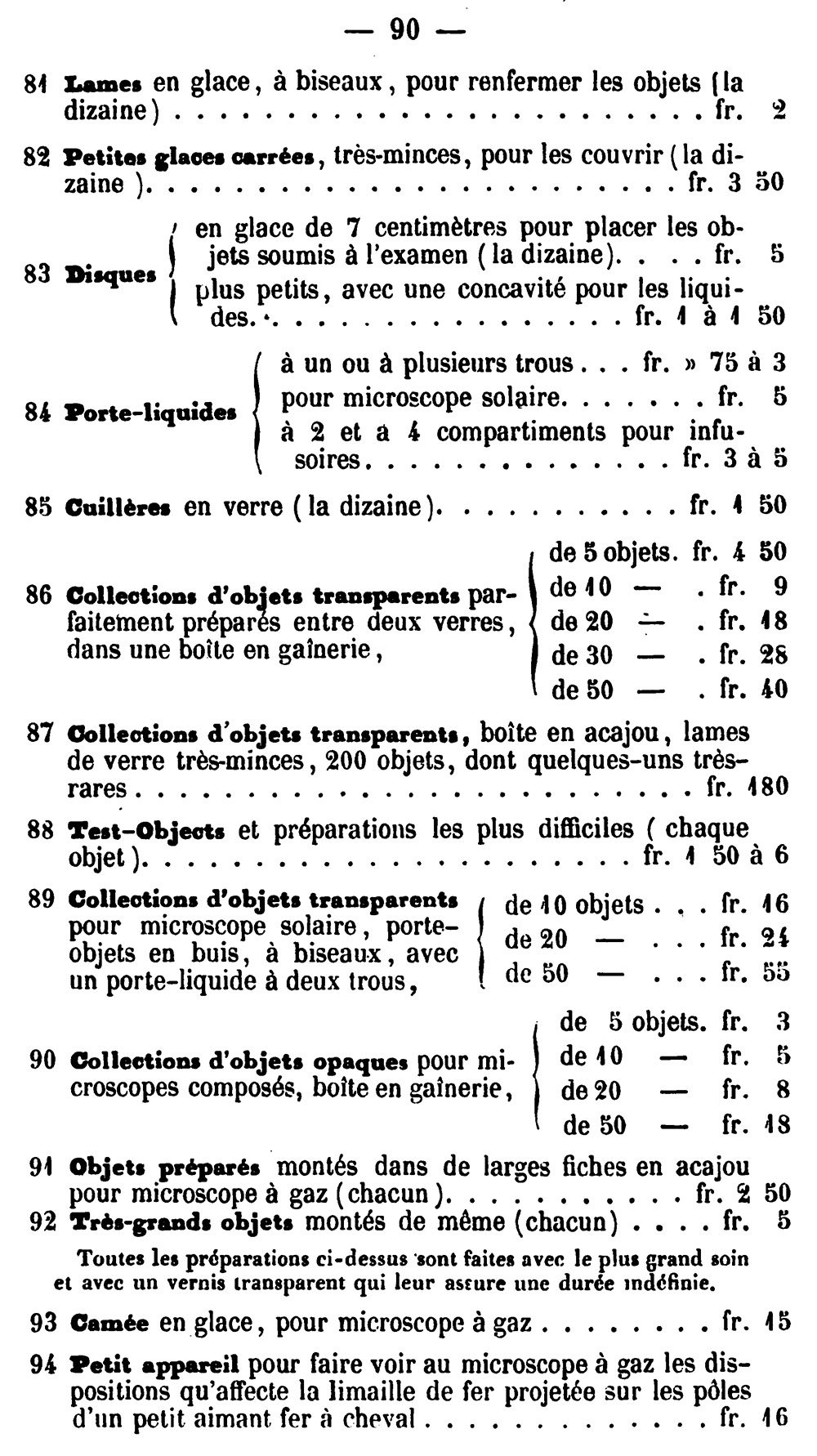
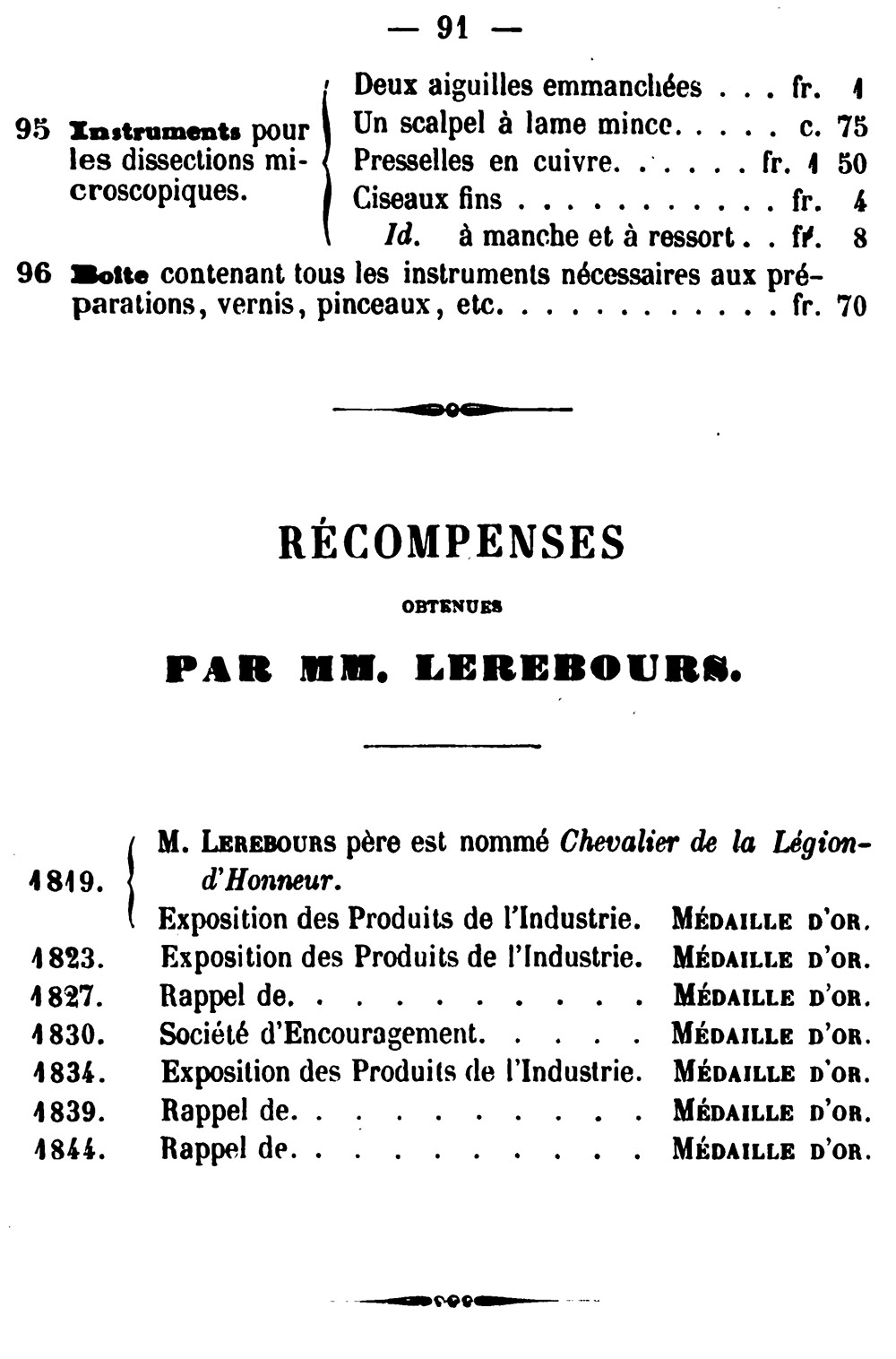
Figure 20B.
Extract of Lerebours and Secrétan’s 1846 catalogue, which was bound into that year’s “Instruction Pratique Sur Les Microscopes, Contenant La Description Des Microscopes Achromatiques Simplifies” (Figure 19).

Figure 21.
An 1847 advertisement, from “l’Illustration”.
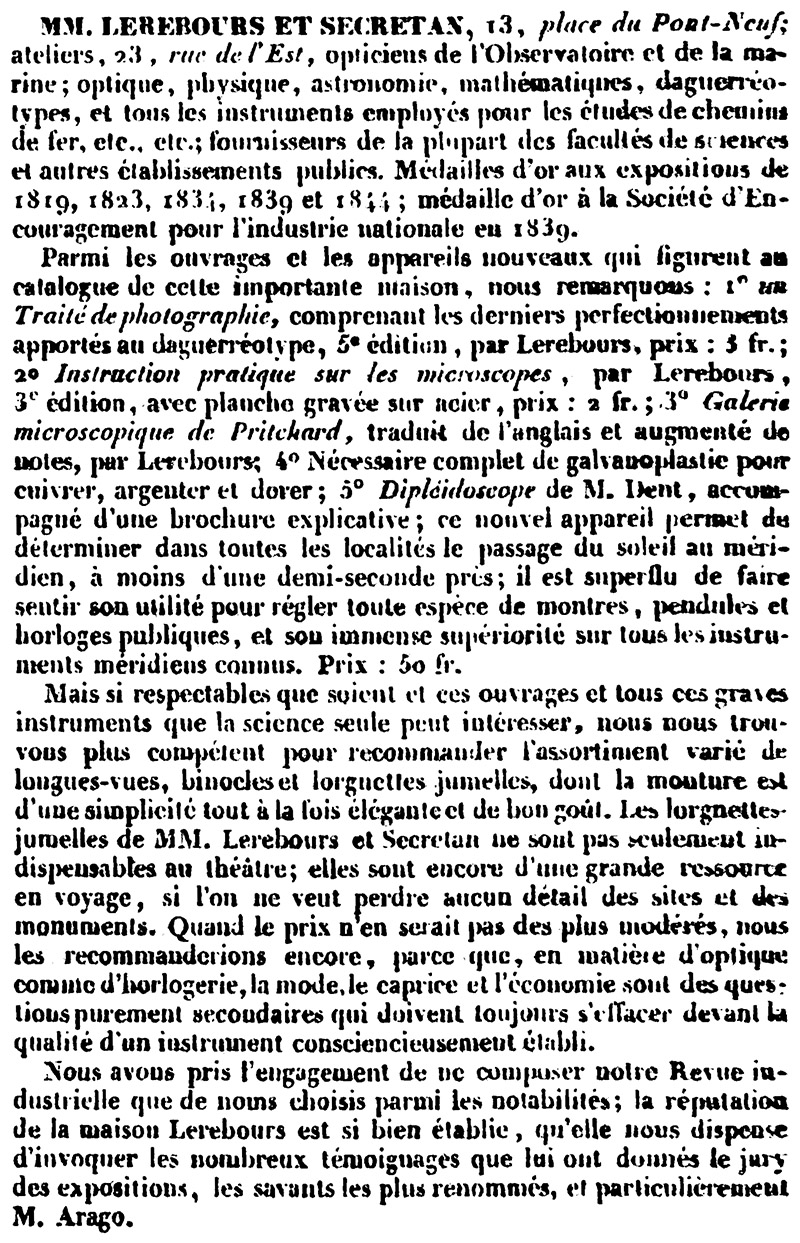
Figure 22.
�An 1847 advertisement from “Annuaire Général du Commerce et de l'Industrie”
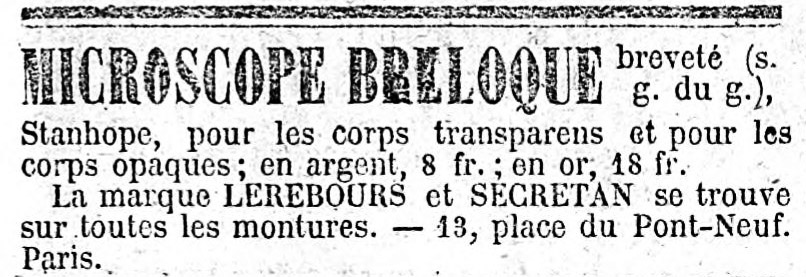
Figure 23.
�An 1851 advertisement for Stanhope magnifiers, from “Le Constitutionnel”.
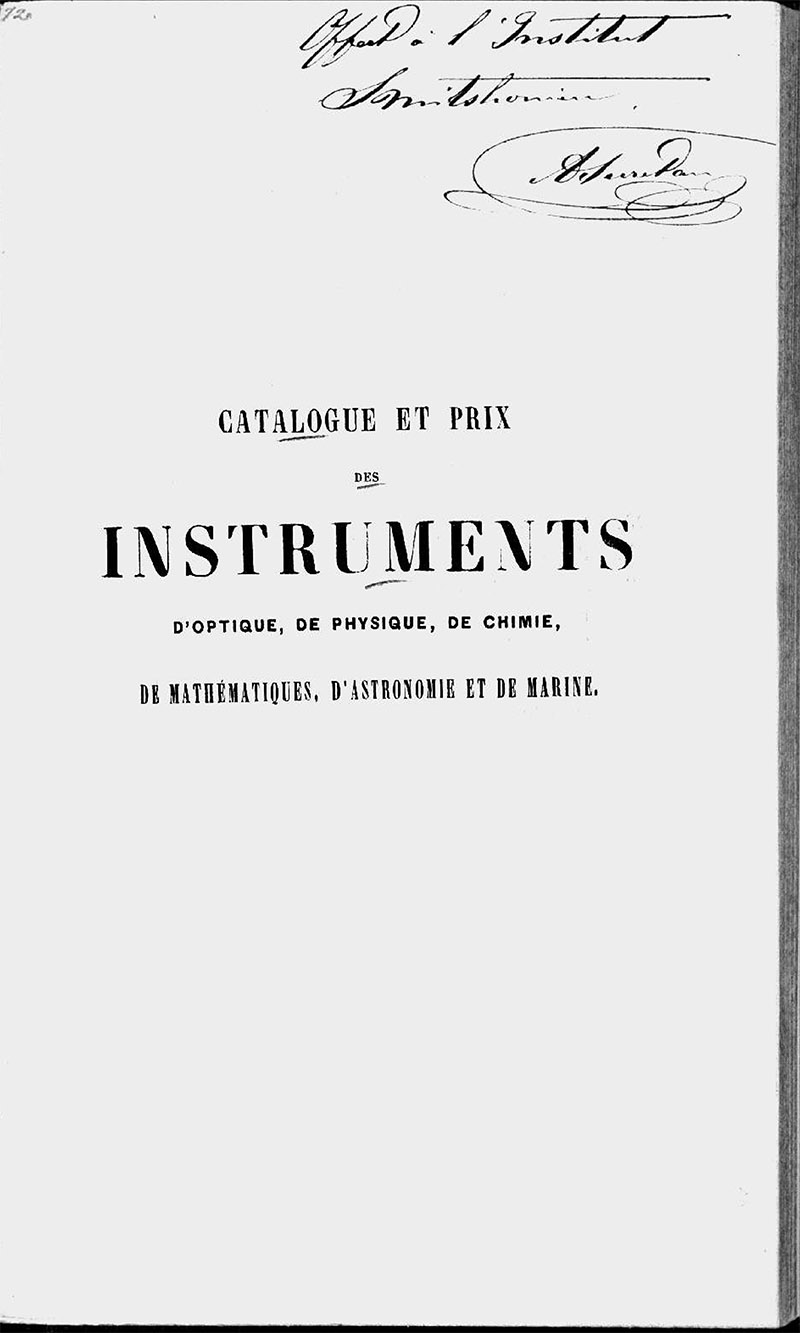
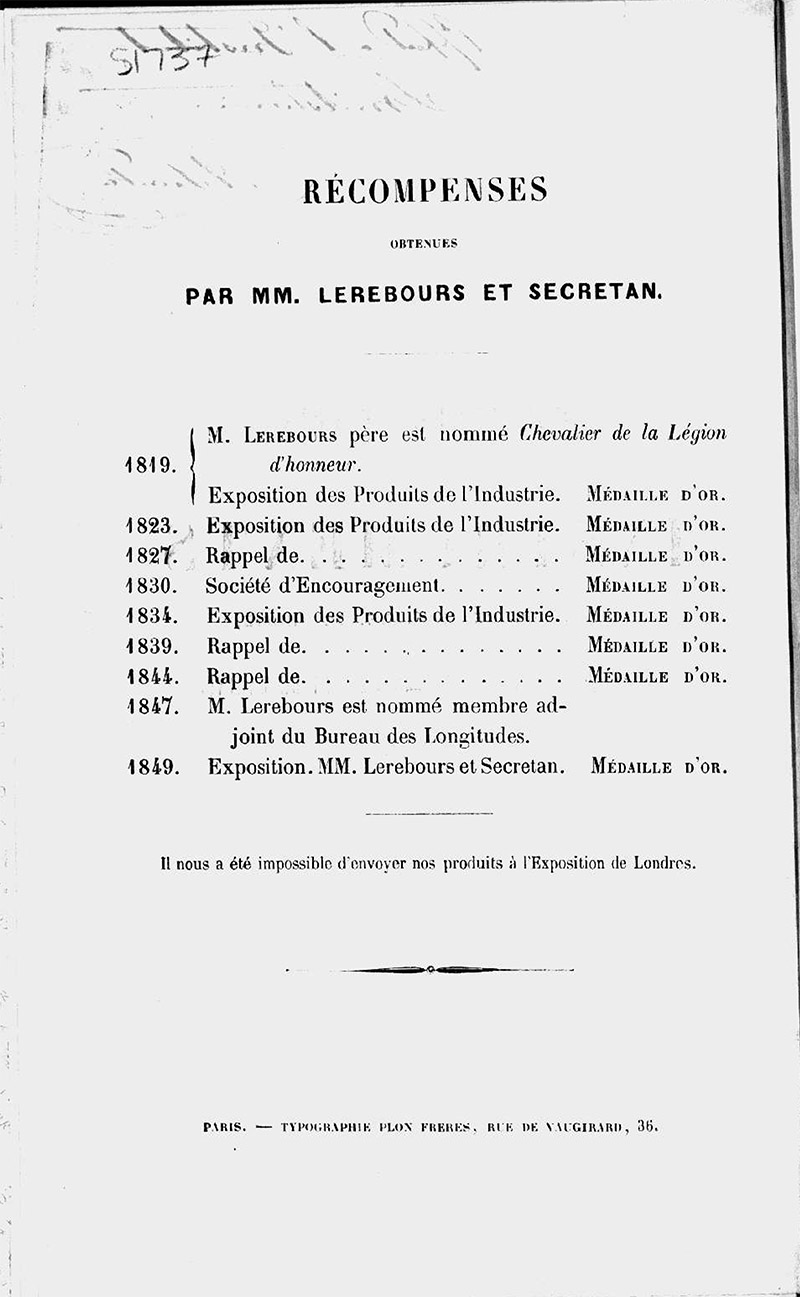
�
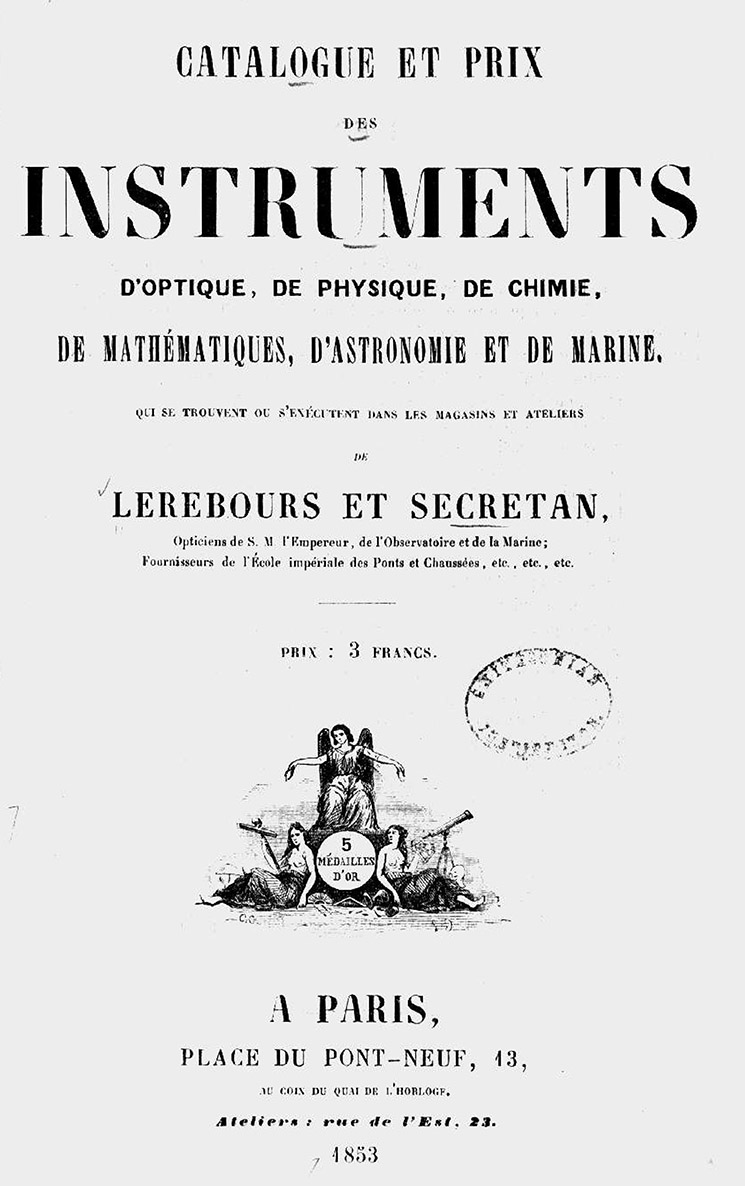
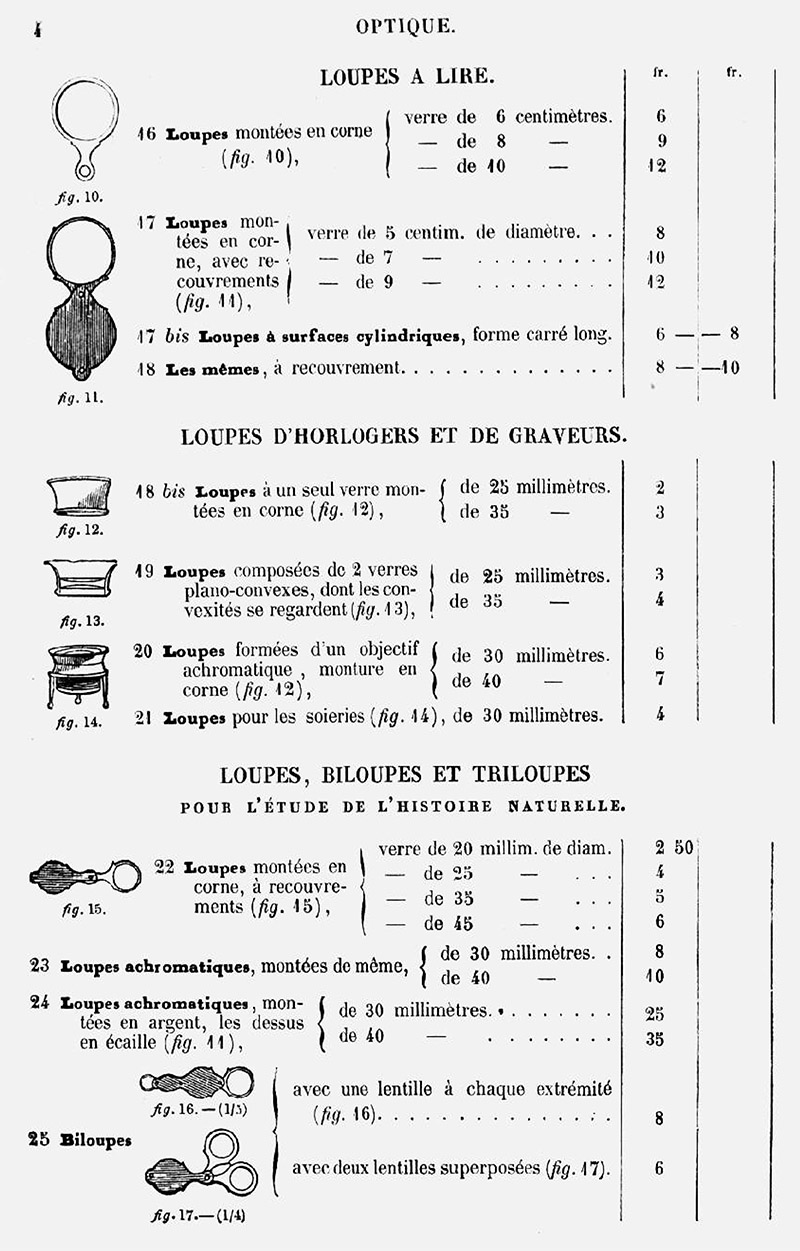
�
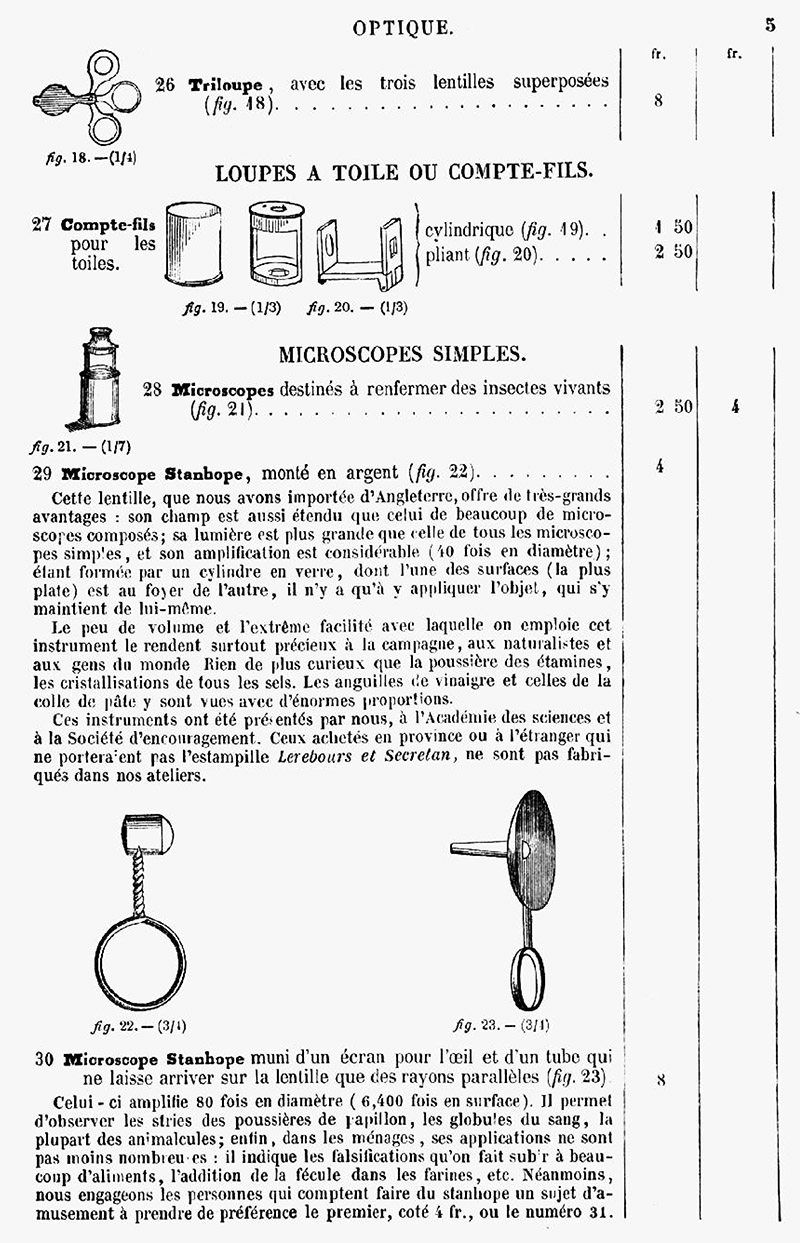
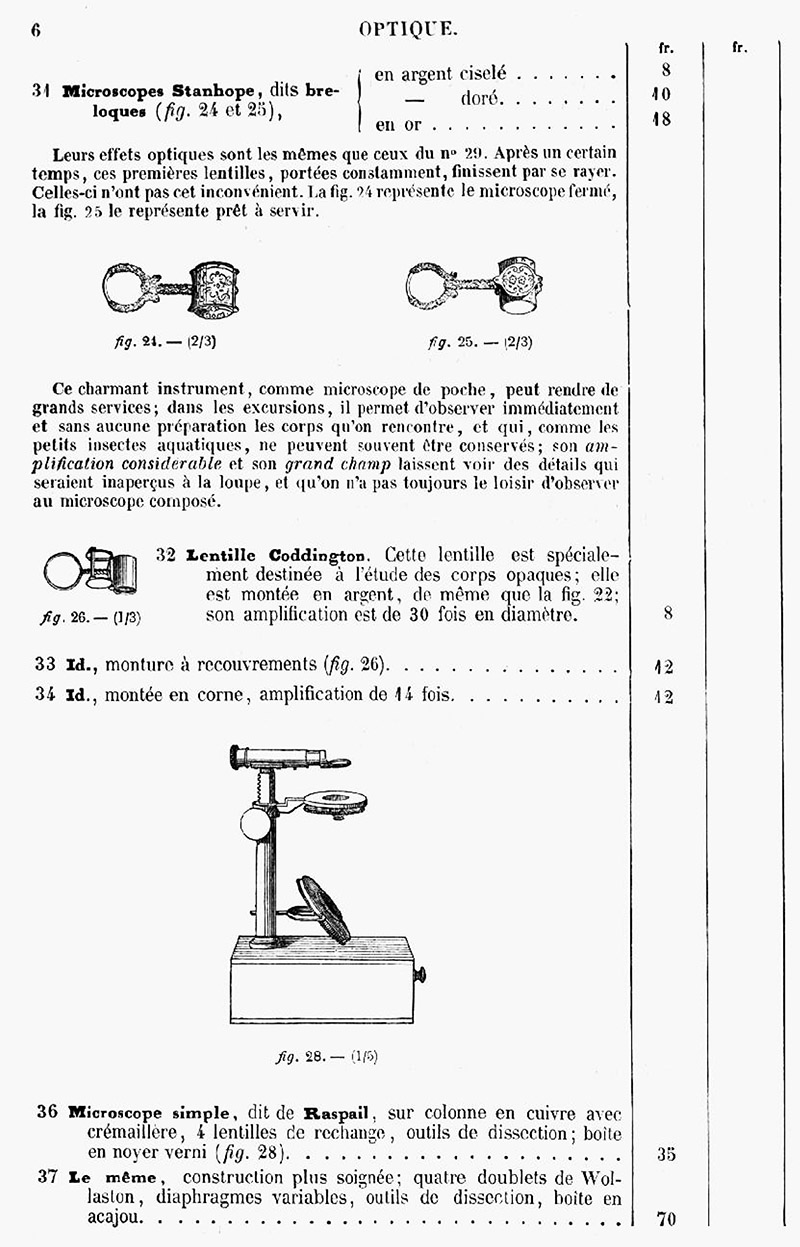
�
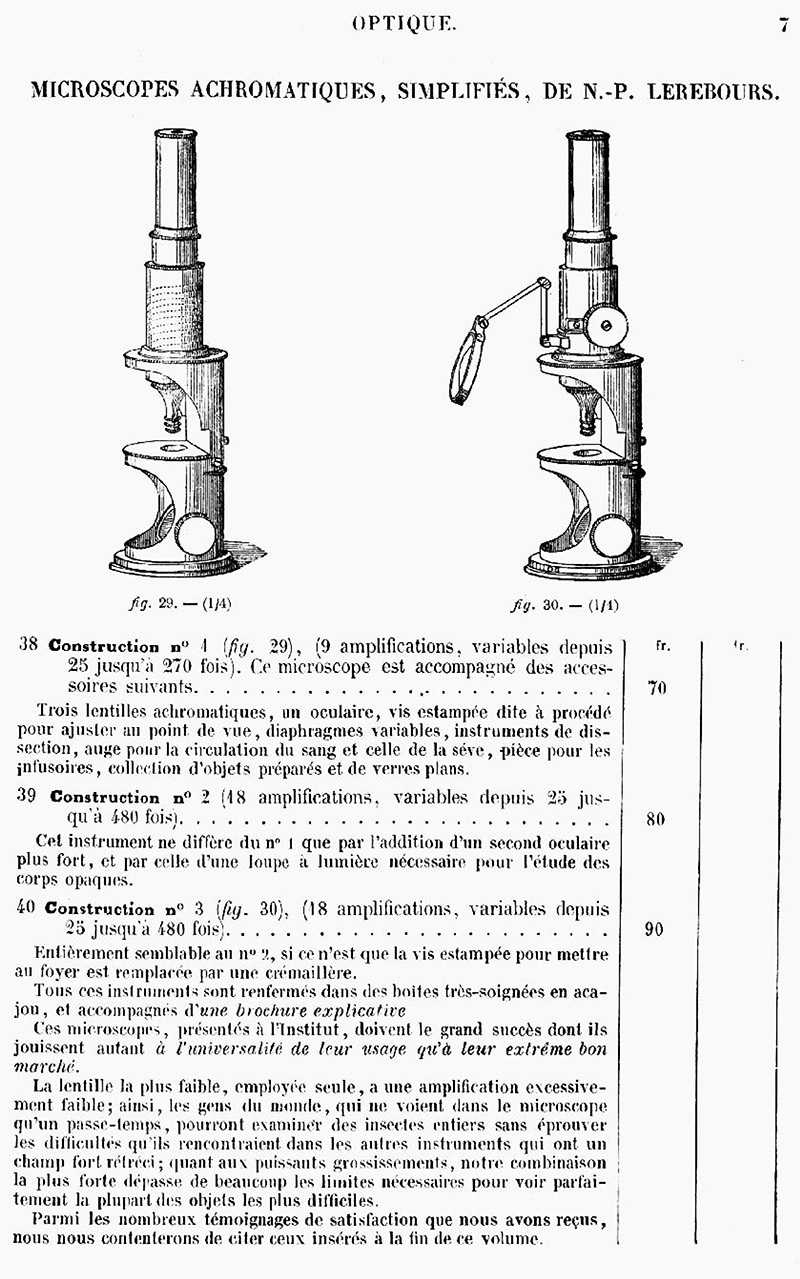
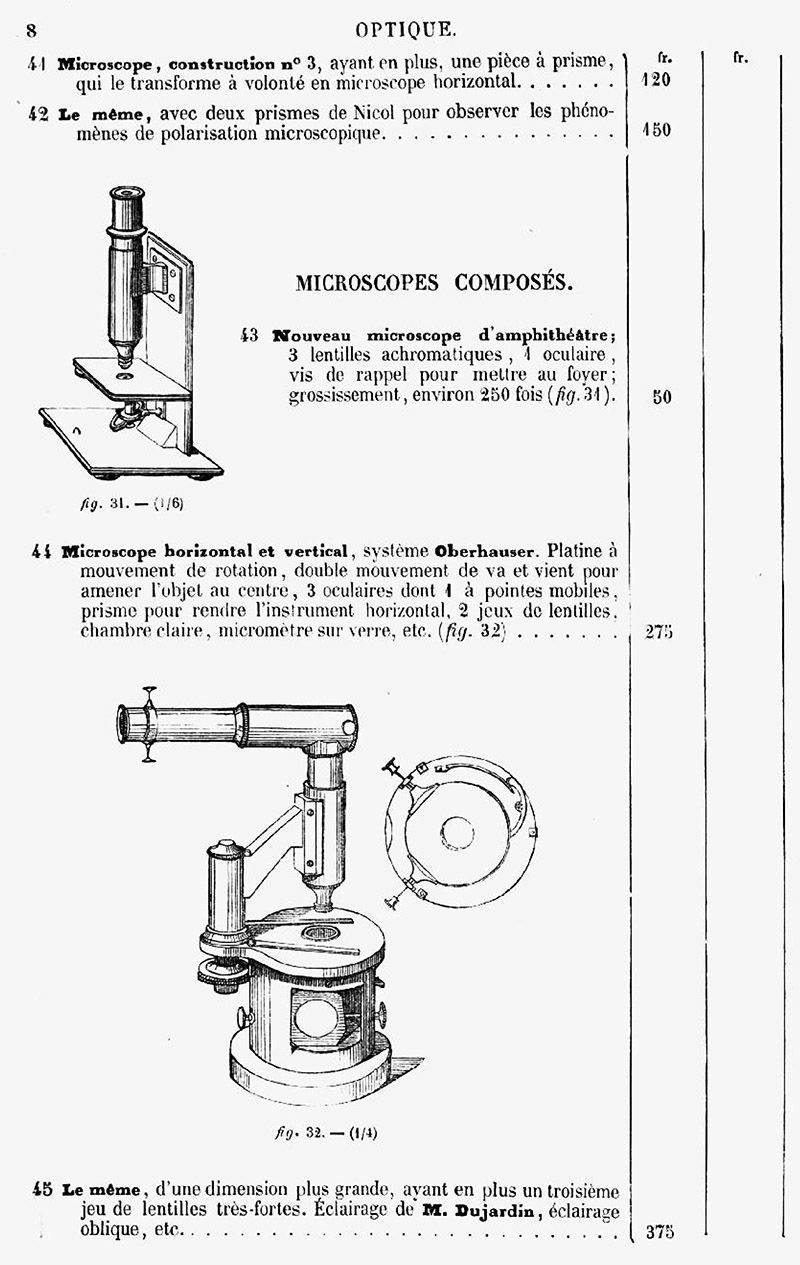
�
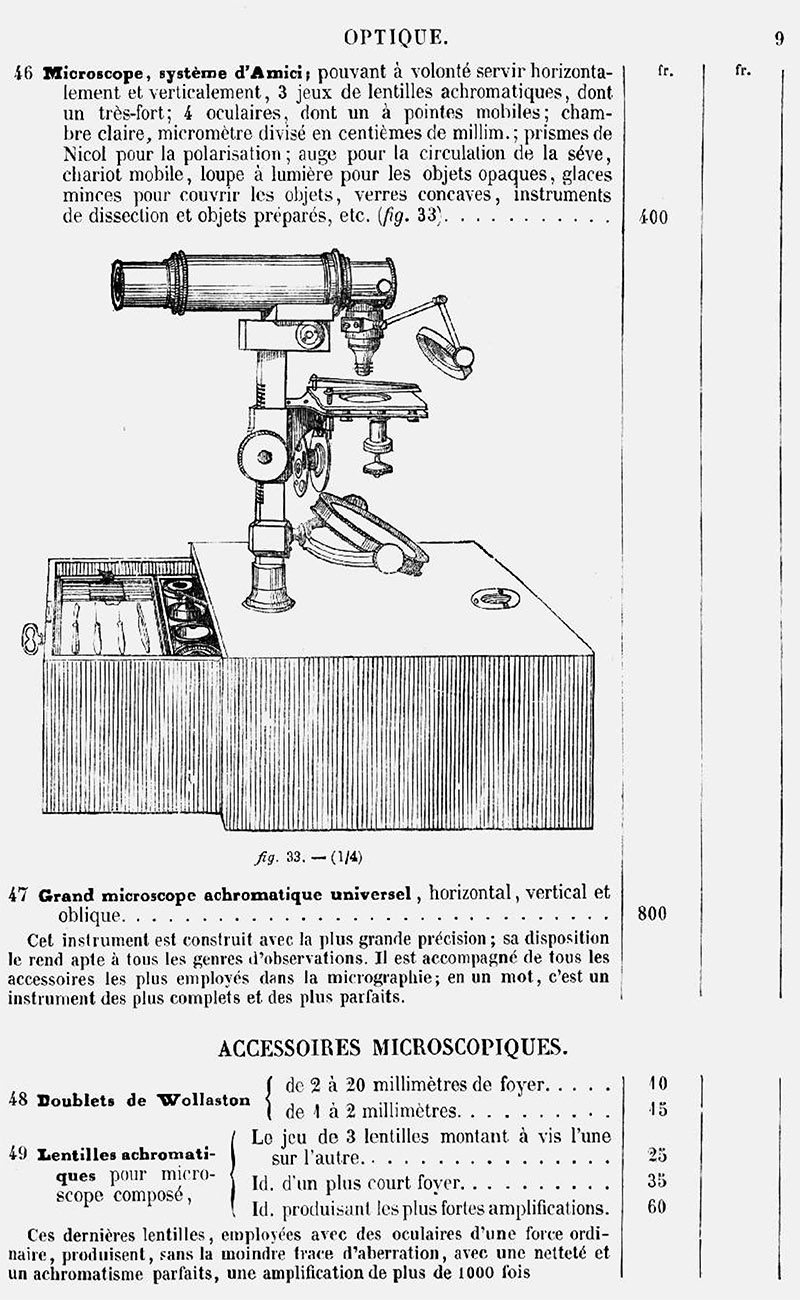
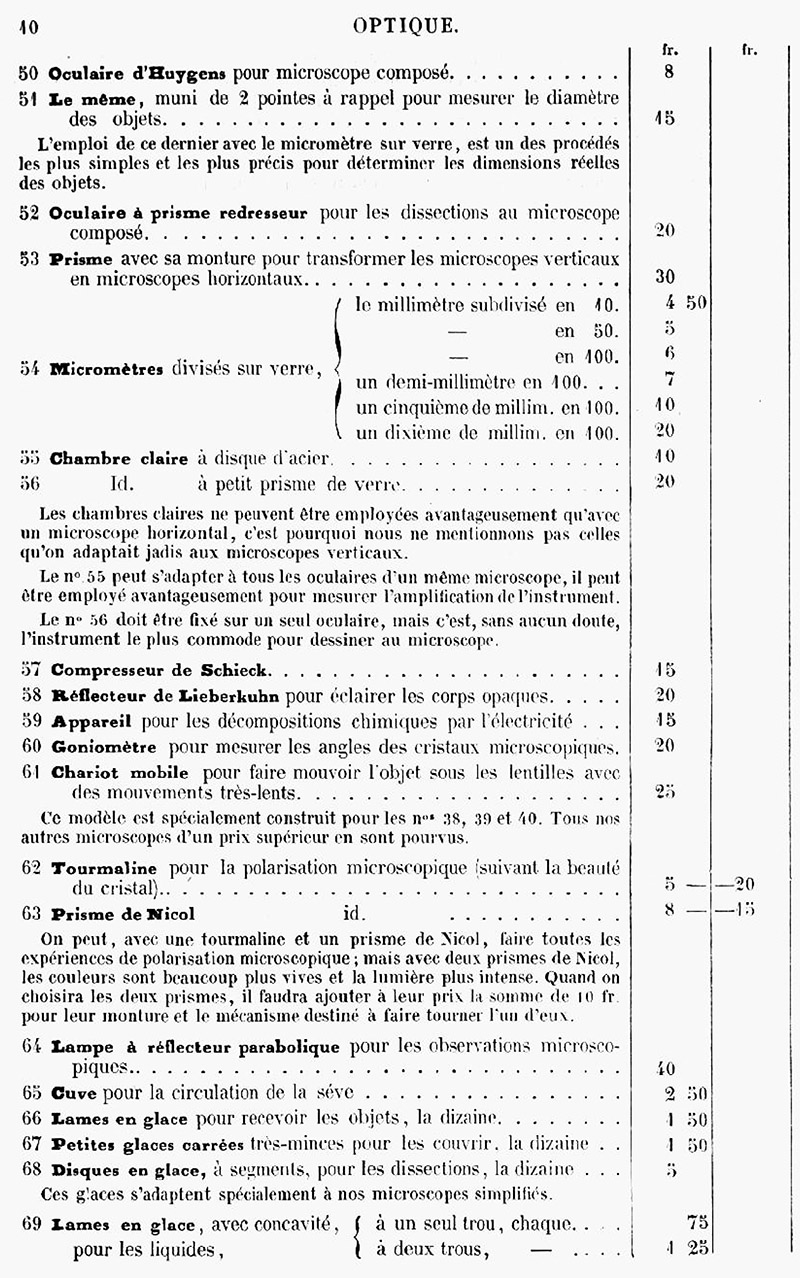
�
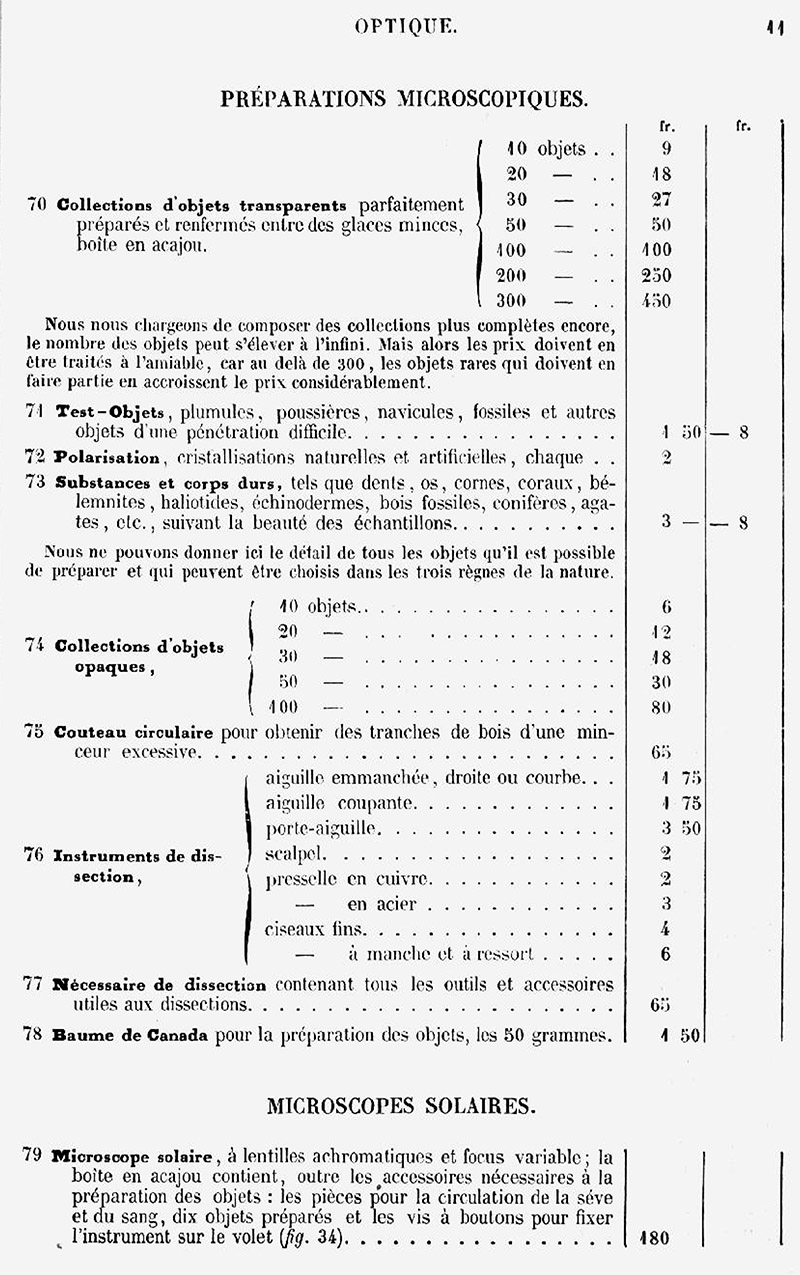
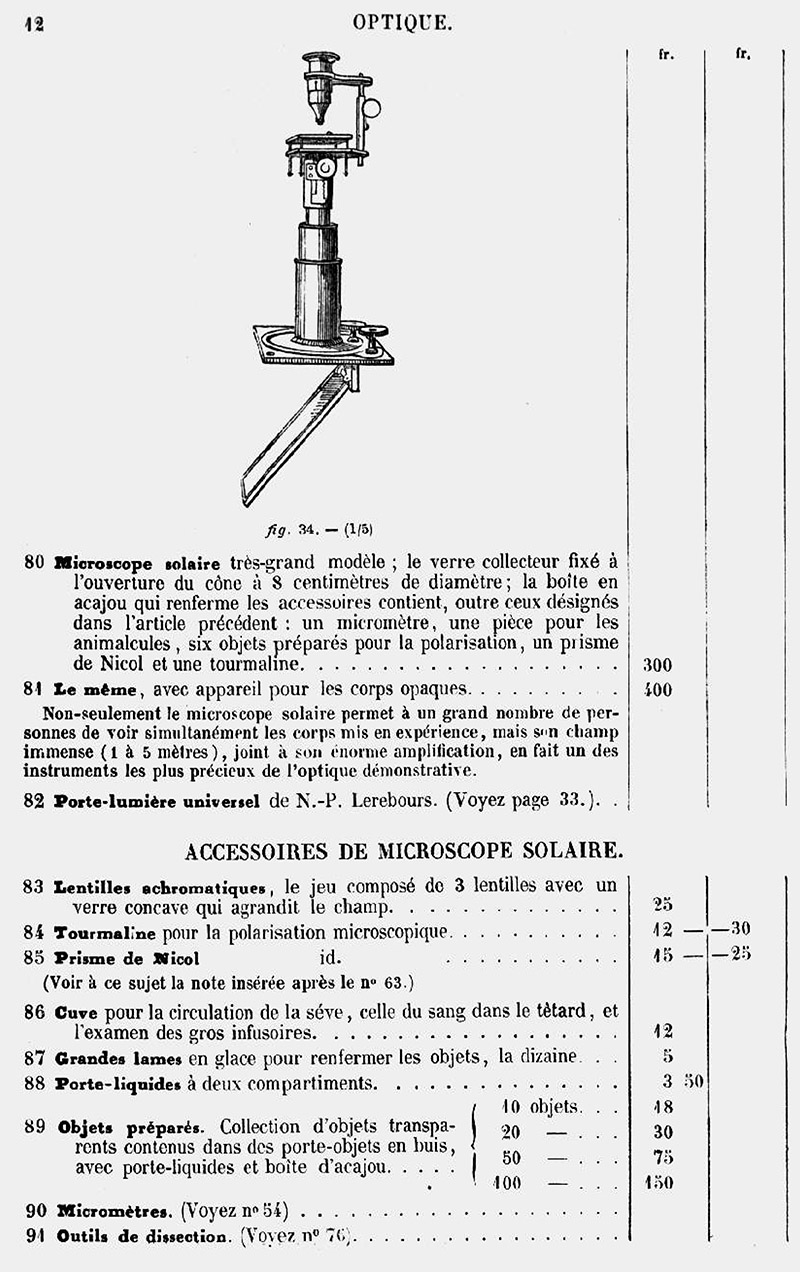
�
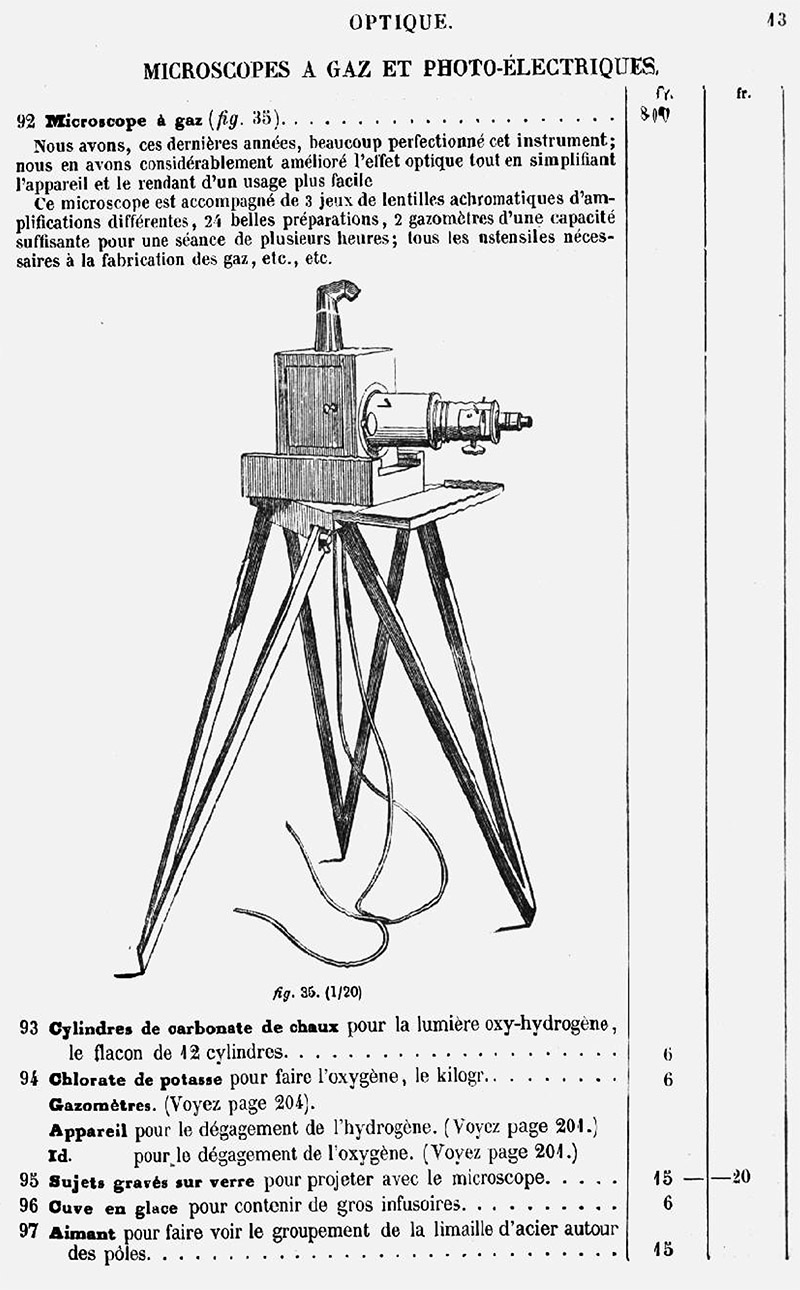
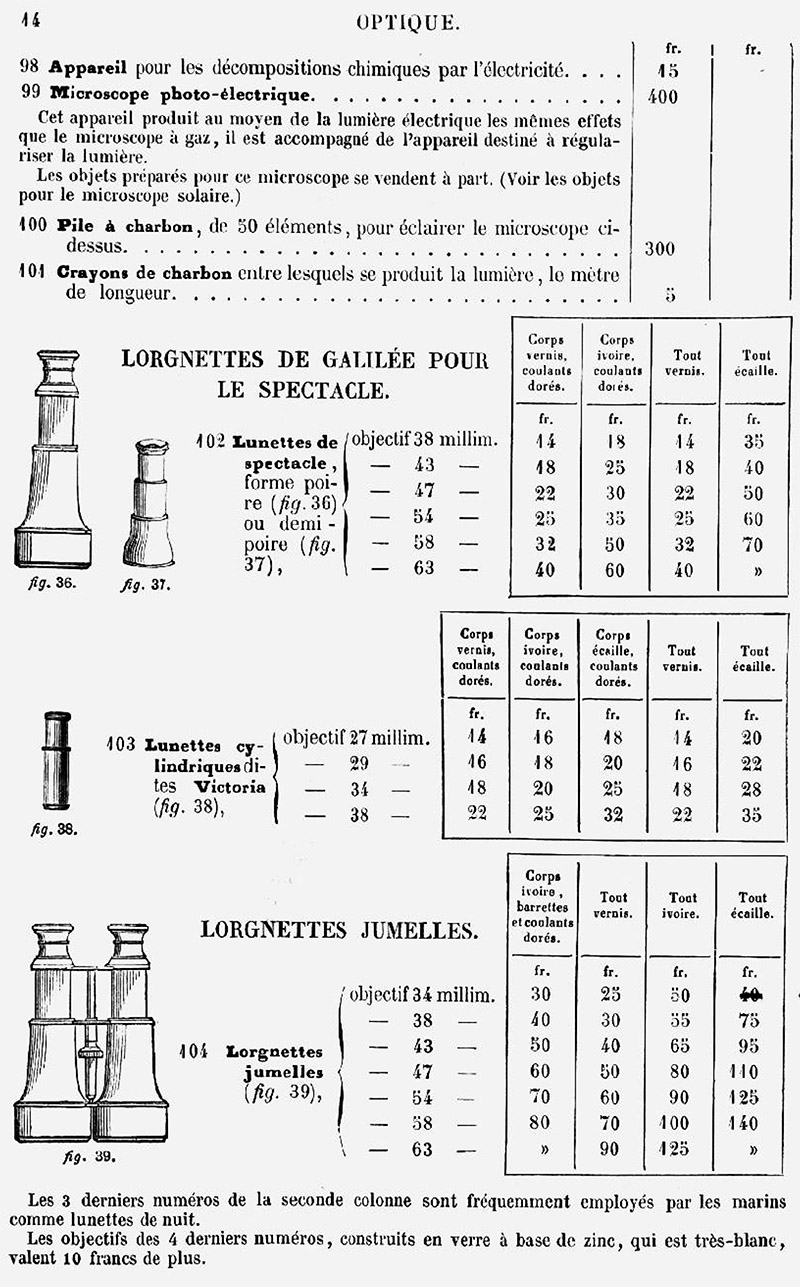
�
Figure 24.
Excerpts from Lerebours and Secrétan’s 1853 catalogue. This copy, from Google Books, was signed on the cover by Auguste Secrétan, the son and successor of Marc Secrétan.
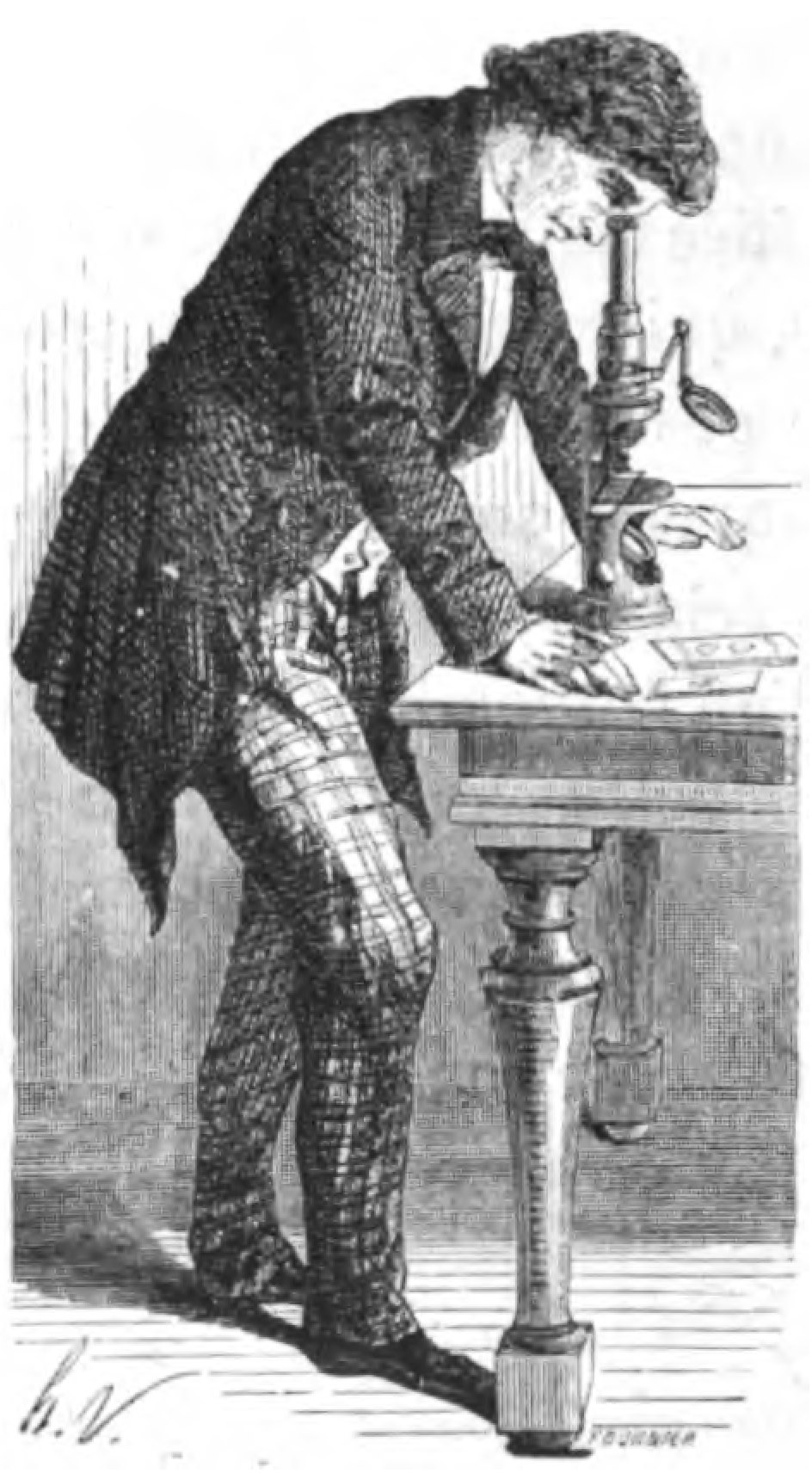
Figure 25.
An illustration of a Lerebours and/or Secrétan simple achromatic microscope (exaggerated in size), from Louis Figuier’s 1867 “Les Grandes inventions anciennes et modernes dans les sciences, l'industrie et les Arts”.
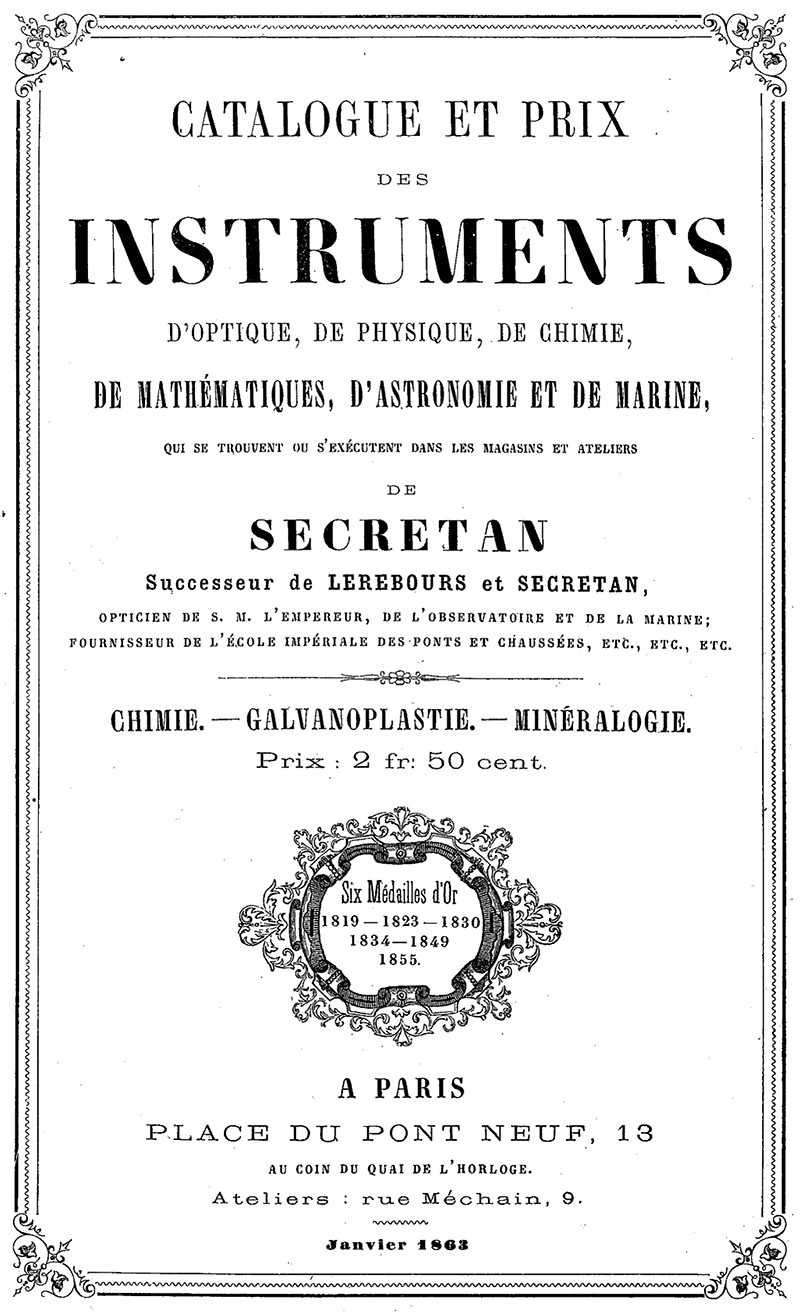
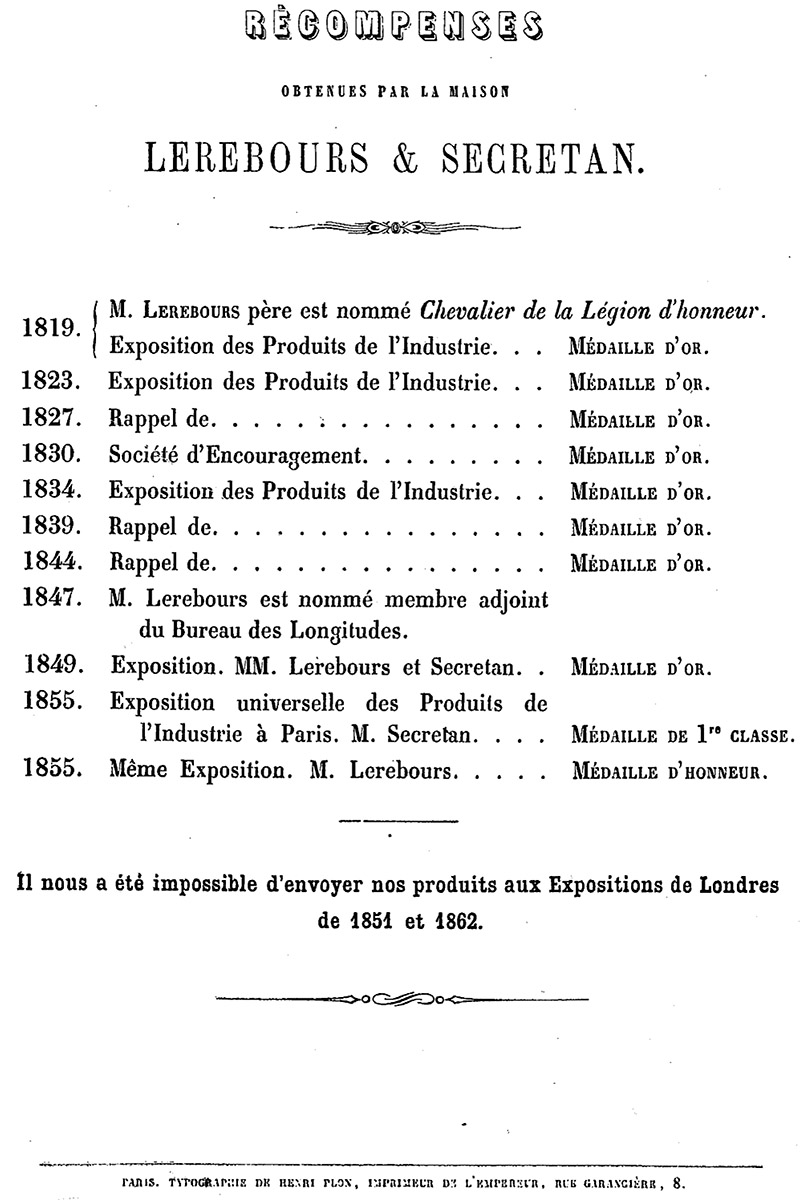
�
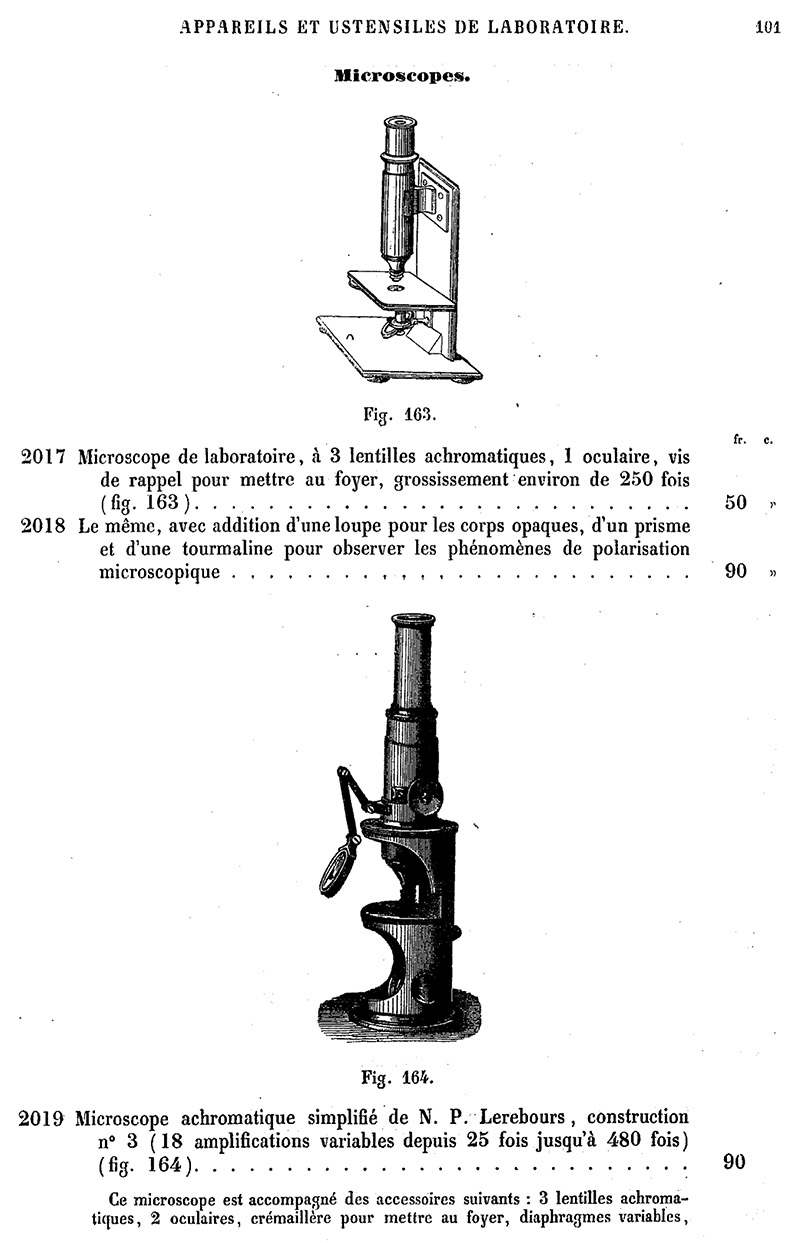
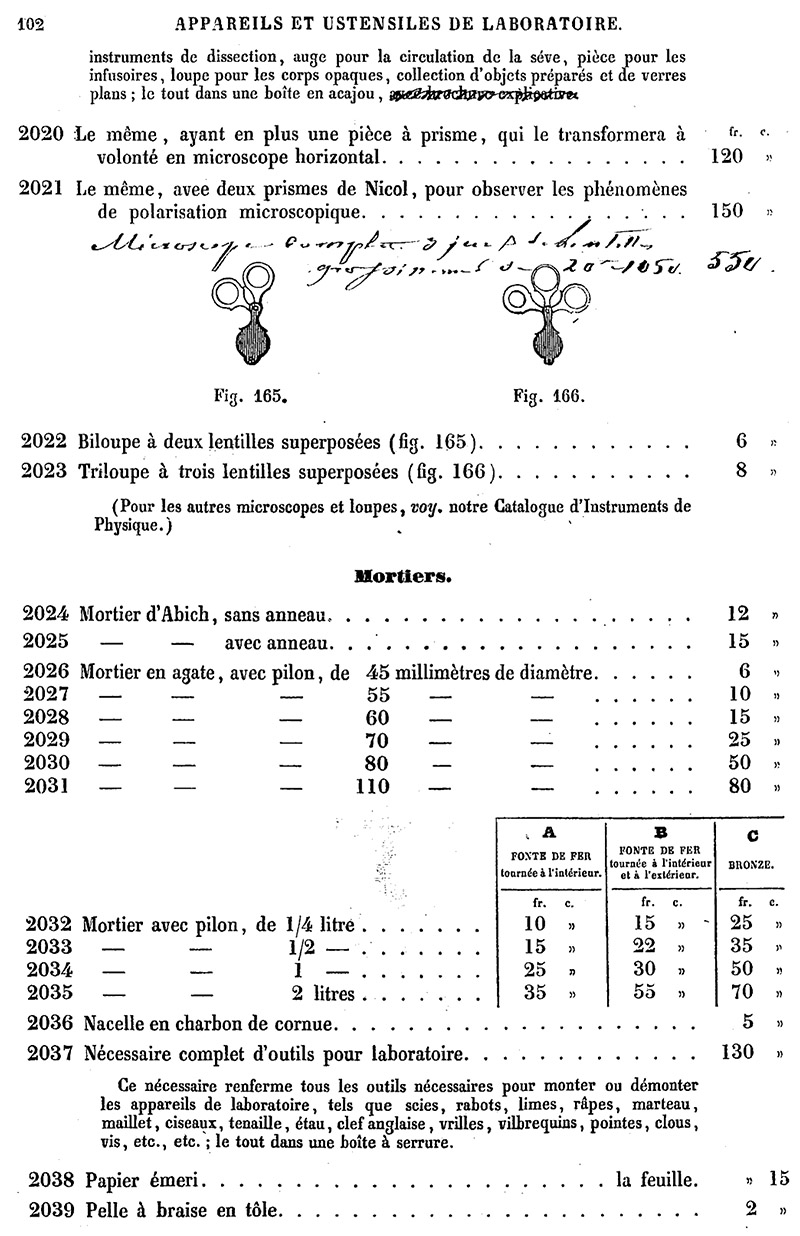
�
Figure 26.
�Excerpts from Marc Secrétan’s 1863 catalogue. This edition consisted primarily of chemistry and physics apparatus.
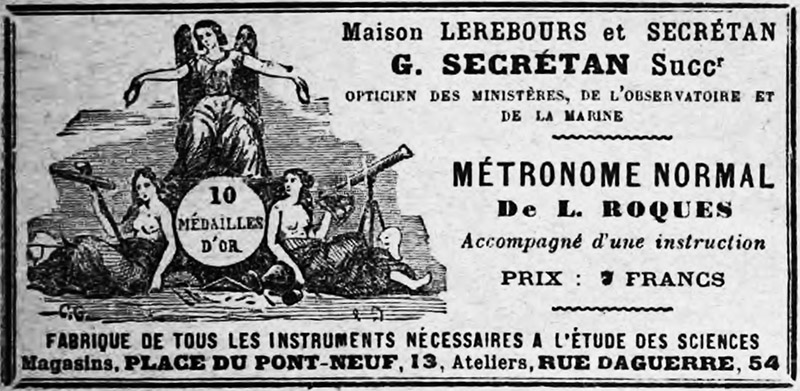
Figure 27.
An 1888 advertisement for Maison Lerebours et Secrétan, then under the ownership of Georges Secrétan. From “La Nature”.
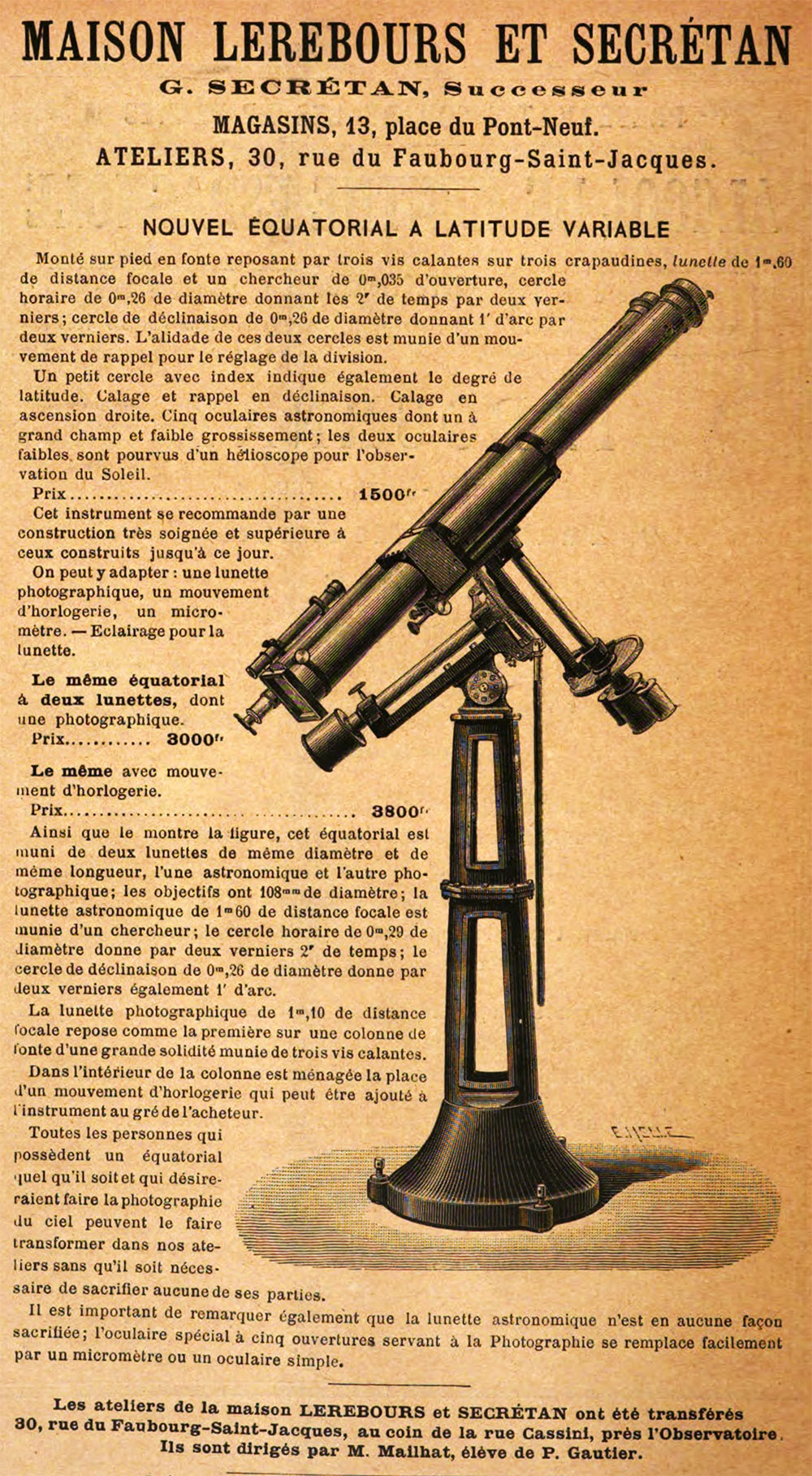
Figure 28.
An 1892 advertisement, from “l’Astronomie”.
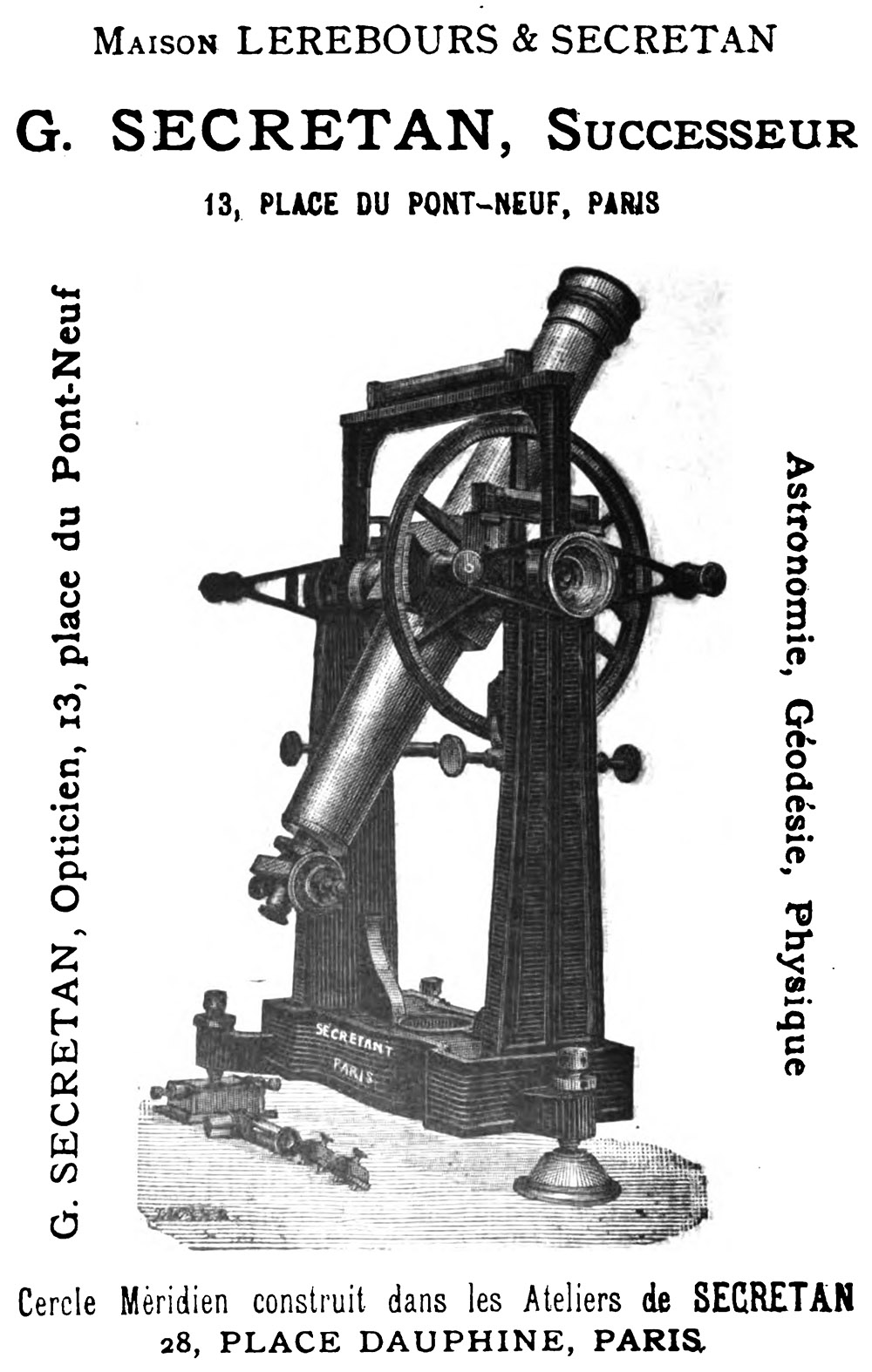
Figure 2.
A 1900 advertisement, from “Annuaire de Société Belge d'Astronomie”.
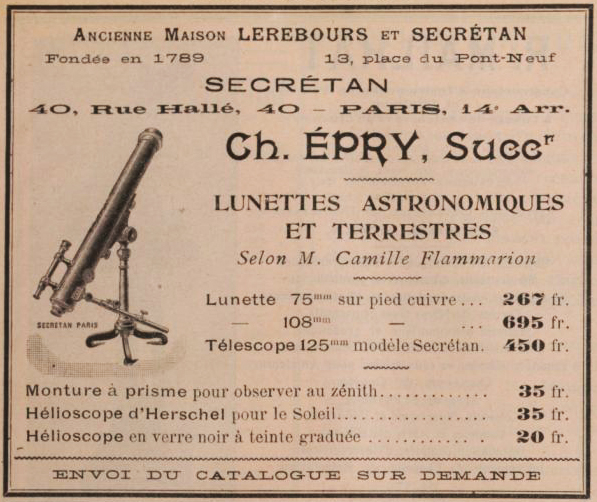
Figure 30.
A 1912 advertisement, after the Secrétan business had passed out of the family.
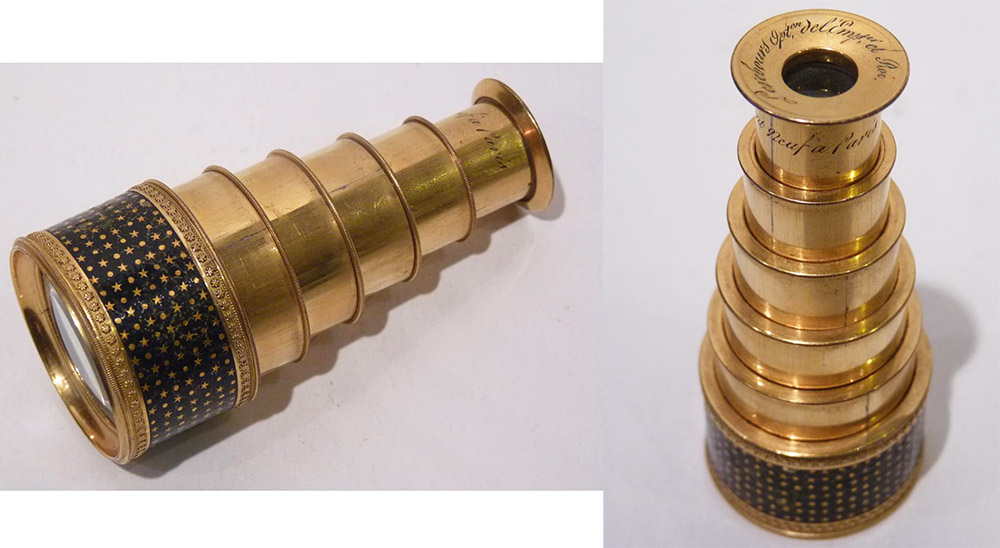
Figure 31.
A folding monocular opera glass. It is signed “Lerebours Optn. de l’Emper. et Roi”, dating it to after the 1815 restoration of the French monarchy. Adapted for nonprofit, educational purposes from an internet auction site.
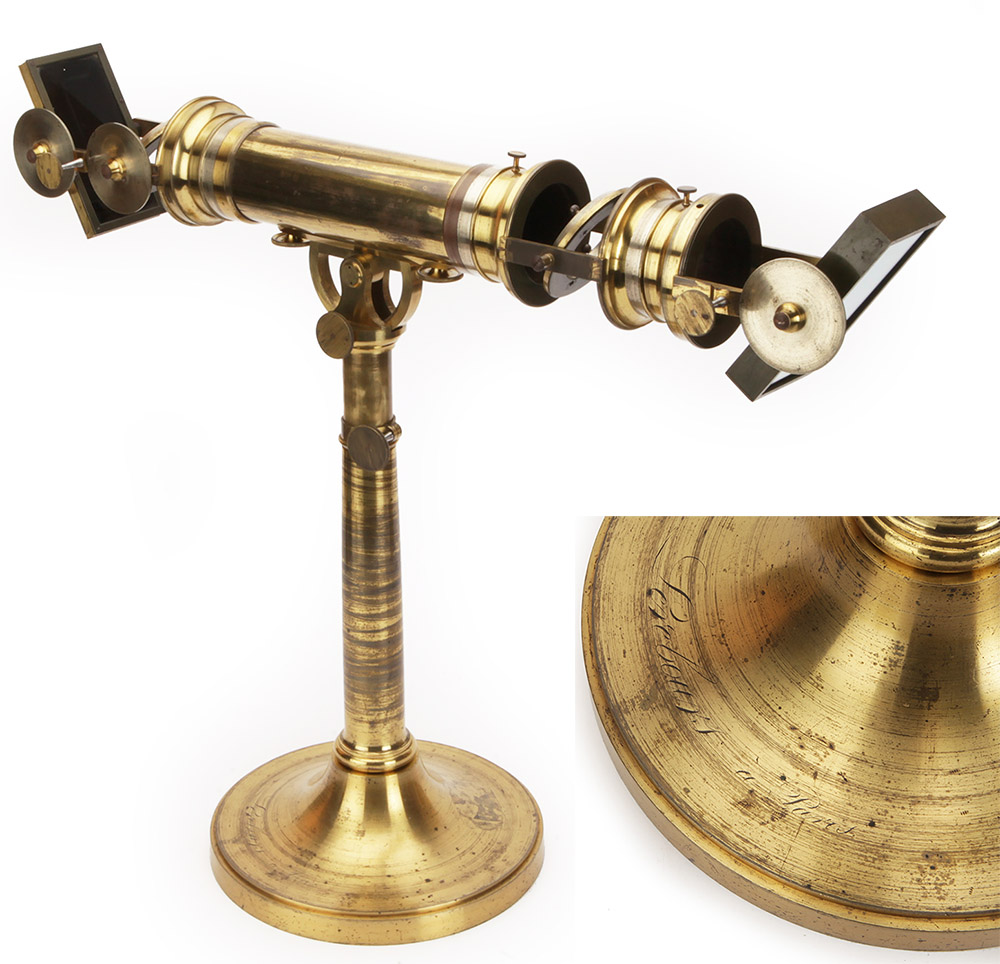
Figure 32.
Circa 1820 Biot’s polariscope, by N.-J. Lerebours. Adapted for nonprofit, educational purposes from an internet auction site.
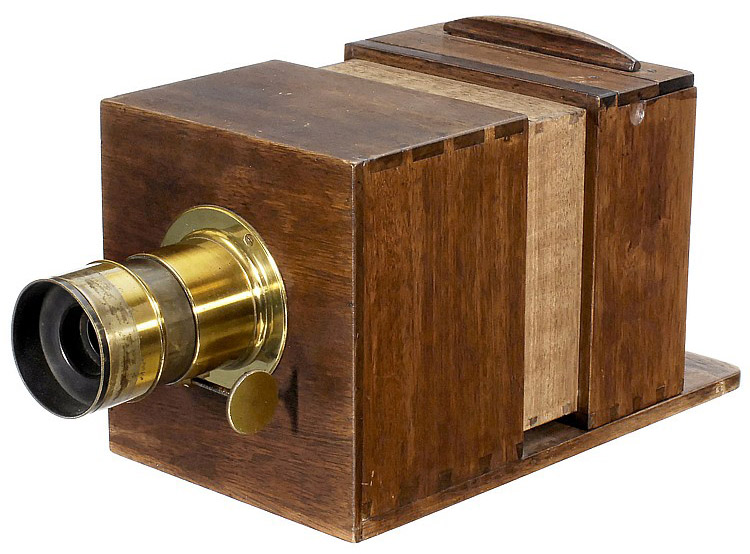
Figure 33.
Daguerreotype Camera with lens by Lerebours and Secretan. The camera was probably also produced by them. Adapted for nonprofit, educational purposes from an internet auction site.
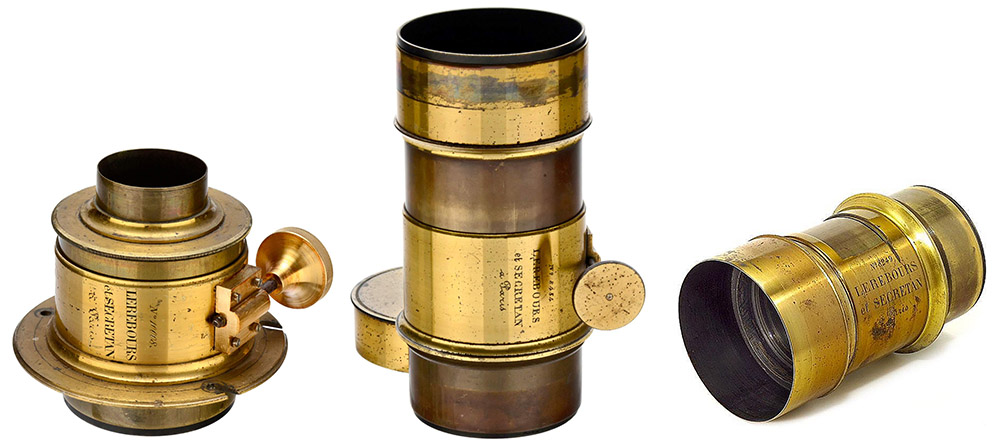
Figure 34.
Three camera lenses by Lerebours and Secretan. Adapted for nonprofit, educational purposes from internet auction sites.
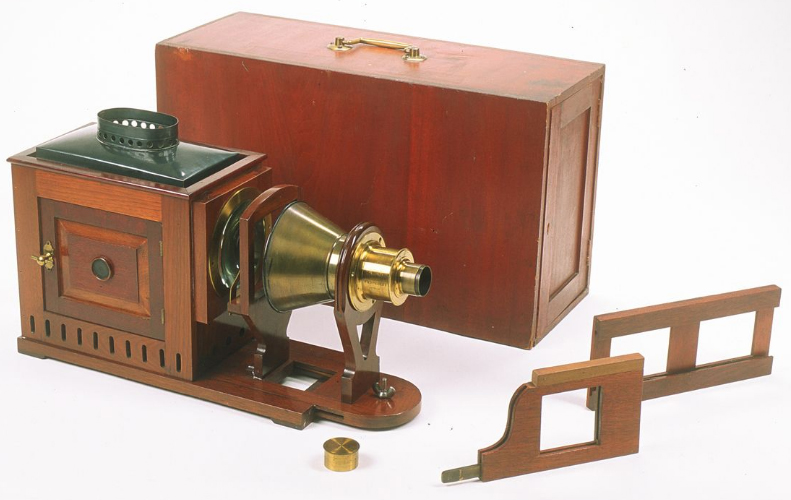
Figure 35.
Magic lantern projector by Lerebours and Secrétan. Adapted for nonprofit, educational purposes from http://waywiser.fas.harvard.edu/objects/3376/magic-lantern-slide-projector.
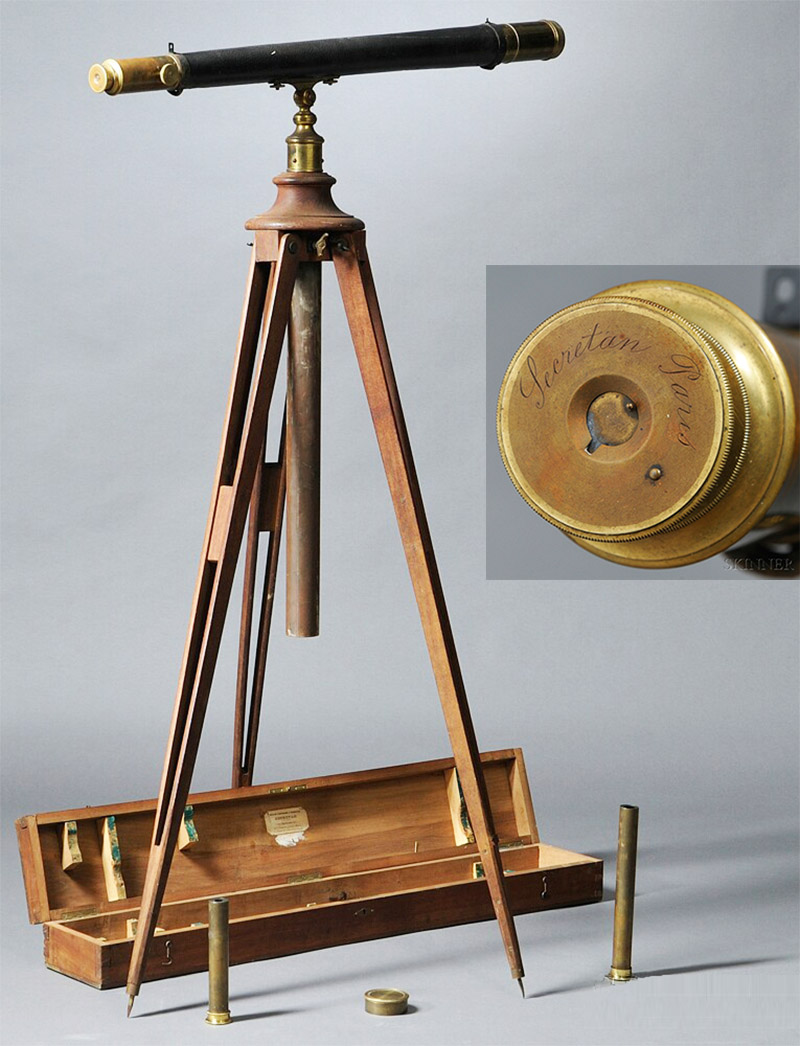
Figure 36.
Telescope signed “Secrétan”, produced circa 1854 - 1867. Adapted for nonprofit, educational purposes from an internet auction site.
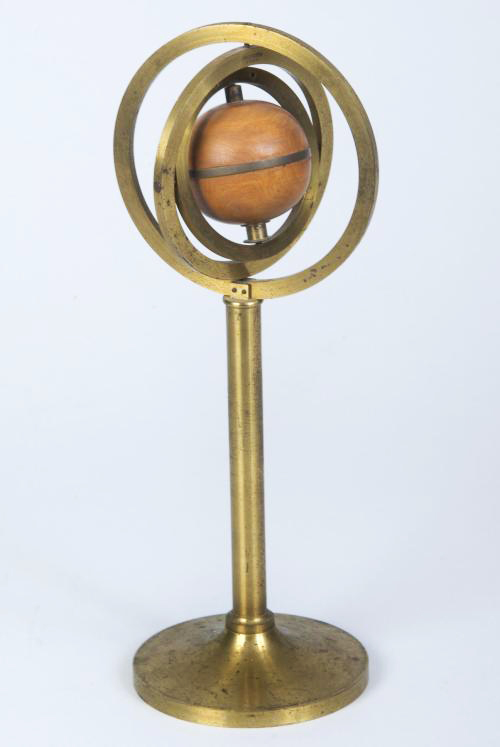
Figure 37.
Bohnenberger-type gyroscope by Secretan. Adapted for nonprofit, educational purposes from http://waywiser.fas.harvard.edu/objects/11454/bohnenbergertype-gyroscope.
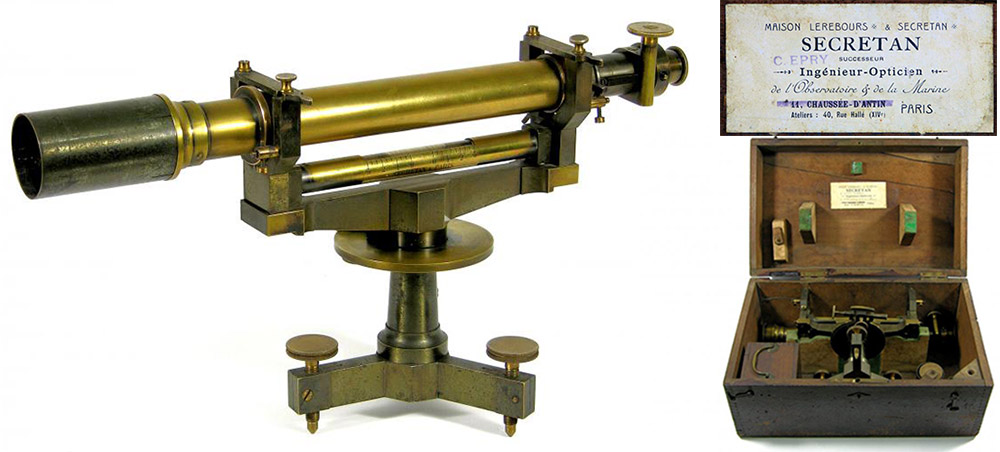
Figure 38.
A Maison Lerebours & Secrétan / Secrétan level, with a label showing that it was sold by Charles Epry (after 1906). Adapted for nonprofit, educational purposes from http://www.dehilster.info/geodetic_instruments/19th_century_secretan_egault_level.php.
Acknowledgements
Thank you to Allan Wissner and Albert Balasse for the use of images from their microscope collections.
Resources
Almanach du Commerce de Paris (1799 - ) accessed through https://gallica.bnf.fr
Annuaire pour l'an 1900 por le Société Belge d'Astronomie (1900) Advertisement from Maison Lerebours et Secrétan
Archives of France (accessed February, 2018) notaries’ and other legal records, accessed through https://www.siv.archives-nationales.culture.gouv.fr
l’Astronomie (1892) Advertisement from Maison Lerebours et Secrétan, Vol. 11
l’Astronomie (1912) Advertisement from Maison Lerebours et Secrétan
Biographie Universelle et Portative des Contemporains (1826) Lerebours (Noel-Jean), Vol. 2, pages 273-274
Biographie Universelle (1854) Lerebours, Noel-Jean, Vol. 24, pages 246-247
Birth record of Noel Paymal (1807) accessed through ancestry.com
Bulletin de la Société Astronomique de France (1906) Memoriam of Georges Secrétan, Vol. 20, pages 505-506
Le Constitutionnel (1851) Advertisement from Lerebours and Secrétan, December 22 issue
Contract of the marriage of Noel Paymal Lerebours and Renée Madeleine Colas (1850) “Contrat de mariage sous le régime de la communauté de biens entre Noël Marie Paymal Lerebours, opticien, demeurant 13, place du Pont-Neuf, et Renée Madeleine Colas, veuve de Louis Étienne Remiot, demeurant 47, rue Vivienne. À signaler : le futur apporte en mariage la moitié de ses droits dans une société créée par acte sous seing privé le 15 février 1845 entre lui-même et Marie François Louis dit Marc Secrétan pour la fabrication et le commerce d'instruments d'optique située 13, place du Pont-Neuf. Cette société est estimée, à la date du mariage, à 220 000 francs. À signaler: mairie du mariage civil non précisée”, accessed through https://www.siv.archives-nationales.culture.gouv.fr
Davanne, A., Maurice Bucquet, and Leon Vidal (1903) Photograph of N.P. Lerebours, Le Musée Rétrospectif de la Photographie à l'Exposition Universelle de 1900, Gauthier-Villars, Paris, page 20
Dictionnaire Encyclopédique et Biographique de des Arts l'Industriels (1888) Secretan, Marc-Louis-Francois, Vol. 8, pages 153-154
l’Emulation (1836) Notice of the name change of Noel Paymal, July issue
Figuier, Louis (1867) Les Grandes Inventions Anciennes et Modernes dans les Sciences, l'Industrie et les Arts, page 156, Paris
Foucaud, Edouard (1841) Les Artisans Illustres, pages 540-545
l’Illustration (1847) Advertisement from Lerebours and Secrétan, Vol. 9, page 417
Journal de Paris (1804) Real estate advertisement from Noel-Jean Lerebours, June 18 issue, advertising pages
Lerebours, Noel-Jean (1805) Instruction Sur la Manière de Nettoyer les Verres de Lunettes, Paris
Lerebours, Noel Paymal (ca. 1841) Description des Microscopes Achromatiques Simplifies, Second edition, Paris
Lerebours, Noel Paymal (1840-42) Excursions Daguerriennes, Paris
Lerebours, Noel Paymal (1843) Traite de Photographie, Paris
Lerebours, Noel Paymal (1843) A Treatise in Photography, Translated by J. Egerton, London
Lerebours, Noel Paymal (1843) Traite de Galvanoplastie, Paris
Lerebours, Noel Paymal (1846) Instruction Pratique Sur Les Microscopes, Contenant La Description Des Microscopes Achromatiques Simplifies, Paris
Lerebours, Noel Paymal (1847) Des Papiers Photographiques, Paris
La Nature (1888) Advertisement from Maison Lerebours et Secrétan
Notice des Produits de l'Industrie Française (1834) M. Lerebours, pages 104-106
Rapport du Jury Central sur les Produits de l'Industrie Française (1836) pages 250-251
Settlement of the estate of Marie Marthe Legay Lerebours (1829) “Inventaire après décès de Marie Marthe Legay dressé entre le 16 juillet et le 13 octobre 1829, dans sa maison située 13, place du Pont-Neuf, où la défunte est morte, le 19 juin 1829, à la requête de son mari, Jean Noël Lerebours, opticien du roi, demeurant même adresse, légataire universel suivant testament des 16 juin 1814 et 1er mars 1824, et Noël Marie Lerebours, autre légataire universel en nue propriété seulement pendant la vie dudit Jean Noël Lerebours”, accessed through https://www.siv.archives-nationales.culture.gouv.fr
Settlement of the estate of Noel-Jean Lerebours (1840) accessed through https://www.siv.archives-nationales.culture.gouv.fr
Settlement of the estate of Marc Secrétan (1867) accessed through https://www.siv.archives-nationales.culture.gouv.fr
Settlement of the estate of Noel Paymal Lerebours (1873) accessed through https://www.siv.archives-nationales.culture.gouv.fr






















































































